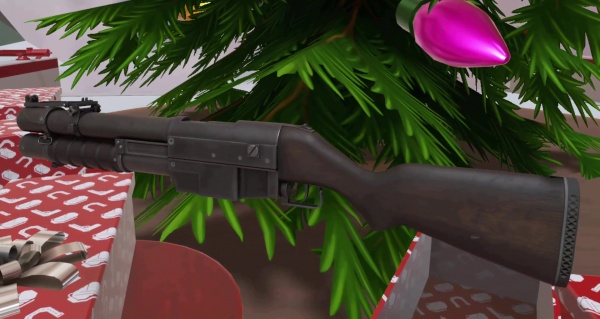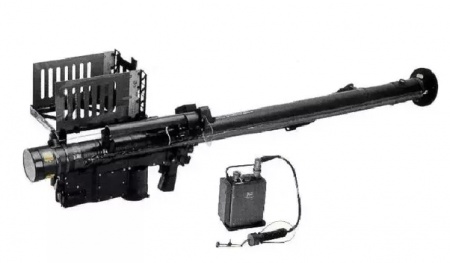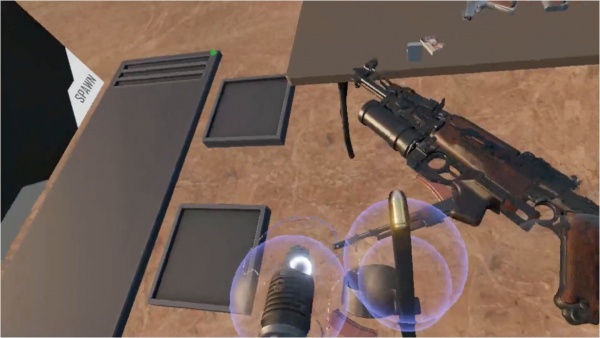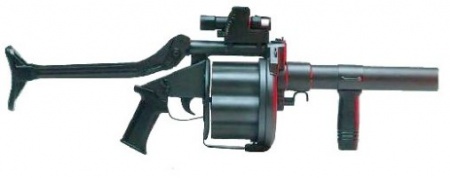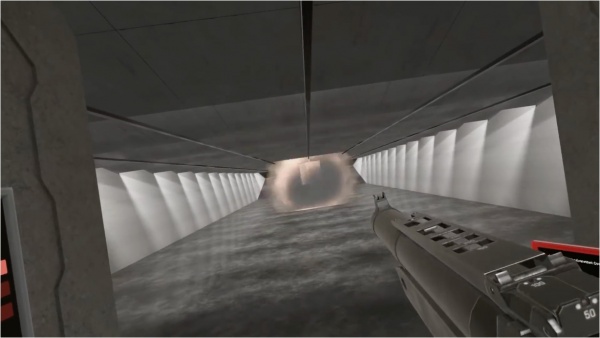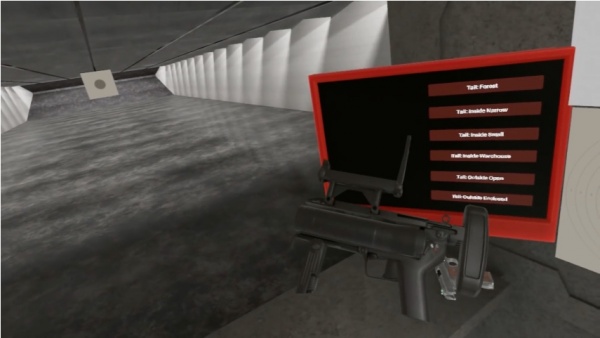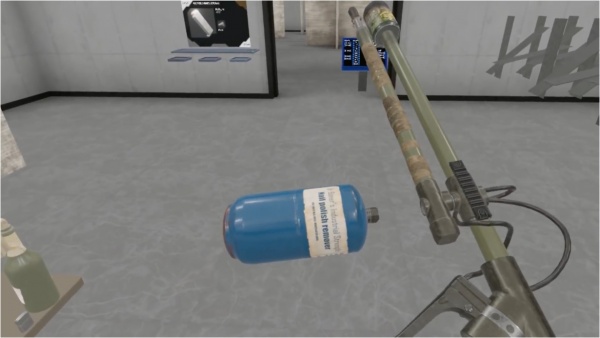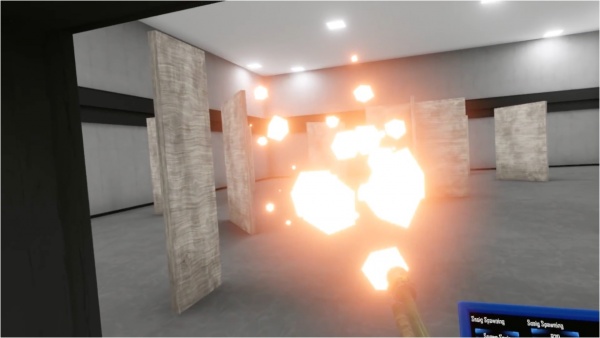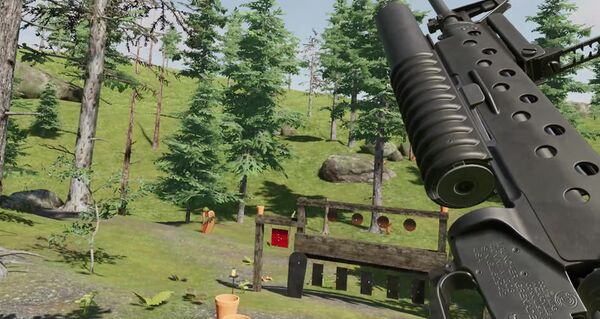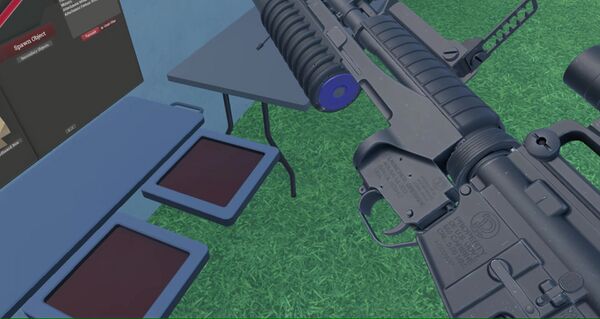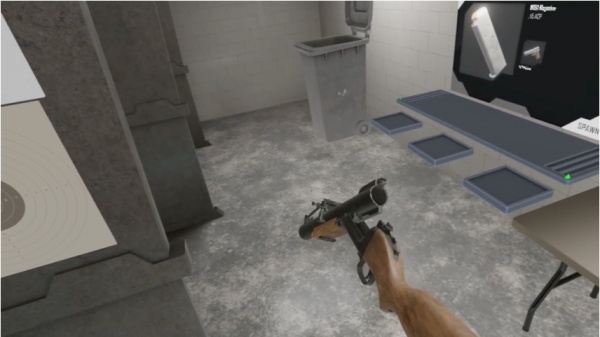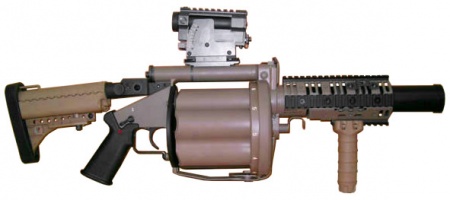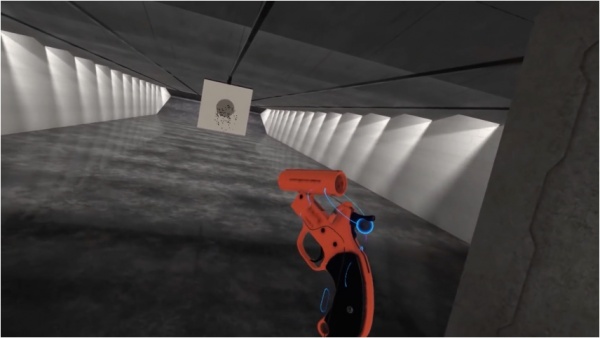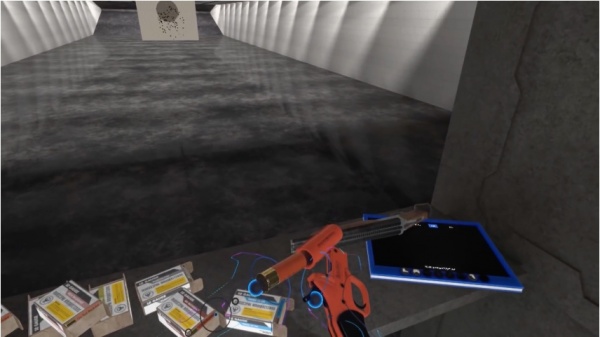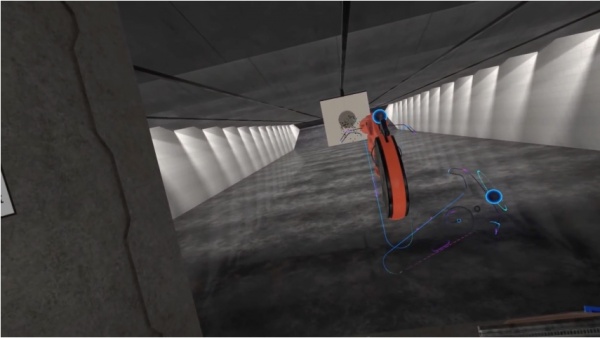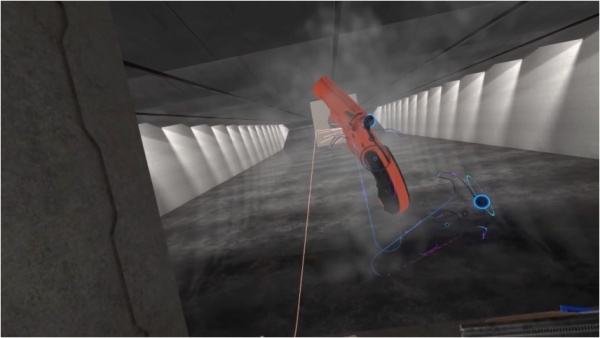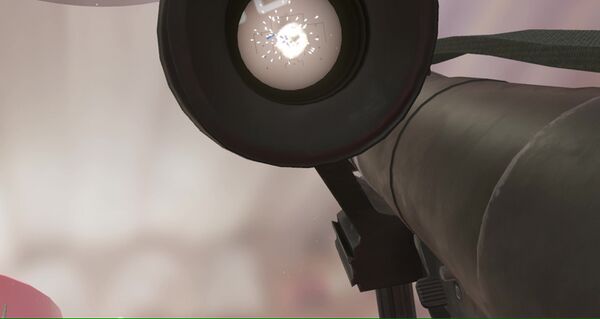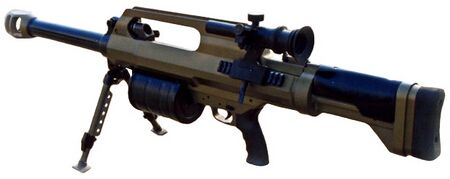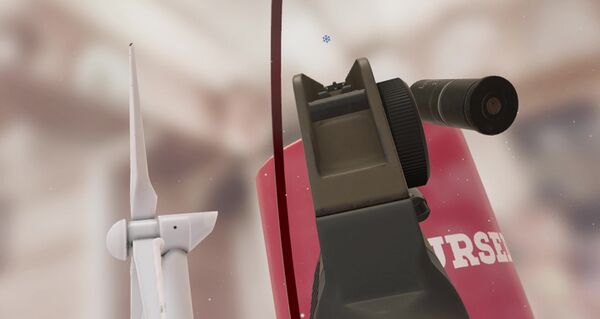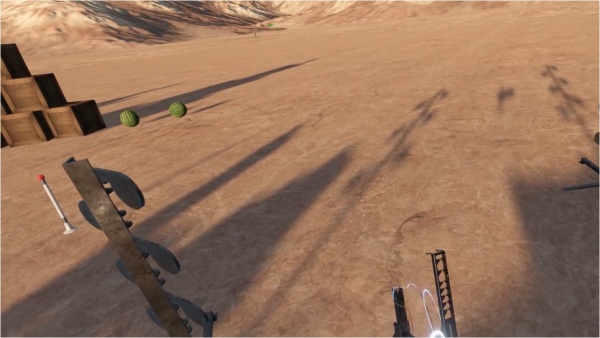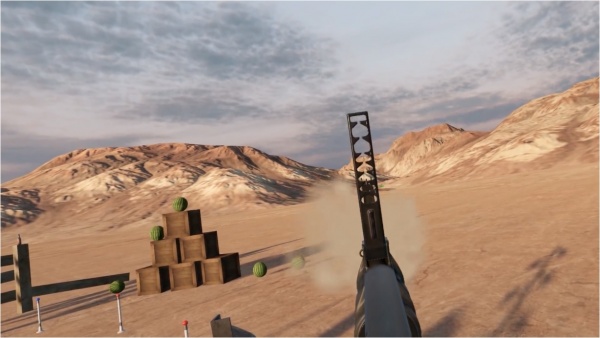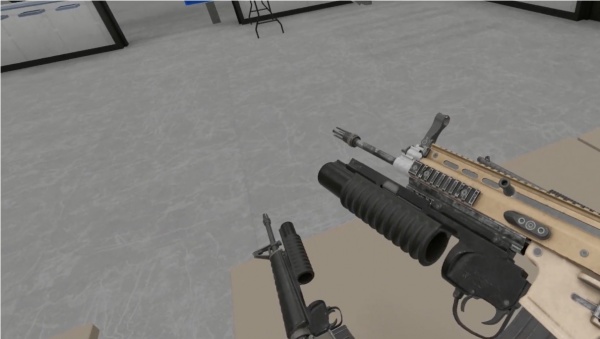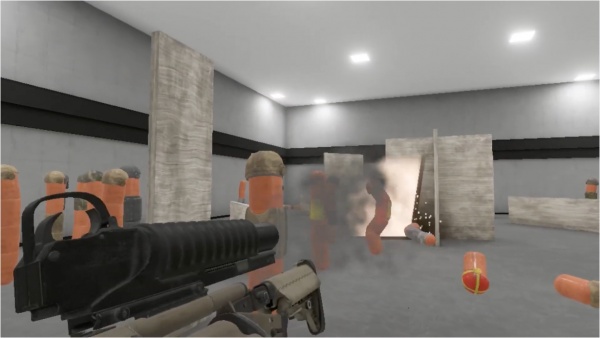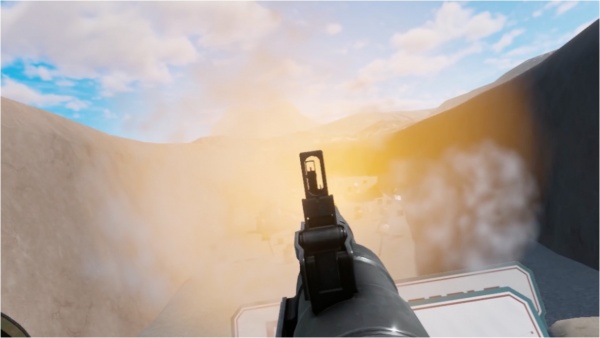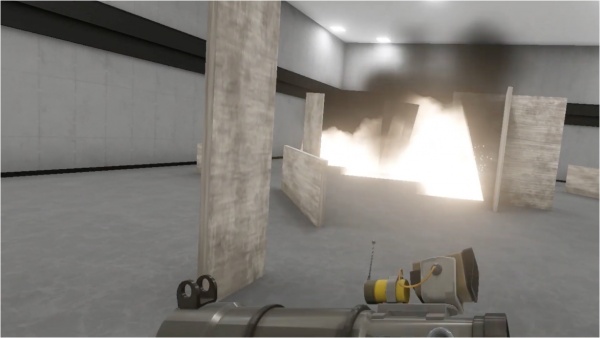Launchers
Referred to as "Ordnance" in-game, these weapons occupy the "Support" group alongside machine guns and thrown explosives. The exception are the flamethrowers; one is only attainable in certain special scenes, and the other is in the "Meat Fort" category. This category also includes the "Kolibri9001" in-game, though it is placed on the pistol sub-page due to it being based on one.
Carl Gustaf M2
A much-requested addition, Carl Gustaf M2 was the largest gift added on Meatmas Day 2022. It is the game's first recoilless rifle, and features a wide variety of ammunition types to choose from.
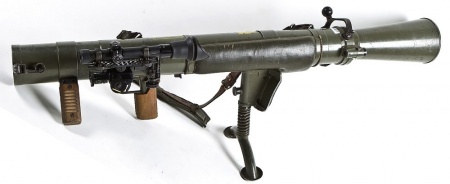
Carl Gustaf M2 - 84x246mmR
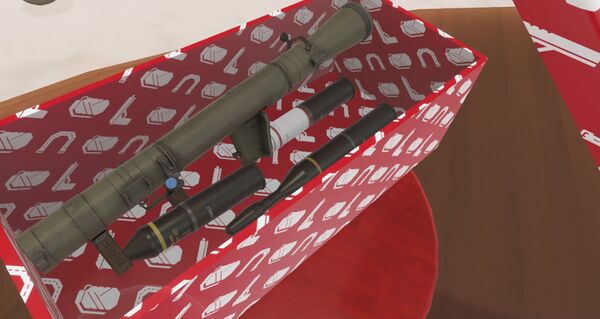
For those that saved the biggest box for last, the results are certainly not disappointing. Left to right, the rounds visible here are HEDP 502 (
High-
Explosive
Dual
Purpose, denoting a shaped-charge explosive capable of generating fragments, for both anti-personnel and anti-armor use), HEAT 751 (
High-
Explosive
Anti
Tank, a tandem-warhead shaped-charge round meant for defeating slat and/or explosive reactive armor), and ILLUM 545C (short for "illumination" - this one's discussed more below).
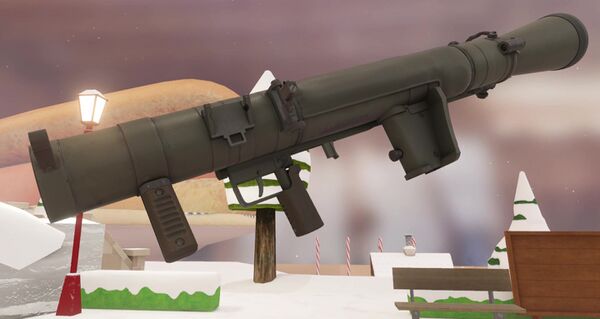
Examining the big green tube in all its glory.
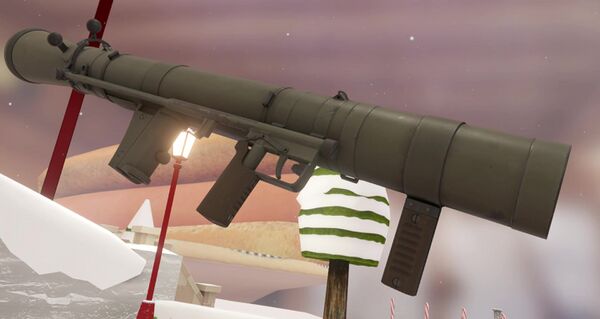
Takes a bit of effort to fit it in the frame, but it can be done.
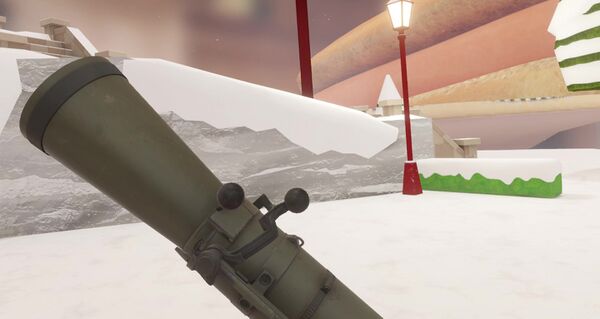
Operating the weapon is a unique process, as far as
H3's weapons are concerned - first, pull down on this lever to unlock the rear venturi tube...

...and then use the knob above it to open said tube.
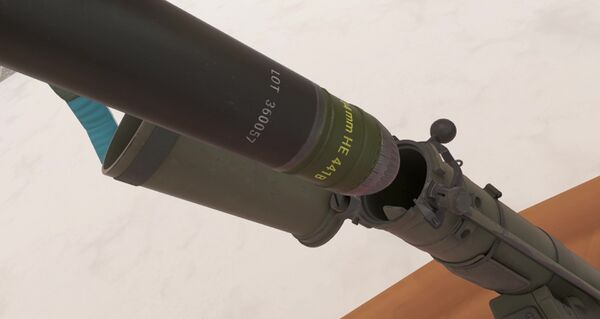
With the launcher open, a round can be inserted - this one's the fourth of five total types, HE 441B (a simple high-explosive round).
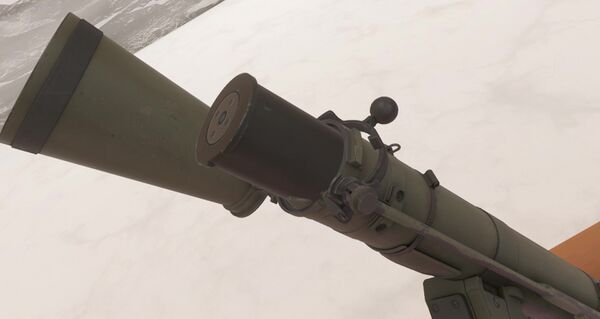
It doesn't just go in on its own, though - once lined up, it has to be manually slid into place.
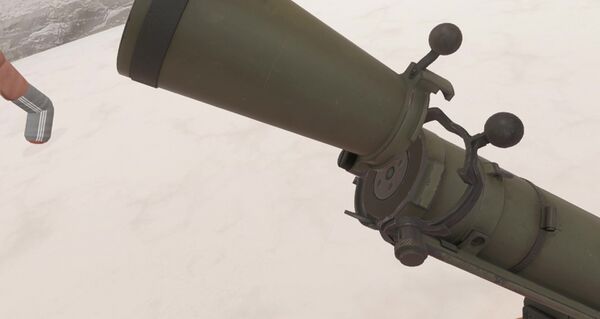
Once it's in, simply repeat the first two steps in reverse. If you want to see what locking it looks like, look at the image 4 above this one, and convince yourself that the lever's going up instead of down.
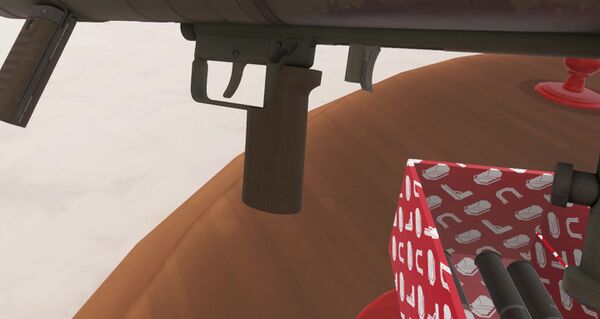
Finally, cock the striker - contrary to what one might expect, this starts out all the way back, and has to be pushed forward.

Lining up the aperture-and-post irons, hoping to free the Snowglobe from the Giant Weiner's reign of terror once and for all.

>buy recoilless rifle
>look inside
>recoil 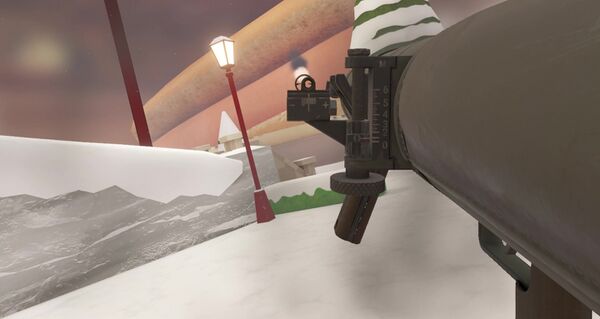
Sadly, an 84mm HE round proves no match for the Weiner's magical force-field.

Yanking out the spent case, a process rather similar to the insertion of a live round (minus the obvious difference in direction); the green round in the box is the fifth and final ammo type, SMOKE 469C (which does exactly what you'd expect - unlike "HEAT", "SMOKE" doesn't stand for anything, and is written in all-caps for seemingly no reason).

Taking out frustration over the indifferent cruelty of the Weiner on a nearby Sosig, for reasons that are entirely related to it being the closest thing that'd respond, and not at all because of any resemblance between it and the Weiner. This isn't a hate crime, I swear.
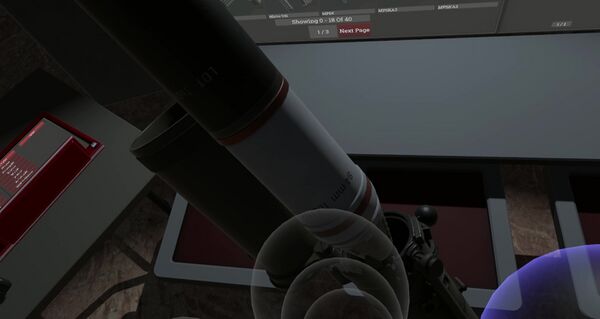
Having escaped to somewhere beyond the reach of giant tubes of processed meat and the sun alike, it's time to make good on that promise from the first image, and explain the wonder that is the ILLUM 545C round.
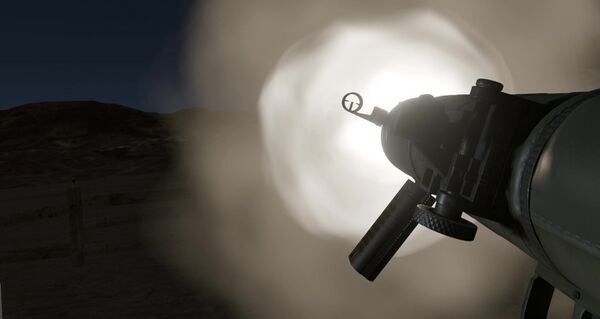
As can be seen here, it makes quite a bit of light when you -
"Wait, what? That's not how it works?"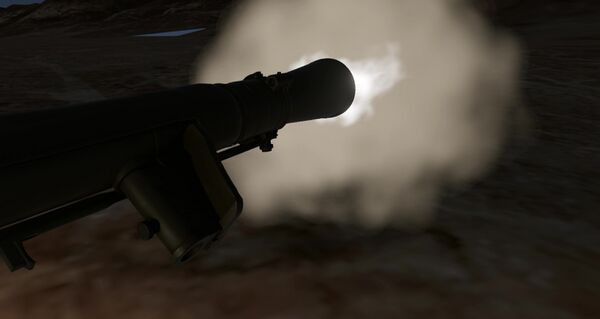
*Ahem* Right, so when you fire it, it produces a fairly substantial amount of light from -
"Really? Not that either?"
"Oh, the round itself. Why didn't you say so?"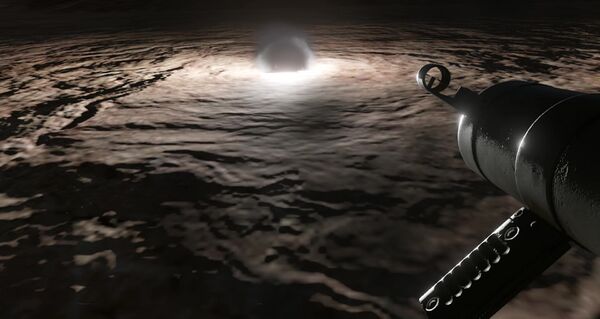
Anyway, so as I was saying, it makes a decently large flash of light on impact with -
"Oh, for crying out loud, just tell me already."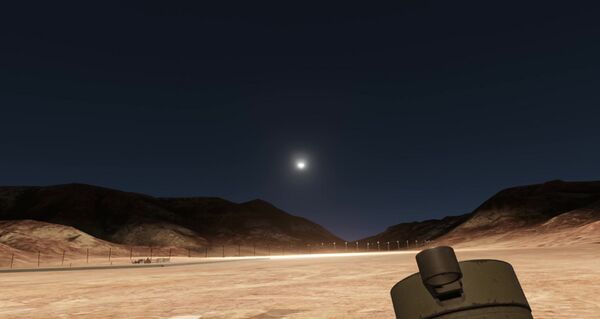
So, as you can see here, the round produces its intended quantity of light when fired up into the air. It's a giant parachute flare. Useful for making like Nelson Rangell and turning night into day.

Oh, and for those unfamiliar, "parachute flare" is a completely literal expression - it hangs in the air longer that way. A close inspection (after it burns out, but before it hits the ground and explodes like the shot two above this one) reveals that cars, jets, and recoilless rifle ammunition are apparently produced in
H3's world by the sausage-logoed company "SOAB".
China Lake Launcher
The final present introduced in the 2019 Meatmas update was a long-requested one, the China Lake Launcher.

China Lake Launcher - 40x46mm
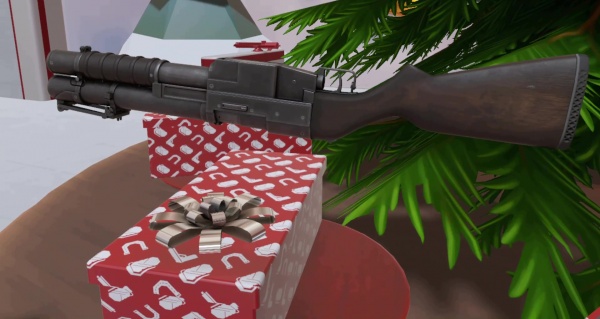
It's a 1.19-gauge shotgun!
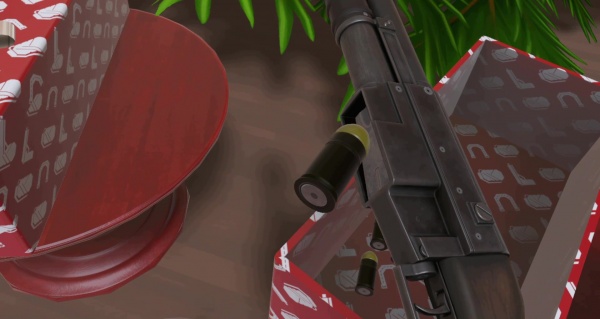
Load౹ng in some shells - three, to be exact. Or four, if you put an extra one in the chamber. Which you really probably should.
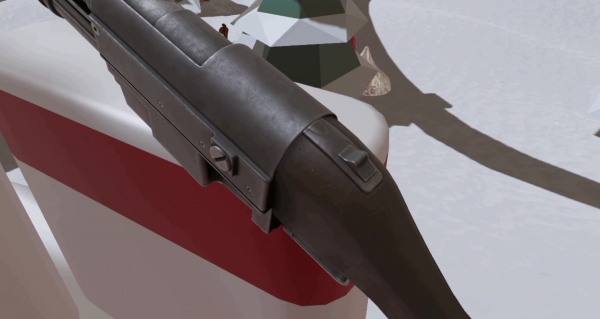
If said extra one doesn't go off when you pull the trigger, try checking this little switch at the front of the stock.
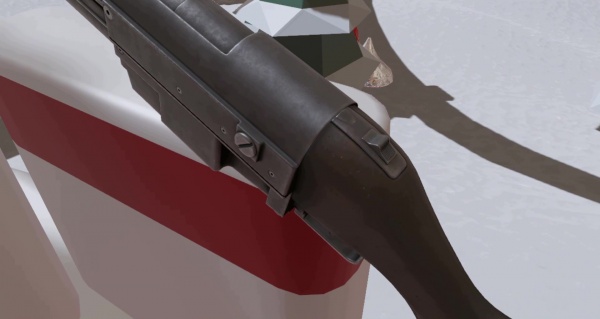
It has to be pushed forward to work. Yeah, I know, but the lawyers insisted - something about "legal liabilities" and "dismemberment lawsuits".
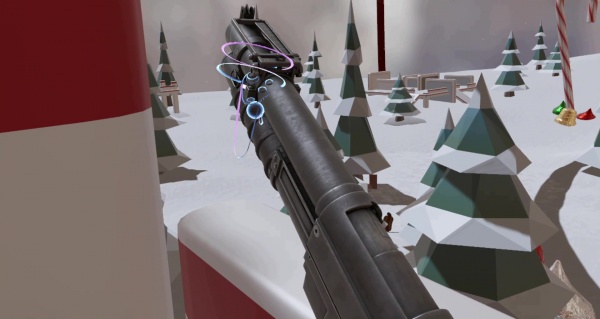
Like the
M79 it sorta supplemented, the China Lake has a leaf-type rear sight for long-range shooting.
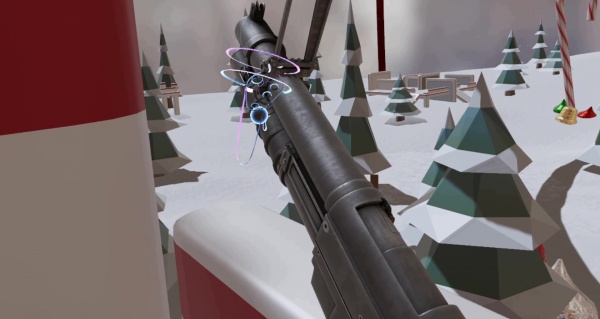
Just hover over it, click the trigger, and BAM! A whole lotta markings that you probably can't squint hard enough at to read.
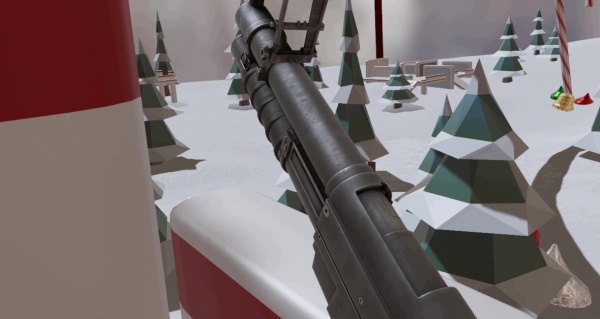
As such, the adjustability of the rear sight is best used in combination with a fair bit of trial and error.
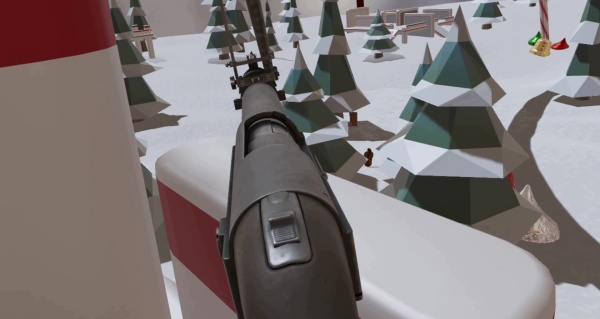
Once you've decided/guessed which range to set the rear sight to (presumably the one corresponding to your distance from your target), take aim...
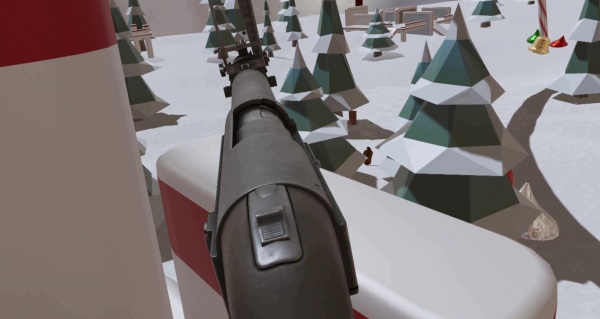
...lob the dot off of an "i" somewhere else in this section...

...and watch the round it its mark. Unless you're still busy looking for the dotless "i", of course.
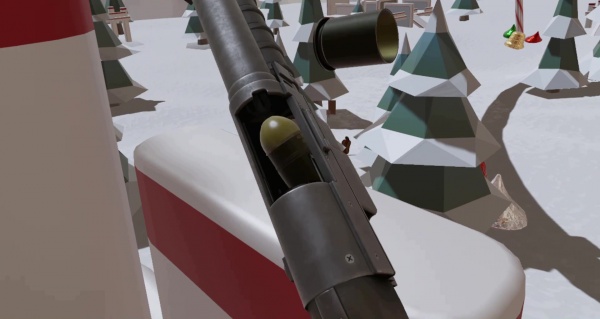
Running the action, and getting a good action shot in the process.
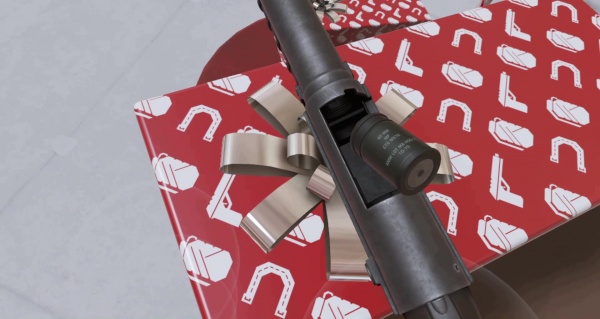
Needless to say, what better round could there be for an overgrown shotgun than an overgrown shotgun shell?
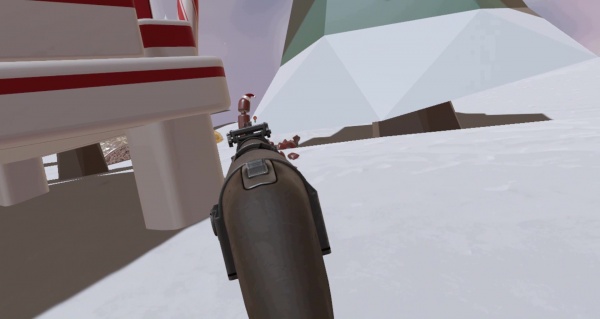
Should your encounters be closer than the ranges that the leaf sight has on offer, flipping it down reveals a close-range battlesight.
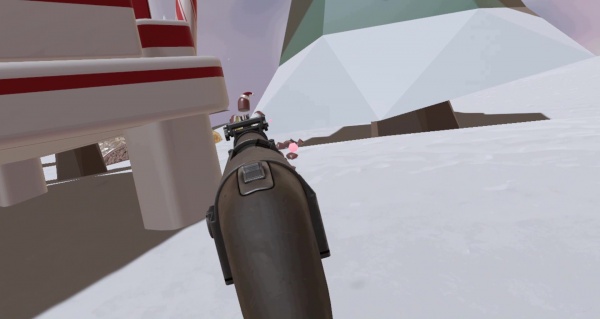
Perfect for torso-vaporizing needlessly clingy Weinerbots.
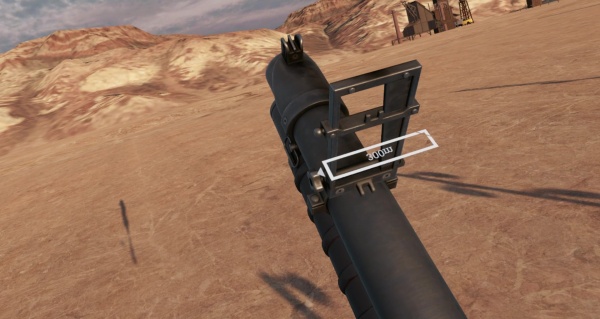
Update #99's sixth alpha made the aforementioned rear sight markings (50 meters to 300 in 50-meter increments, with a 25-meter zero flipped down) substantially easier to read, by way of this convenient Magic White Rectangle. Granted, the fact that the Rectangle is upside-down does mitigate its usefulness somewhat, but you'll get used to it eventually.
Fictional Railguns
Added in Update #108, the "Rail Tater" is a bizarre bolt-action railgun built from junk that fires tungsten-plated potato chips. It is the second weapon in H3VR created by Kommander Karl, a 3D Artist and YouTuber. The first was "Baby's First Boomstick", the unholy love child of a children's toy and a semi-automatic shotgun. The "Rail Tater" is a direct reference to one of Karl's videos, in which he "reloads" a can of Pringles potato chips. The Tater's potato chips (or "Porkless Hot Dogs") are among the most powerful projectiles in all of H3, traveling at an astounding 1,800 m/s and piercing straight through anything they hit along the way.
The 2023 Meatmas update added two additional railguns, both from other games (with the blessings of their respective creators): the "Hiro Enki YT Prototype" from Sprawl, a semi-automatic bullpup railgun firing 2x50mm caseless ammo at an utterly nonsensical velocity, and the "Meat Nailer" from Vertigo 2, a rocket launcher-esque device firing massive metal spikes from a motorized autoloader.
"Rail Tater"
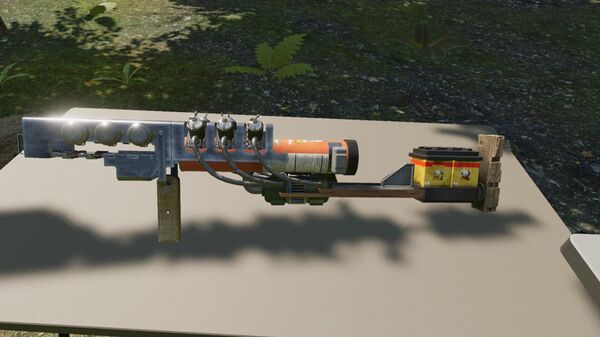
The "Rail Tater" in all its glory, bathed in the light of the sun.

Taking a closer look at the front end of the homemade railgun, which features a beige plastic foregrip.
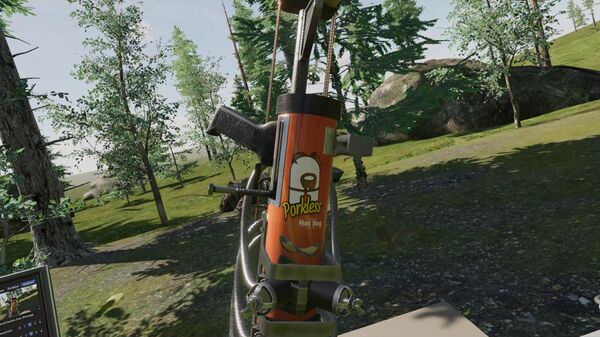
The core of the Rail Tater is, of course, a tube of "Porkless" hot-dog-flavored tungsten-plated potato chips. What could go wrong?

Sticking out from the chip container is the weapon's bolt handle, which is,
of course, a literal bolt. Seriously. Note also the pistol grip, which is mounted at an angle to make room for the weapon's stock.

Investigating the weapon's stock, which is composed of a large battery pack and an ultra-comfortable chunk of wood.
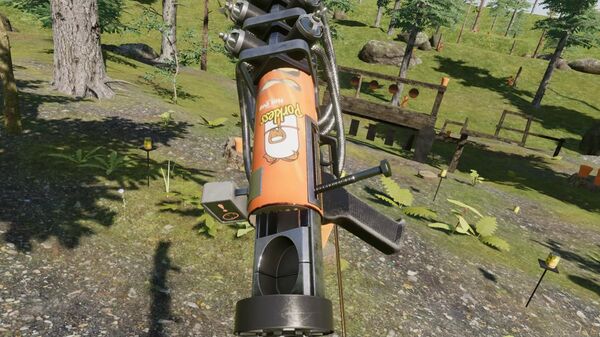
Pulling back on the bolt to open the chamber. Note the small monitor mounted to the left of the tube, which displays a red exclamation mark and a potato symbol when the weapon is unloaded.

A close-up of a "Porkless" plated chip. Mind the tungsten, and don't crack a tooth!
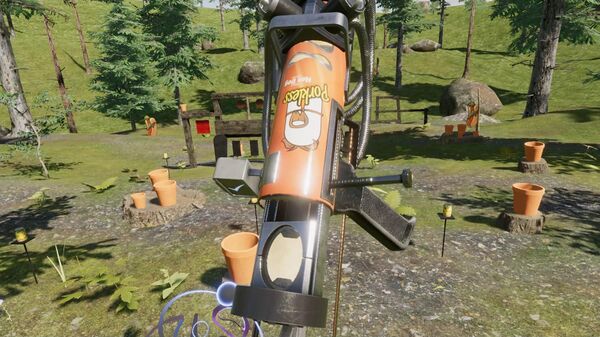
Inserting a chip into the weapon.

Closing the bolt. Note that the monitor has changed to depict a green checkmark; the weapon is ready to shoot.
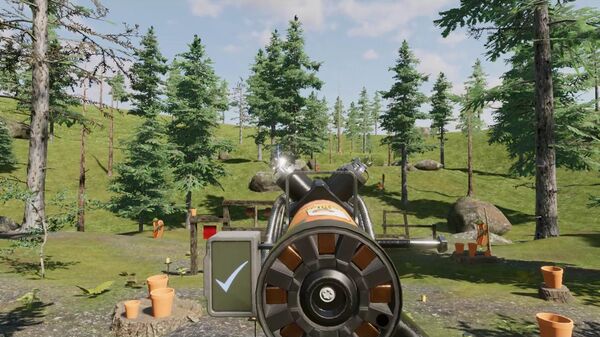
"Aiming" the launcher. The absolute lack of any sights (or even a rail attachment point) make this quite guesswork-intensive.
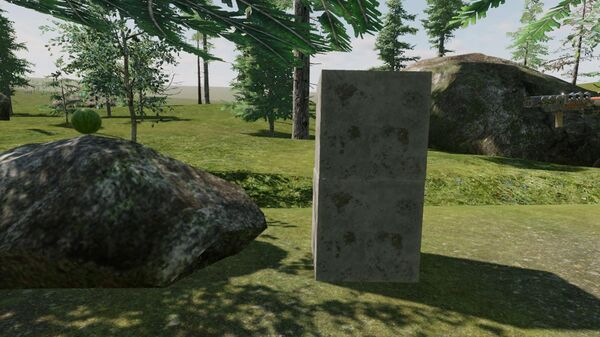
Time for a brief demonstration. On one side, an innocent watermelon. On the other, roughly a foot and a half of concrete.
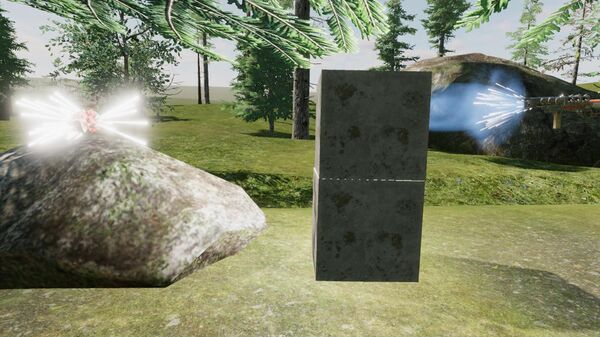
To the mighty Rail Tater, however, it makes no difference. The melon explodes the instant the trigger is pulled.

A few frames later, an orange tracer (perhaps a jet of molten concrete?) forms, painting the lethal potato chip's trajectory through the barrier.
"Hiro Enki YT Prototype"
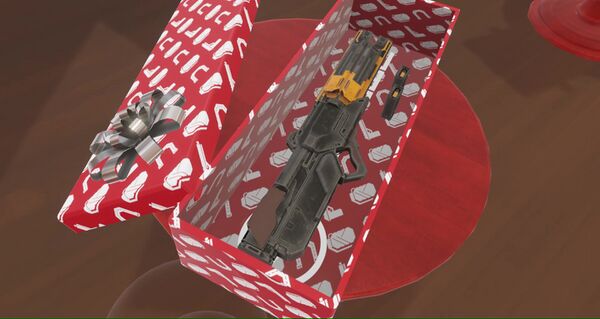
Popping open the antepenultimate box to reveal something from another game entirely.
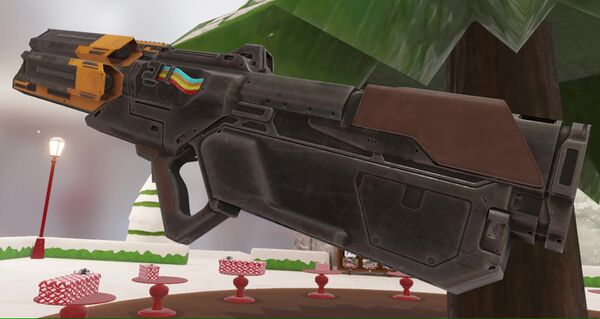
Taking a look at the Hiro Enki YT Prototype. The last word of the name is presumably part of why it doesn't have a trigger guard.
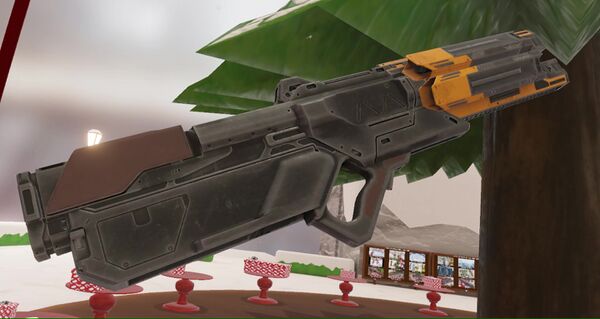
Notably, this isn't the model from
Sprawl itself; as a retro-styled shooter,
Sprawl's weapons are intentionally rather low-poly, with the version in
H3VR being a higher-poly rework of the original high-poly master model.
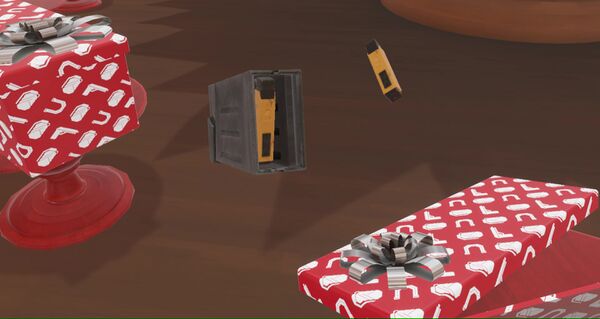
Weapons in
Sprawl also don't need to be reloaded, so this isn't normally something you'd see there. The 2x50mm caseless ammo is somewhat akin to the
Heckler & Koch G11's in design, though with the YT being a railgun, it presumably just gives the round the push it needs to be moving when it hits the rails (since if it isn't, it'll just spot-weld to them and brick the entire device faster than "linking_park_numb.exe" off LimeWire).

Popping in the magazine, though not before making sure to put the round shown above back in. You only get 5, so you'd better make 'em count.

"Aiming" the Hiro Enki; seeing as we're not retro FPS protagonists, and thus don't have crosshairs in our eyeballs, the lack of sights makes this activity a bit difficult. Optics are strongly recommended.
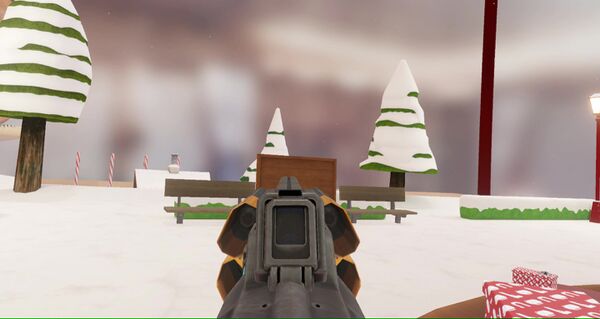
Charging the weapon, a phrase which has a completely different meaning when the weapon in question isn't a railgun. When it is, take note of the blue chevrons on the weapon's display; these gradually build up as it charges, with the 4 levitating rods surrounding the barrel gradually sliding forwards as it does so. The screen's normally brighter than this; the lighting here just isn't very good.
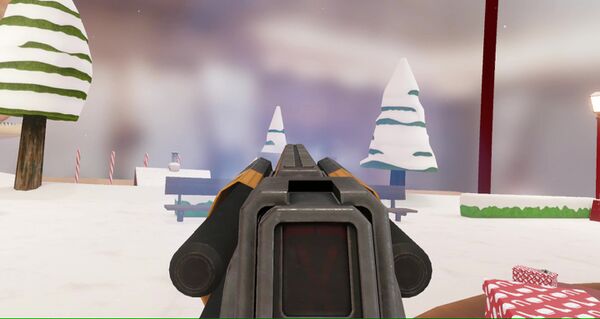
Hold the trigger long enough, and this is your reward: a red X on the screen, a whole bunch of recoil, a cool sound, a closer view of those rods, and the end-all be-all of small-caliber high-velocity projectiles. To the point that, upon its initial implementation, it barely did anything - the round so severely overpenetrated anything it hit that the game registered practically no energy transfer had occurred at all.

Another angle of the shot, showing off the rather impressive shower of sparks created upon firing.
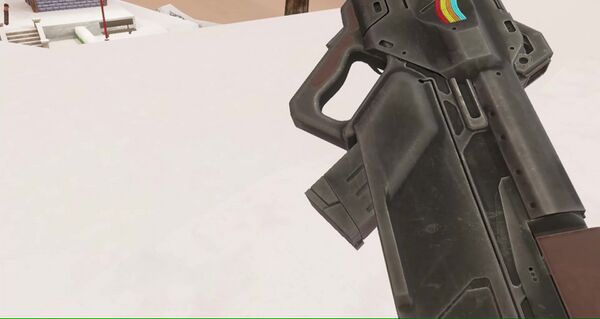
3 more rounds and 3 more sets of 2mm holes through the environment later, the mag runs dry. No release is present on the gun itself, but the magazine's floorplate looks like it might have one.
"Meat Nailer"
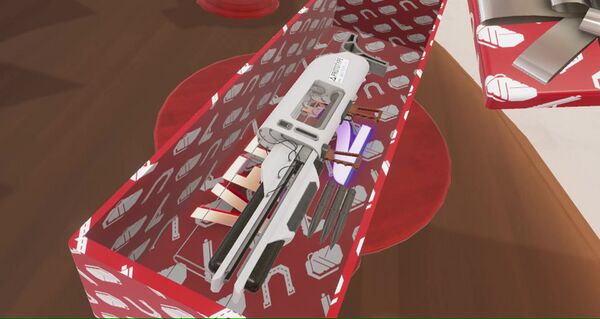
And, in the penultimate box, we have... something else, from yet another different game entirely.

It doesn't have "Prototype" in the name, but it is written on the side.
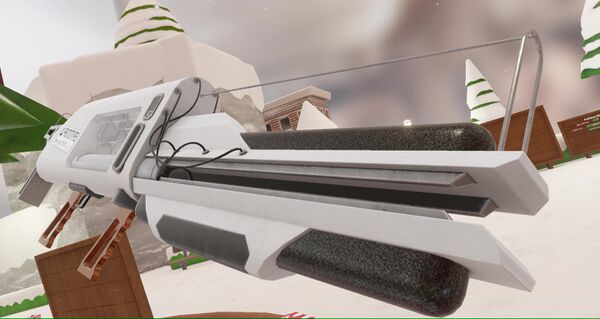
Plus, the flat-white exterior and exposed wires do a pretty good job selling the idea that it's not exactly a mass-produced piece.
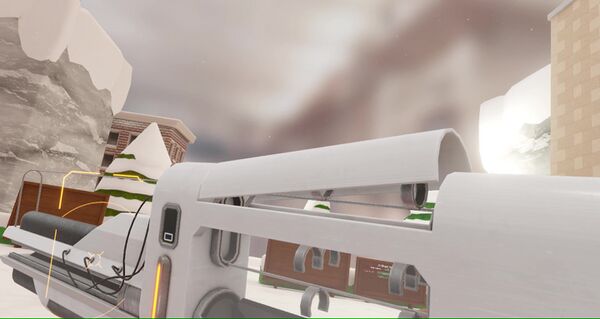
To load the Meat Nailer, first pop open this not-especially-visible hatch on the top. You figure it out eventually, and then you question how you missed it in the first place.
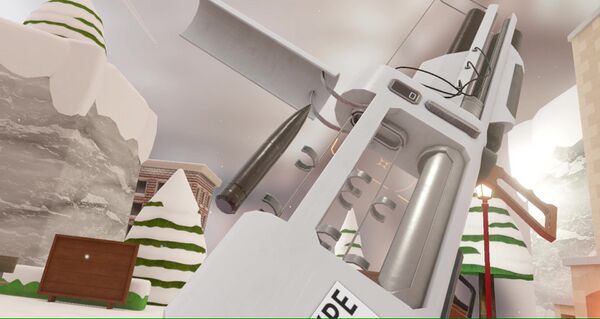
Next, load in some Meat Nails. Yep, that's the actual name. I mean, what else would they be called?

Note the orange lights on the side of the weapon; these show not only how many rounds are loaded, but also where in the somewhat complicated feed system they currently are.
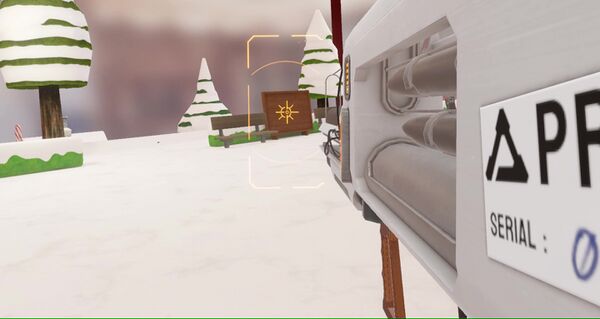
Taking aim at a wall; the misalignment here is intentional, mostly to show that it's possible - the holo-projector sight is in two parts, ironically functioning more similarly to a set of iron sights than a holographic sight. It can also be flipped to the other side if you're left-handed.
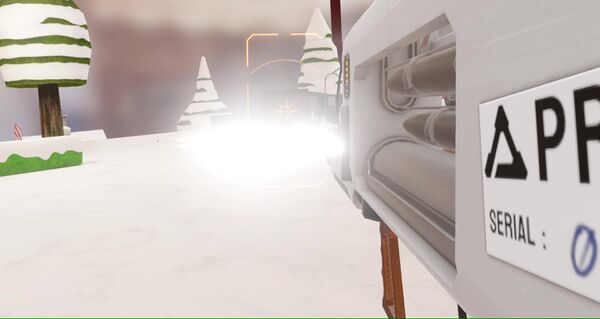
Putting a nail into some dried tree meat; while the Hiro Enki and the Meat Nailer are pretty much polar opposites in terms of projectile mass and velocity, they both create a rather impressive spray of sparks.

Following this, the weapon indexes a new round from the rotary feed system, while opening up the also-rotary chamber cover...

...then shoves it into the chamber, and rotates the cover shut.
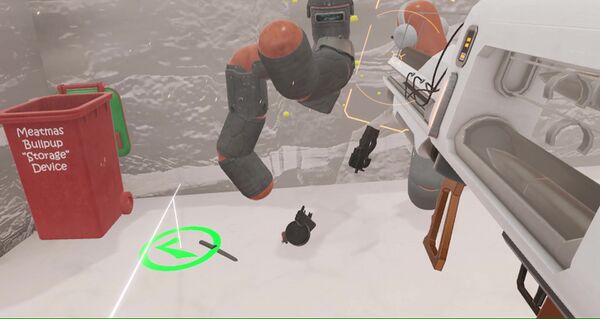
Oh, and if you're wondering: yes, it can, in fact, live up to its name. And no, they can't survive this, as gruesomely funny as it'd be to pin a live Sosig with nothing but a melee weapon to a wall and watch it futilely struggle to attack you.
...maybe I should see a therapist.
FIM-92 Stinger
The twentieth gift added in the 2018 Meatmas event was a FIM-92 Stinger anti-aircraft rocket launcher. It's the game's first (and, so far, only) guided-projectile weapon; it also holds the honor of being quite possibly the most faithful recreation of the Stinger's elaborate firing procedure seen in any piece of media to date.

The Stinger's gift box, which comes with a set of instructions. The 3D modeler's name is cut off by the size of their own creation; for reference, the artist's name is "3mern".
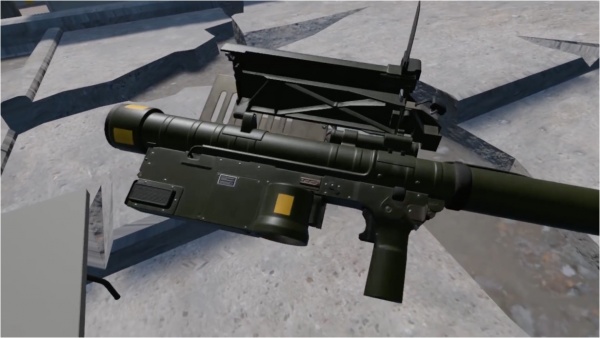
Meanwhile, in the Sampler Platter scene (to which the Stinger and its instruction manual were also added), we get a close look at the Stinger's gripstock (with an incorrect straight rather than forward-sloping grip)...
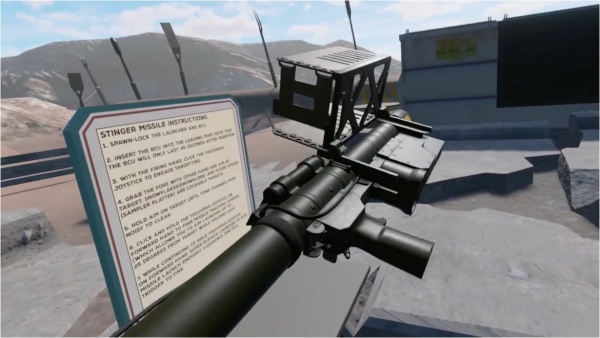
...and the IFF antenna. Which doesn't serve much purpose in-game, since there aren't currently any friendly aircraft in-game (nor is there an IFF interrogator box for the antenna to interact with).

This small object is what's known as a battery coolant unit, or BCU for short. This holds 2 things: a battery, which powers the weapon's electronics, and a supply of gaseous argon, which cools them (since IR-seeking systems need to be
extremely cold to work).
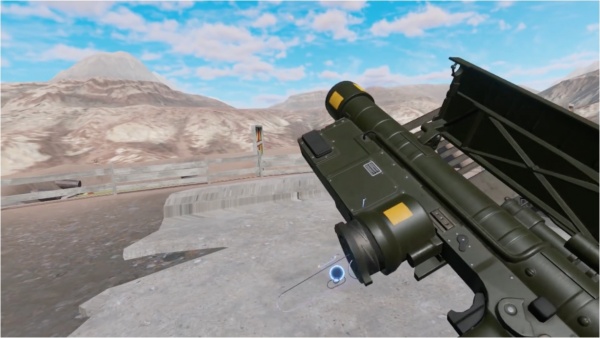
It fits into a hole in the bottom of the gripstock unit, and has to be inserted for the weapon to fire. Don't just put it in whenever, though; the BCU only provides a 45-second supply of power to the guidance system, so if you don't fire it within 45 seconds, you'll have to replace it.
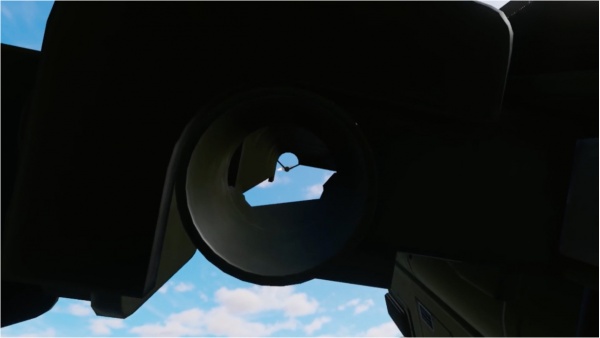
The next step is to turn on the guidance system (via a firing-hand touchpad button press), producing a continuous, grainy-sounding
beep; aiming at a valid target for a few seconds, such as one of these F-18-sized flying steaks (yes, you read that right) in the Sampler Platter's skies, will make this beep louder and clearer, indicating that a lock has been acquired. This is a
very slight deviation from the real weapon's operation; the in-game launcher can start a lock aiming at the target right away, whereas the real launcher must first establish contrast by aiming at a patch of open sky first, though this likely wasn't implemented due to the unfeasibility of properly coding such a feature.
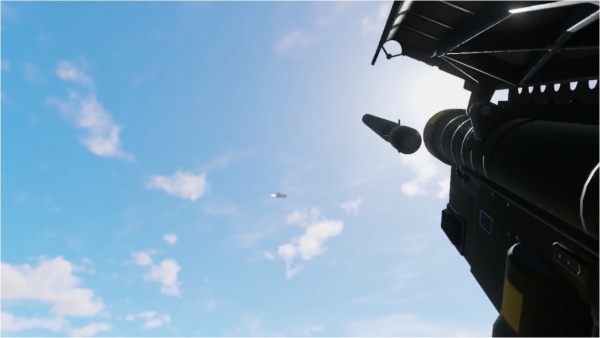
Then, just hold down the uncaging switch on the gripstock's forend, aim a bit above the target, and fire.

A second or so later, the rocket's main motor engages, and it seeks and destroys the distant meat-jet.
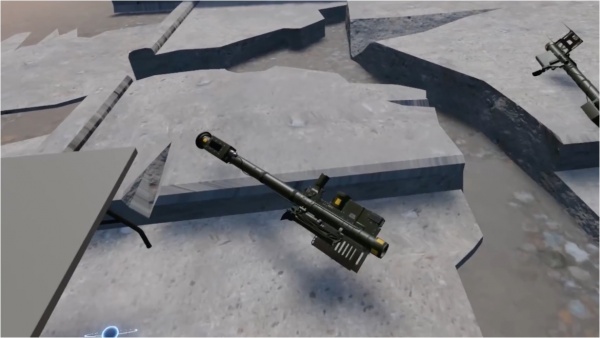
Following this, the launcher can simply be discarded. This is partly in line with its real-world counterpart; the Stinger's LTA (launch tube assembly; essentially just the missile itself and the tube surrounding it) is a single-use, disposable unit, while the gripstock is re-usable, though "reloading" a gripstock with a fresh LTA is seldom done in the field, and used launchers are usually just held onto to be dealt with later. This is a bit of a moot point in-game, since the entire launcher can just be spawnlocked and duplicated indefinitely.

Somewhat strangely, the list of valid targets includes the Meatmas Snowglobe's crystal snowflakes; this is presumably so that the player has something to use their new-found toy on (as difficult as it is to hit something so small so close to the minimum distance at which a Stinger's rocket will actually start seeking out its target). Here, a fired rocket can be seen falling towards the ground, a few frames before the main rocket motor kicks in and sends it skyward.
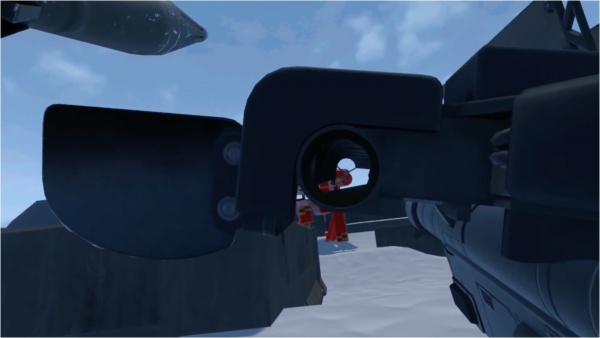
Fittingly enough, the "Meatal Gear Ronch" boss is quite vulnerable to Stingers (despite being encountered at rather short ranges compared to the Stinger's typical minimum, and the rather obvious issues involved with using an anti-aircraft rocket launcher against something that's not in the air).
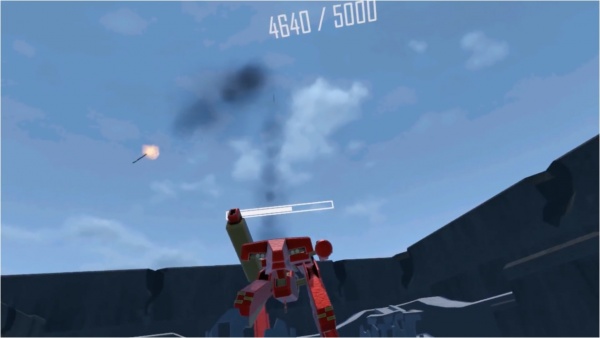
Though, of course, the mech can attack with its own Stingers as well; this exchange of missiles is another mechanic more faithful to the source material than it is to reality, and makes even less sense than the other way around, since the missiles lock onto targets
below the launcher; they're essentially used like high-tech mortars.
GP-25
The third alpha build of Update #76 was the GP-25 grenade launcher, complementing the prior alpha's M203. It comes in two forms: a standard variant (mountable on both the standard and "Tactical" variants of the AKM, the same sub-update's AK-74N, the AK-101, and the "Kalashniluger"), and a fictional variant that can be attached to Picatinny rails. A third version was added in Update #87, as an integral component of the "Mp7 Sustenance". In order to fit the MP7, this variant has no pistol grip, instead using part of the MP7's original foregrip mounted forward of the trigger guard; this presumably means that the grip serves either as a handstop/foregrip for the SMG (in which case the launcher is fired somewhat normally, with a thumb hooked through the MP7's trigger guard for support) or as an actual grip (in which case the launcher's trigger would probably have to be pushed with the user's thumb).
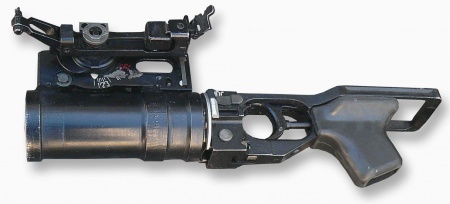
GP-25 - 40mm VOG caseless

The GP-25, in all its caseless glory. This is the fictional Picatinny-mounted version...
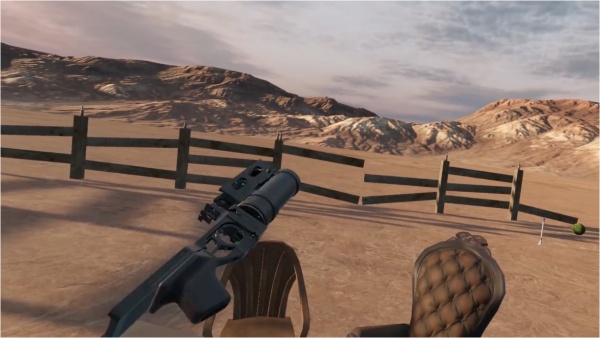
...and this is the standard version.
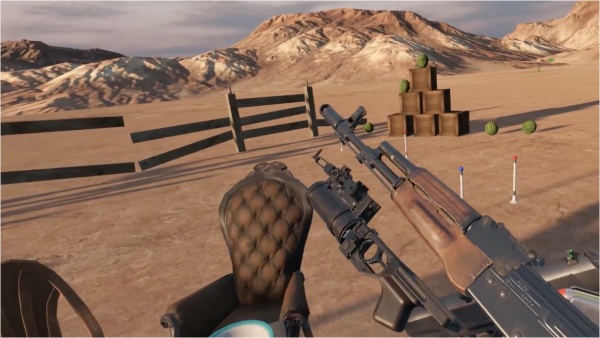
Aside from the different mounting hardware, the two variants can be distinguished by the presence (or absence, in the case of the alternate version) of a quadrant-type leaf sight. This also distinguishes it from the later
GP-30, which has its sight on the other side.
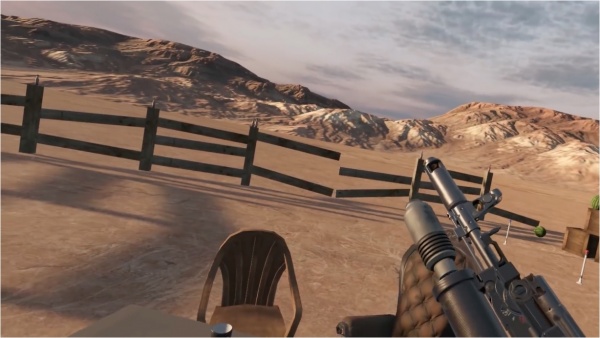
Loading a round into the muzzle; the GP series are quite possibly the most modern muzzle-loading firearms used by any military worldwide.

Should you think better of such a decision, there's this handy little button on the side.
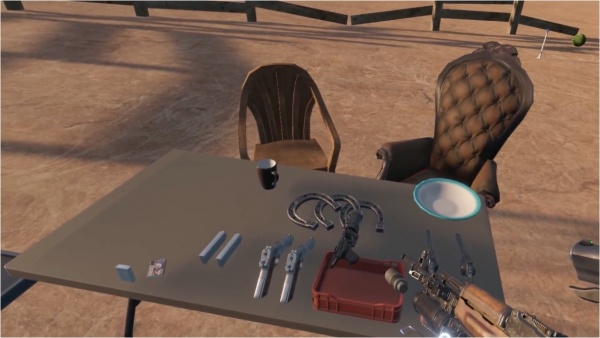
Said button serves to unlock the currently-loaded round, allowing for unfired grenades to be safely removed.
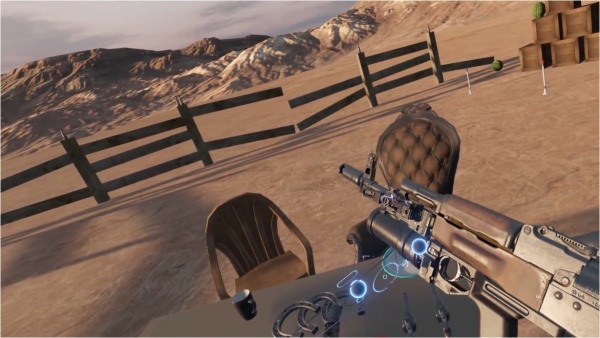
Above this button is the safety. Flipped back, it's on...
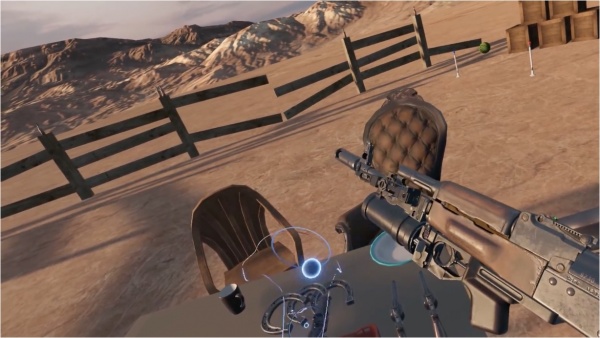
...and flipped up, it's off. For such a small weapon, it sure has a lot of controls, doesn't it?
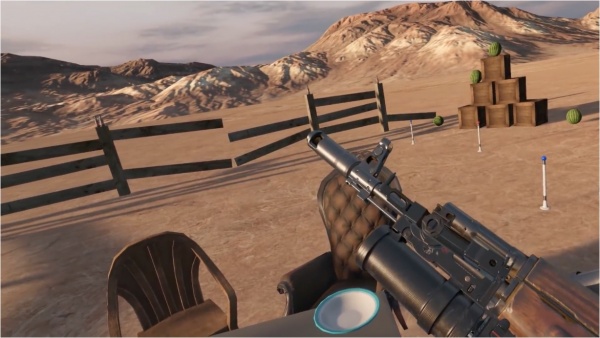
Also among these controls is the aforementioned quadrant sight; it can be adjusted from a close-range battlesight zero, to 100 meters, 200 meters, 300 meters, 400 meters...

...and back down to 300 and 200, albeit this time firing indirectly.
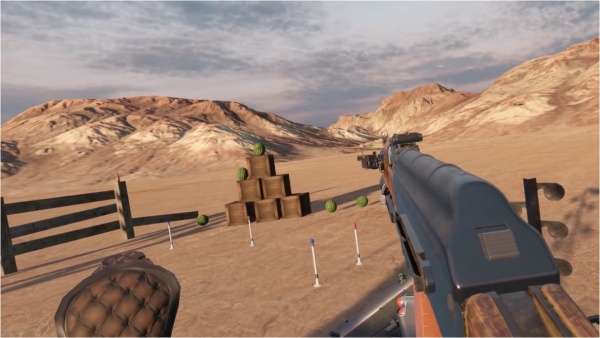
Aiming at a 100-meter target, with the sights dialed in accordingly.
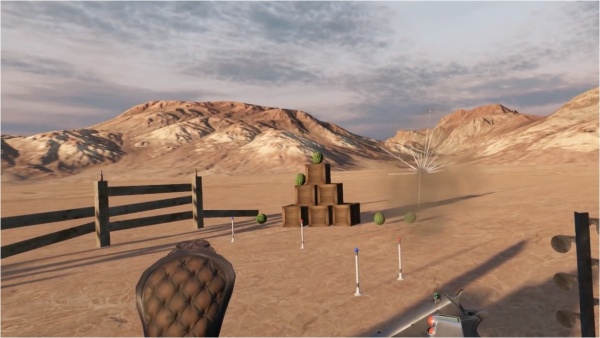
The round hits its mark (or near it, anyway). This is the impact of a standard HE-frag (as evidenced by the straight flight trail and burst of shrapnel); other options include inert training rounds, "jump"-based airburst rounds, smoke rounds, and flashbang rounds.
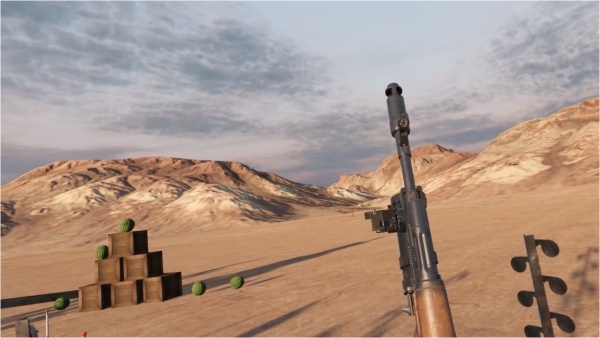
Aiming at the 200-meter target using the indirect fire setting; while it can be useful for firing over cover, it can be a bit tricky to hold the rifle steady like this.
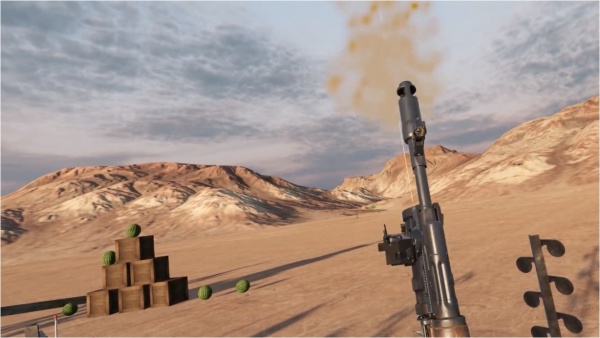
Plus, that just looks flat-out uncomfortable.
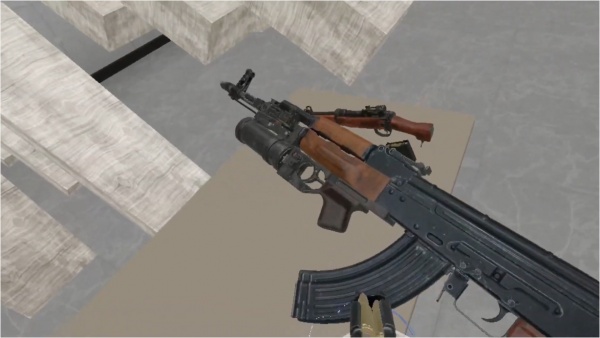
As mentioned, the GP-25 fits on more things than just the AK-74N; here's one on an AKM...

...here's one on a tacticooled AKM...
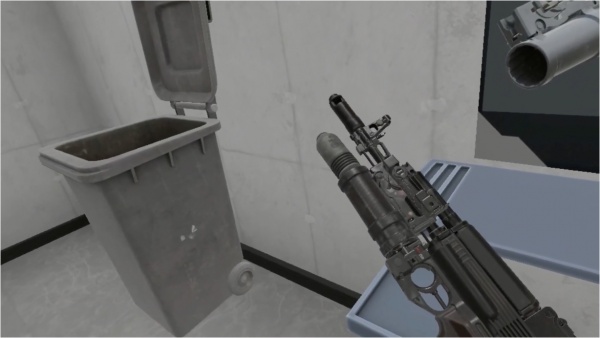
...here's one on an AK-101...

...and here's one on nothing at all. This is the Picatinny version again; while ostensibly an underbarrel launcher, there's nothing actually stopping you from firing either variant standalone like some sort of 40mm pistol.

Apart from your own sanity, that is.

Alternatively, you can use it to commit unspeakable acts of heresy.
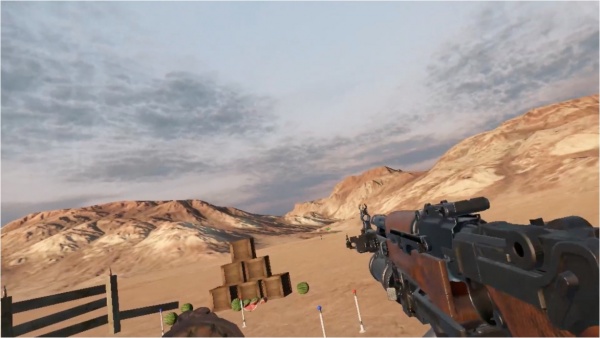
Aiming the 3-gun mishmash, which is a great way to make yourself wonder when you accidentally started playing
Wolfenstein.
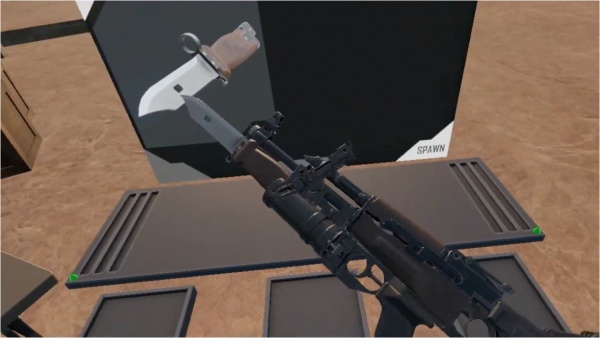
Also worth noting is this; while it doesn't exactly end well, the limitations of the game's coding mean that there's technically nothing it can do to stop you from doing this.
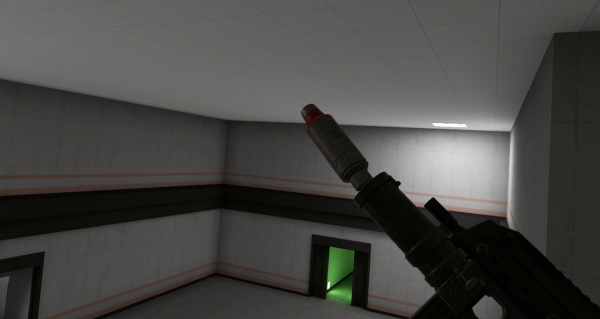
Preparing for the next hold phase, Welldone Freemeat loads a flashbang round into his SMG's fixed grenade launcher. Unlike the
original design, this launcher has to be loaded manually, and has a barrel that's actually large enough to fit the grenades it fires.
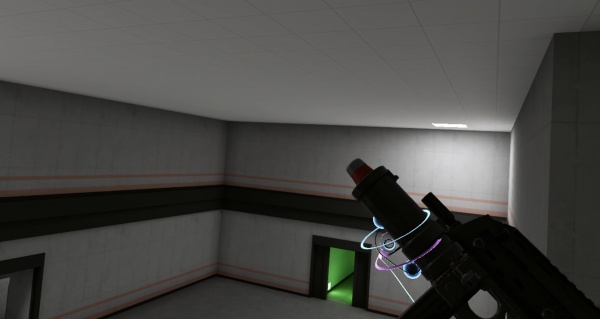
Well, large enough width-wise, at any rate.
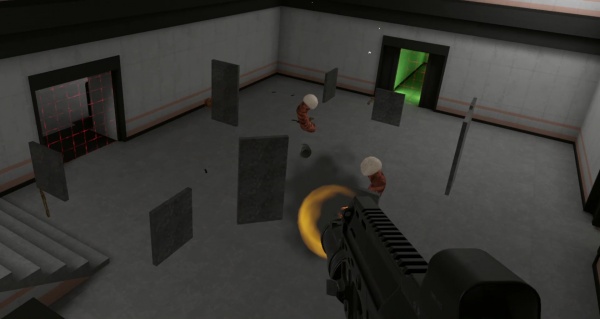
Safe in the knowledge that GP-series launchers just do that, Freemeat fires his at a group of breadcrab Zosigs.
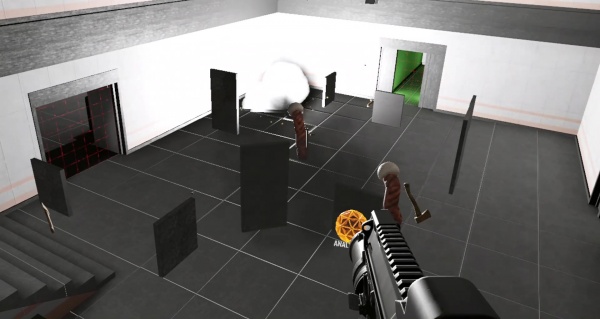
Said Zosigs are somewhat less than impressed by this display of less-lethal firepower. More-lethal rounds would've probably been a safer bet.
"Grenade Launcher"
One of the firearms added to H3VR in the "Meat Fortress" update/TF2 crossover was a recreation of the latter game's Demoman's Grenade Launcher, a fictional rotary design drawing cues from the M79 grenade launcher and the Milkor MGL.

Admiring the fictitious grenade launcher.
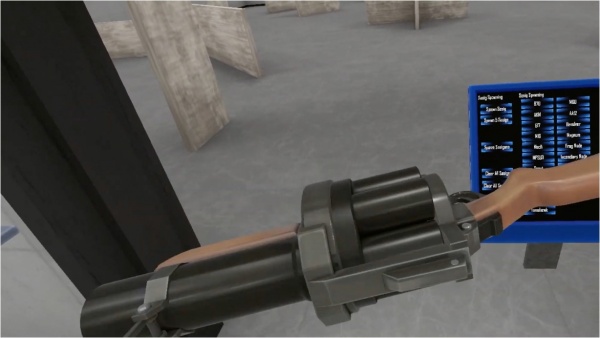
Taking a brief look at the other side; a bit redundant, as unlike its main user, the Grenade Launcher is largely symmetrical.

Cracking the launcher open; while not strictly impossible, the weapon would have to have one impressively beefy lower hinge to support that much weight.
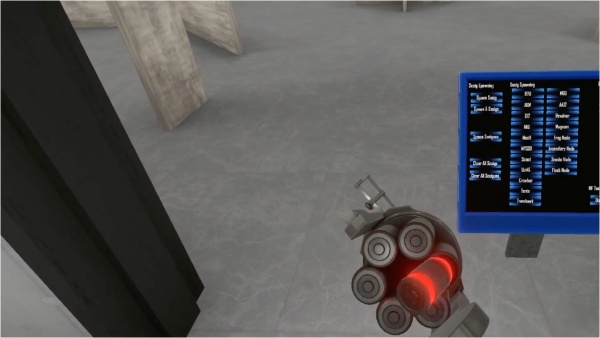
Loading in some fancy glowing "42mm Demonade" rounds; unlike in
TF2, the player here can actually load all 6 of the weapon's visibly-present chambers, instead of just 4. Well, to be fair, its wielder does perpetually maintain a BAC somewhere north of 0.2, so make of that what you will.
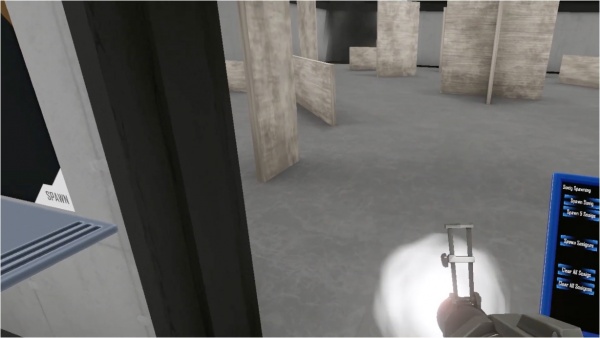
Emulating the behavior of a similarly-intoxicated individual, and firing a grenade directly at the floor.

Or at least that's how it looks at first; as in the source material, the grenades detonate on a timer, bouncing and rolling harmlessly off of surfaces until then.
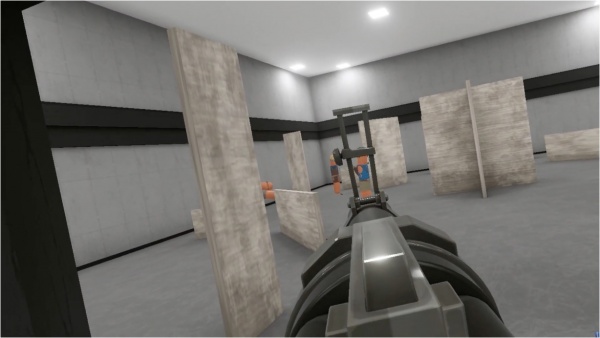
Aiming at a Scout-Sosig; there being no post to line this ladder up with (nor a notch in the non-adjustable sight itself), this is little more than a window through which one can see the approximate place where fired rounds will land.
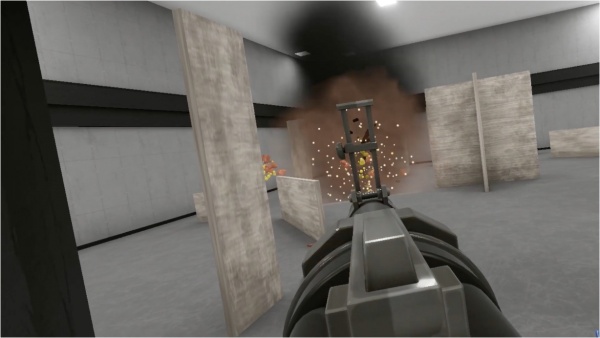
It does at least give a good view of the sole exception to the aforementioned rule, another tidbit inherited from the source material: the grenades bounce harmlessly off of inanimate objects, but detonate on direct impact with enemies.

One notable difference between this model and the one in
TF2 is the nature of its ammunition; whereas the original version fired caseless grenades, the
H3VR version ejects cases upon reloading.
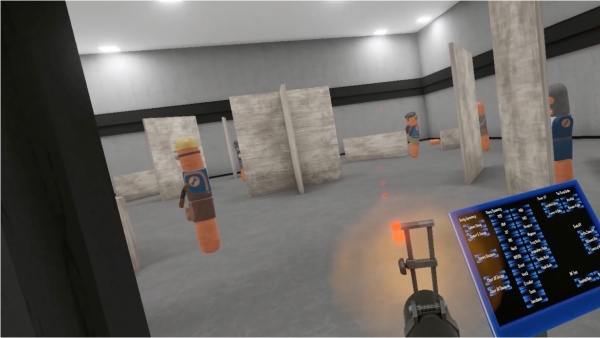
In keeping with the ongoing theme of alternating similarities and differences between the two models, both have bright, glowing, tracer-like lights on their projectiles...
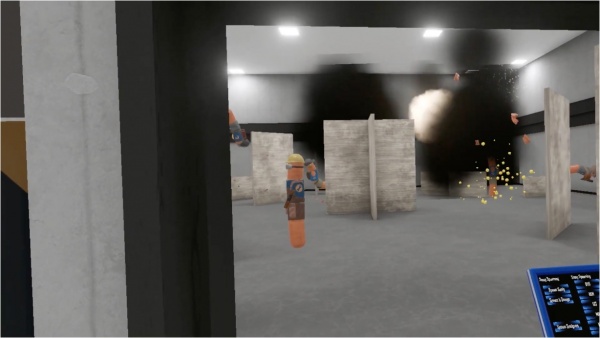
...but this incarnation's grenades' explosions affect one another, allowing them to scatter each other around and create chaos in enclosed spaces, as seen here.
Heckler & Koch HK69A1
Adding to the game's slowly-growing collection of grenade launchers, the Heckler & Koch HK69A1 was (rather fittingly) added in Update #69.
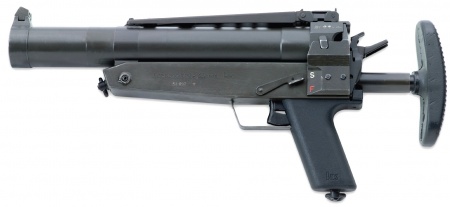
Heckler & Koch HK69A1 - 40x46mm
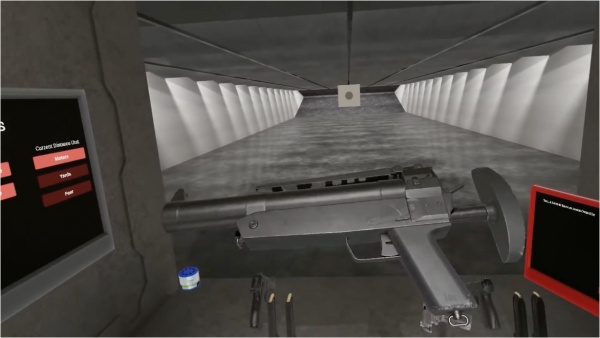
Admiring the beauty of Cold War-era simplicity.
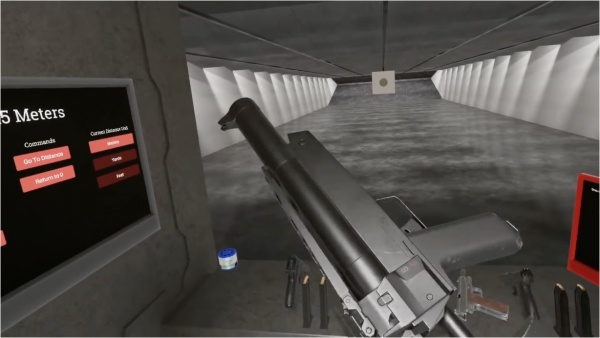
Sure, there may not be much to it, but that's part of the beauty of it. It's sleek, it's elegant, it's...
...
nice.
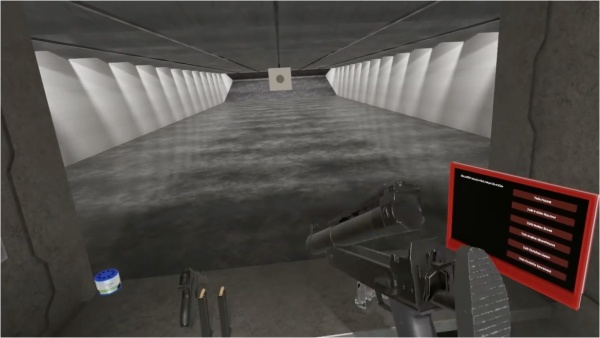
Cracking open the HK69A1.

Loading in a 40x46mm HE grenade.
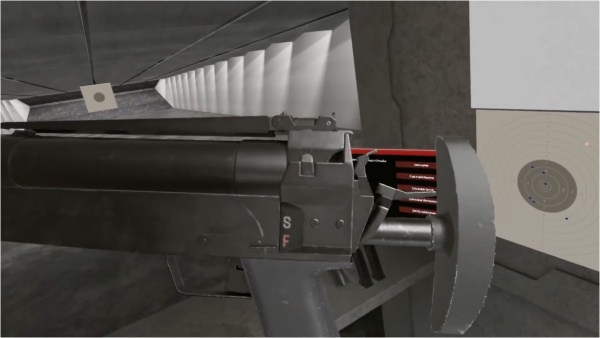
Cocking the hammer. This particular weapon's base code is more or less directly lifted from the earlier-added
Orion Flare Gun.
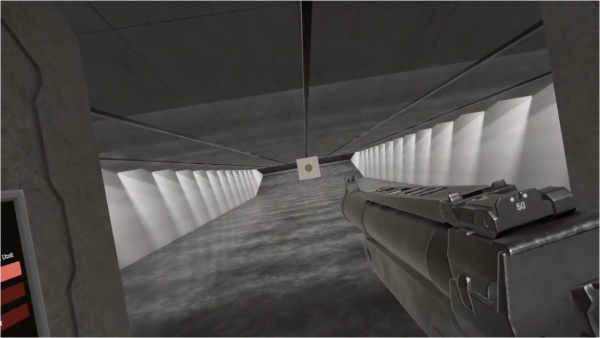
Completely ignoring the rather obvious flip-up leaf sight on top of the barrel.
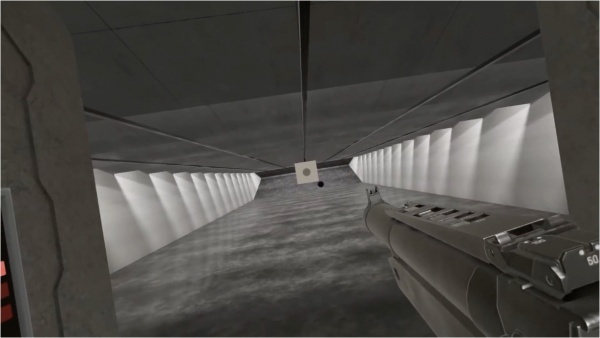
Let's get this grenade out onto a tray...
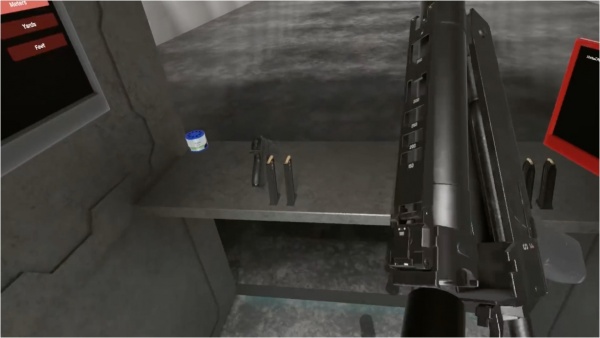
Dumping out a spent casing, and running before the range master gets here.
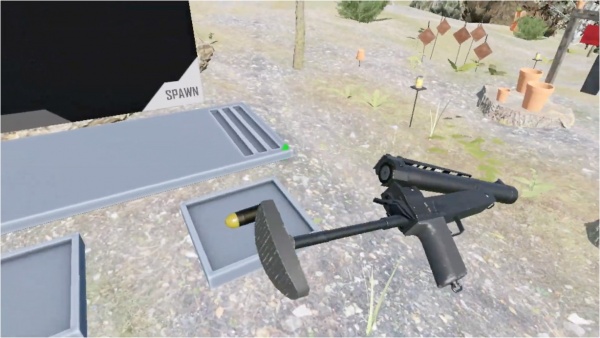
Having successfully run off into the forest, Public Range Enemy Number One tries out the HK69A1's collapsible stock.

While at it, PRENO also gives actually aiming a try, with the 50-meter battlesight zero...

...the 100-meter flip-up notch...

...the foldable multi-notch leaf sight. Which, thanks to the way the game works, can actually be used properly in
H3.
Heckler & Koch M320
Update #52's tenth alpha added a Heckler & Koch M320 to the arsenal, in keeping with that alpha's generally explosive-centric nature. The model was updated in Update #99 Alpha 3; besides fixing some scaling issues, the M320 can now be attached as an underbarrel grenade launcher to any firearm with a Picatinny rail.
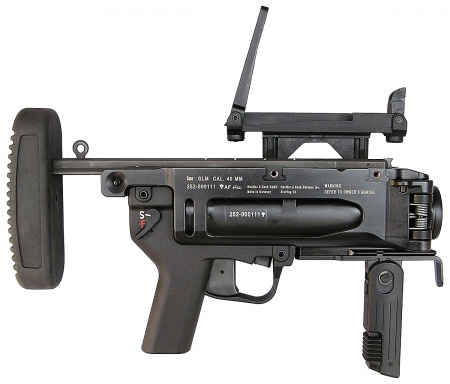
Heckler & Koch M320 - 40x46mm

Popping open the launcher's side-tilting barrel...

...and loading in a high-explosive round.

Folding down the leaf sight, to help with... something.
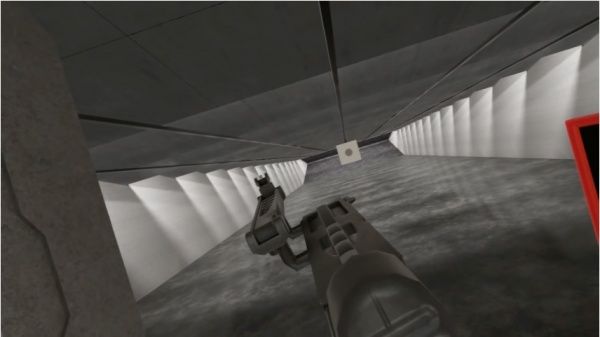
After all, what better way to take advantage of a game that allows for proper use of a leaf sight than to ignore it completely and act like the weapon has a normal set of sights attached to its barrel?
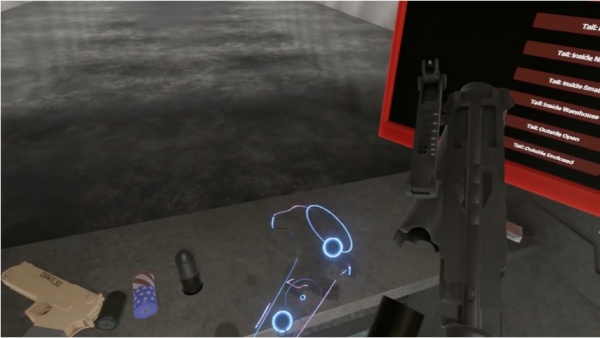
Confident in the sound logic of his decisions, the invisible man drops a spent casing out of his M320.
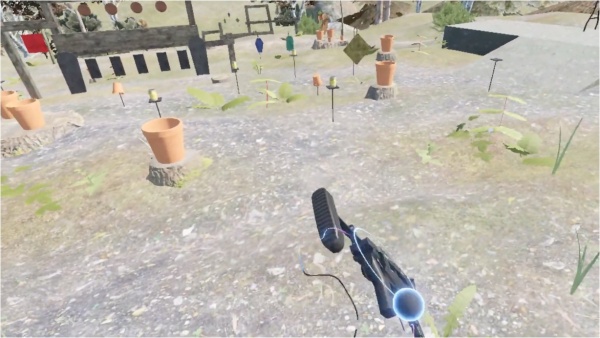
Fast-forward a couple months, and an older, wiser, and substantially less self-assured invisible man decides to stick more closely to the sensible things that society says he should do - things like extending stocks.

And, for that matter, actually making use of the provided iron sights.
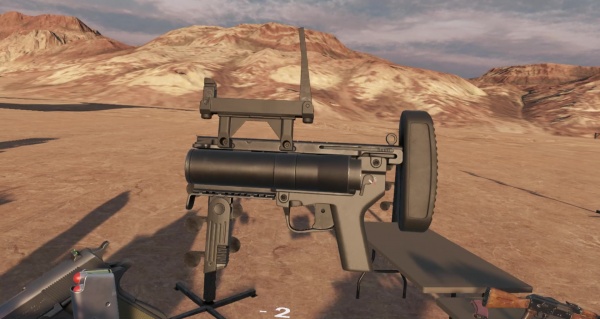
Unfortunately for the invisible man, he neglected to inform his employer about his planned educational trip, and got replaced with a new invisible man before he got back. Legends say that he's still out there somewhere, watching intently - and, like any good legends, they're totally impossible to disprove.
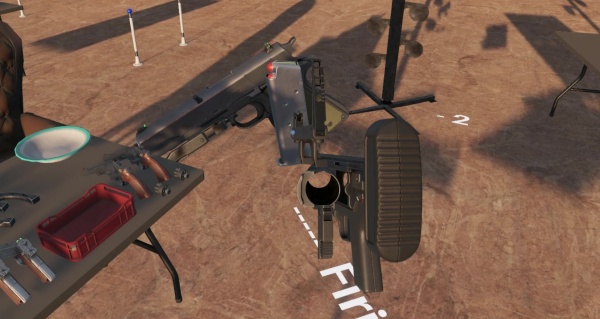
Russell's Teapot proving no comfort to him, the new guy pops open his newly-remodeled M320...
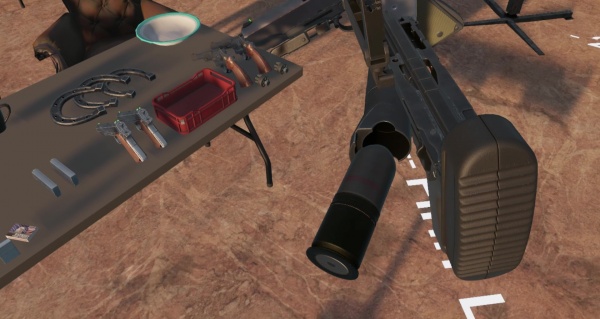
...and loads in an M651 CS gas round.

He then double-checks to make sure it's in there properly, and promptly gets yelled at by his supervisor. At least he got a good look at the modeled rifling.

Having been told to unfold the rear sight and handed the launcher with its rear sight already unfolded, he isn't exactly sure what to do; ultimately, he figures that fiddling with it a bit should be fine.
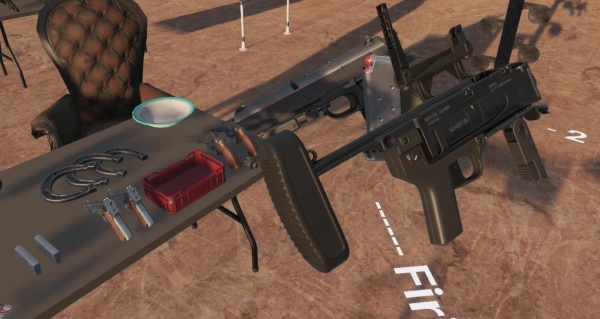
He thought the stock would be more self-explanatory, only to realize that nobody actually told him how far to extend it. Decisions, decisions...
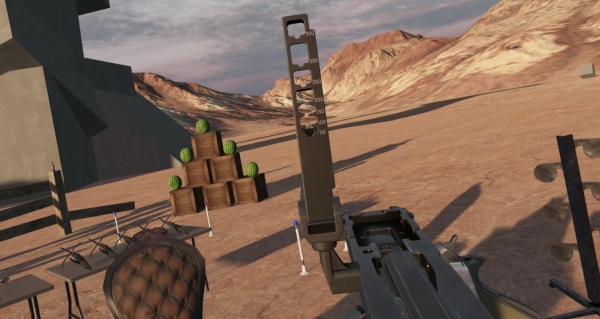
Looking back through his documents, the new hire finds that his first target is listed as being 100 meters away, and aims at it with the appropriate sight notch. He then realizes that he's had his caption-generator on the "Mention Individual" setting this entire time, and hopes to keep his job as the switch gets flicked to "No Individual".
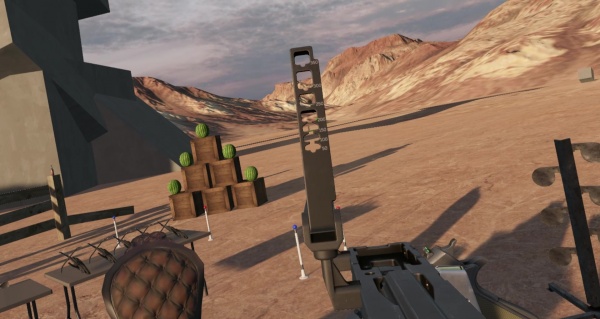
Firing the launcher; at full size, the grenade can be seen through the 250-meter sight window. Curiously, firing the launcher in this configuration tends to make it kick downwards.
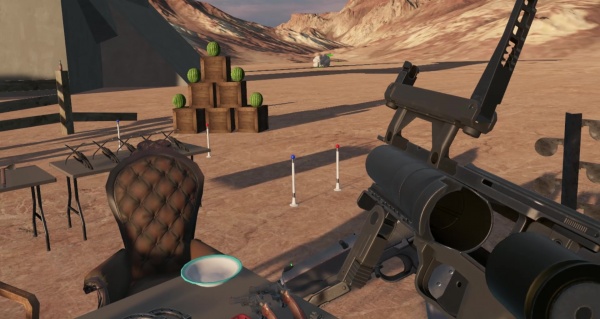
Watching the round hit its mark, and ejecting a spent casing; this auto-ejection behavior was most likely implemented inadvertently, being present on neither the previous version nor the real launcher.
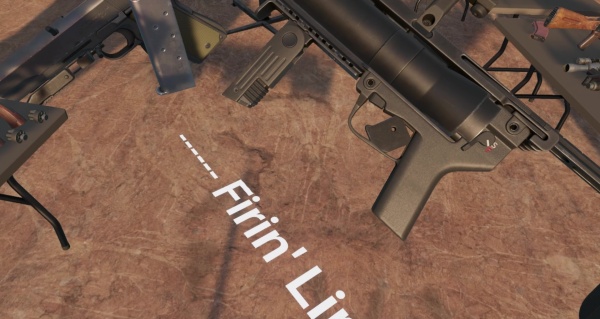
Speaking of unintentional things, the trigger incorrectly pivoted forwards upon the new model's release.
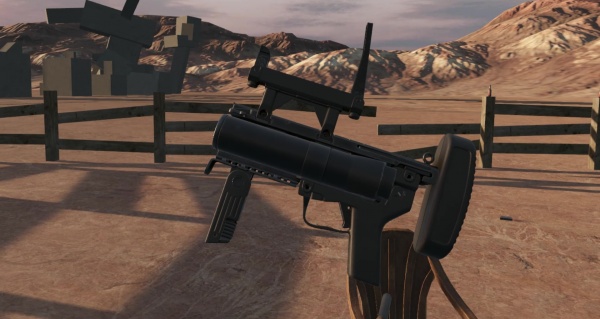
This was later fixed in the first alpha build of Update #100.
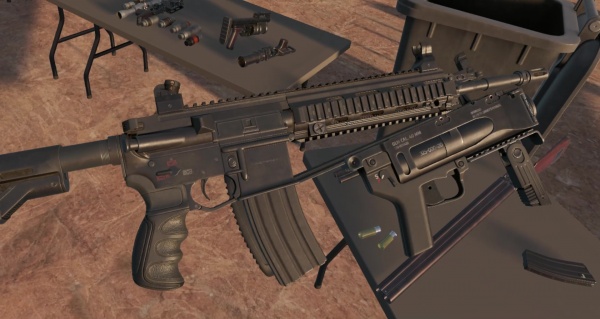
Of course, the updated model did come with a much more substantial difference; to see it, simply bring the launcher up to a Picatinny rail...

...try to ignore the heinous clipping that occurs as you get the positioning just right...
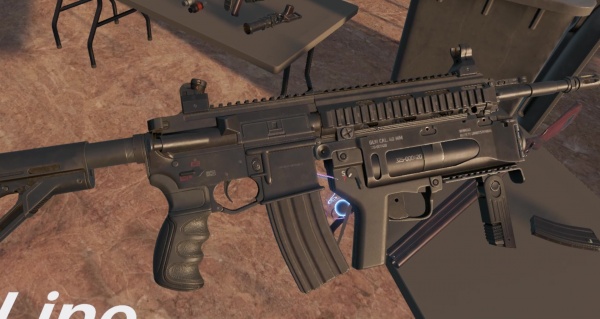
...and let go of the launcher, its stock suddenly realizing that it wasn't invited to tag along. While the
HK416 shown here is arguably the most appropriate rifle to mount it on, just about anything with a Picatinny rail will work. Handguns included.

Dropping an HE grenade into the launcher while its parent rifle rides in a quick-belt slot; this would normally be done with both hands instead, but the wielder's other hand is currently busy using one of the alpha's other additions: the climbable rope from a thrown grappling hook.

A bit of rifle-juggling and an earnest attempt at using the sights later, said grenade makes a splash against an overhanging chunk of the Arizona range's concurrently-added climbing structure. In retrospect, firing a high-explosive grenade at an overhanging chunk of a structure while being supported 20 feet off the ground by said structure probably wasn't the greatest idea.
Homemade Flamethrowers
Added in Update #60, the "Junkyard Flamethrower" is, as the name implies, a homemade flamethrower composed of various pieces of tubing, wiring, and other miscellaneous bits, all added onto what appears to be a pressure washer wand; it is closely modelled after the Flamethrower seen in The Last of Us, with some minor differences.
As it turns out, this was added largely for the sake of preparation; the "Meat Fortress" update added a replica of the TF2 Pyro's flamethrower, a device based largely on a commercial weed-burner (though possessing a passing resemblance to the M1 Flamethrower), composed of a gas pump handle, a propane tank, and various pieces of piping and hoses, operating with similar mechanics to the Junkyard Flamethrower.

The "Junkyard Flamethrower" on a table in the Proving Ground scene, along with a tank of fuel and a Molotov cocktail.
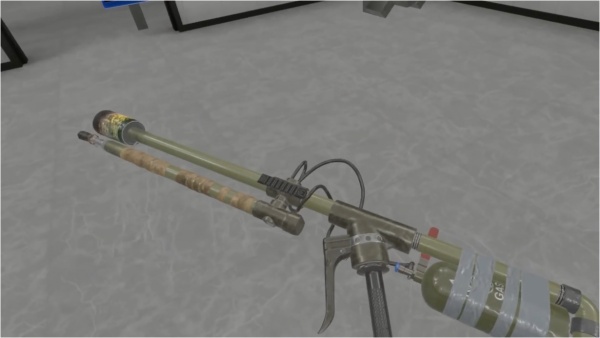
The left side of the improvised flamethrower, showing off the tape-covered "GAS" tank, presumably serving as the flamethrower's pressure reserve; for gameplay's sake, this never needs replacing.

The other side of the flamethrower.
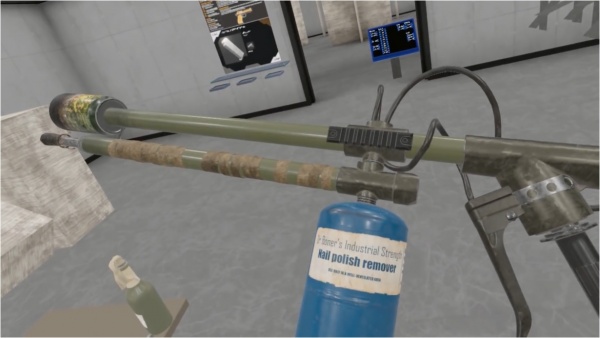
...before pausing to take a look at what was just loaded. The tank is labeled "Dr. Boner's Industrial Strength Nail polish remover", and features a warning to "USE ONLY IN A WELL-VENTILATED AREA"; from this, it can be inferred that the tanks (seemingly propane tanks, of the sort used in portable camp stoves and the like) are filled with concentrated acetone. While this may be second only to The Fury's
Flammenwerfer 41 loaded with unsymmetrical dimethylhydrazine and nitrogen tetroxide (i.e.
rocket fuel) from
Metal Gear Solid 3: Snake Eater in terms of odd flamethrower fuels, it does make some sense: as any bottle of non-industrial nail polish remover will tell you, acetone is highly flammable, and would make a more effective fuel than the gases commonly used in homemade flamethrowers, though its volatility and tendency to evaporate easily would limit its effective range and make it somewhat dangerous - not that an ordinary flamethrower is exactly OSHA-approved, mind you.

The muzzle of the flamethrower, constructed of a cut-open soda can; judging by the blackening of the end, this flamer's seen some use. Which is simultaneously encouraging and worrying.

"Aiming" the flamethrower...

Overjoyed that the weapon didn't explode upon firing, our fire-fighting friend takes a look at the adjustment lever at the flamethrower's rear.
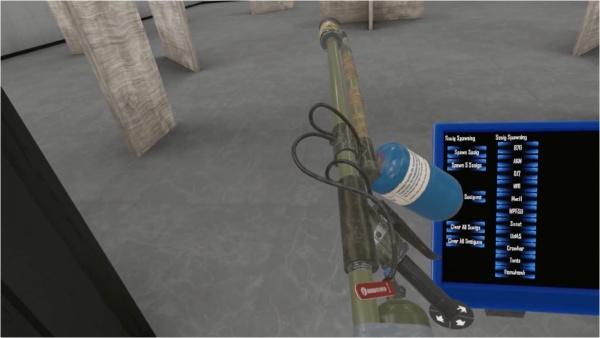
The lever adjusts the flamethrower's gas pressure; pulling it back reduces the pressure...
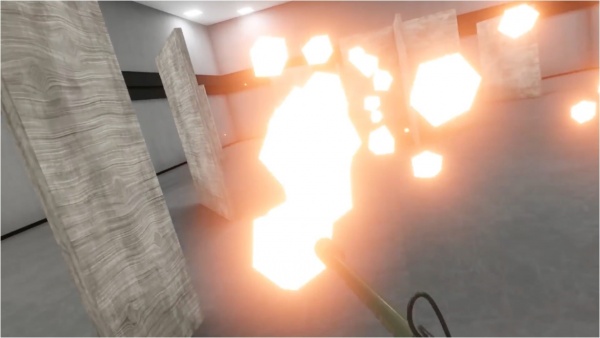
...creating a wide spray of flames, like so...
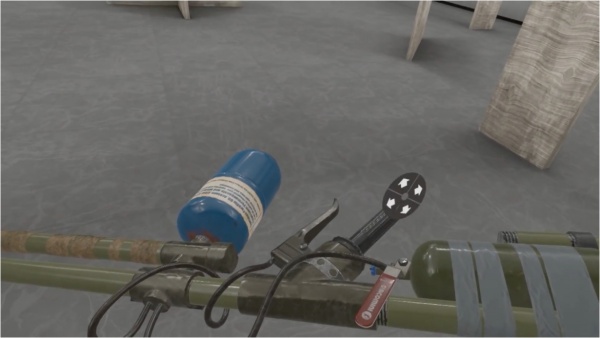
...while pushing it forward increases the pressure...
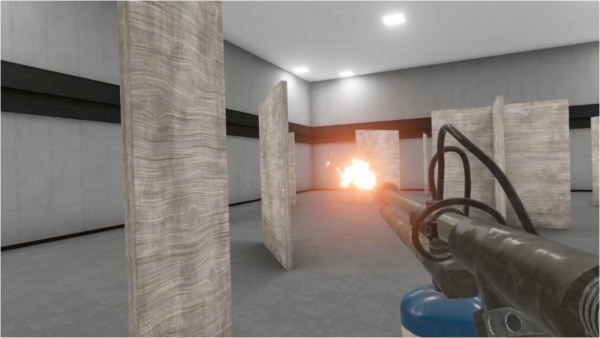
...creating a more realistic, less video-gamey narrow stream of fire.
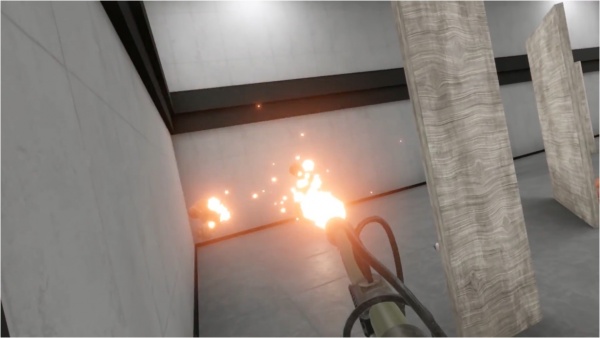
This narrow stream allows more precise, long-ranged use, perfect for roasting more distant Sosigs. As for the wide mode, its use in close quarters is unparalleledly lethal; when combined with the tendency of in-game flame particles to spread out and slide along solid surfaces, this leads to...

"
It was a pleasure to burn. It was a special pleasure to see things eaten, to see things blackened and changed."
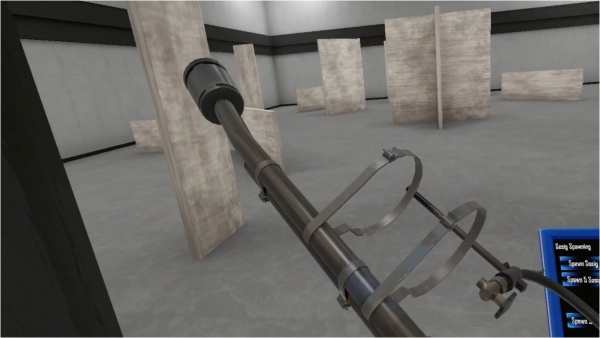
The Pyro's take on the homemade flamethrower concept. Note that the standard model's propane tank is missing, leaving behind a cradle of solid metal bands.
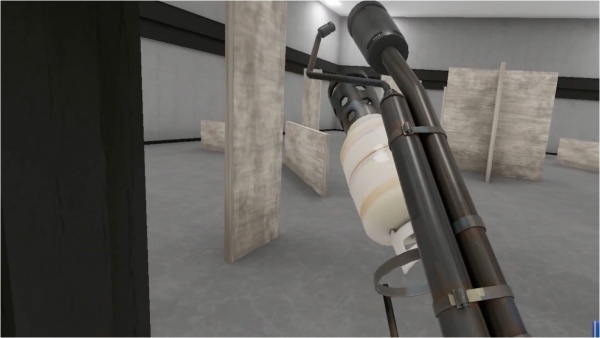
This is because, as with the Junkyard Flamethrower, ammunition comes separately, and the tanks must be attached prior to firing...
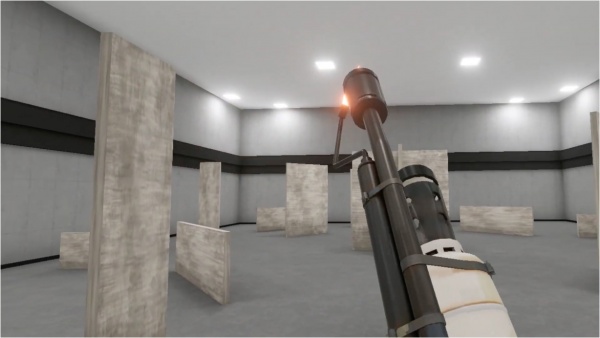
...a process which causes the weapon's forward-mounted pilot light to turn itself on.

Admiring the rear end of the flamethrower, while taking note of the gas pump handle used as a trigger. Hey, as long as it works.
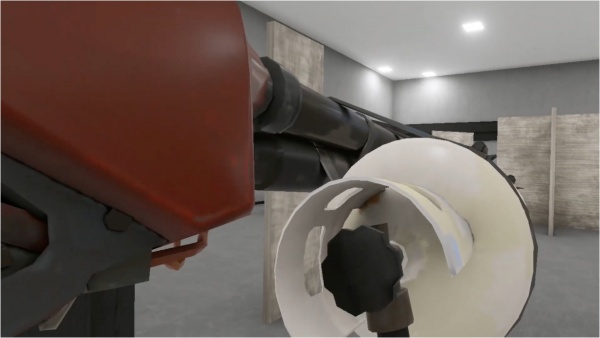
The pressure-adjustment mechanic from the Junkyard Flamethrower is also present on this version, with the adjustments being preformed via this knob; this appears to be the propane tank's flow-adjustment knob, though it is depicted as part of the flamethrower instead of part of the tank (likely due to the issues with moving parts on removable/attachable objects).
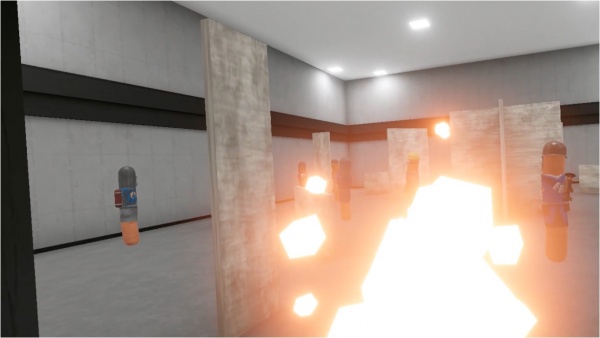
Twisting it all the way to the left creates a wide area of effect at the cost of range...

...while turning it to the right does exactly the opposite.
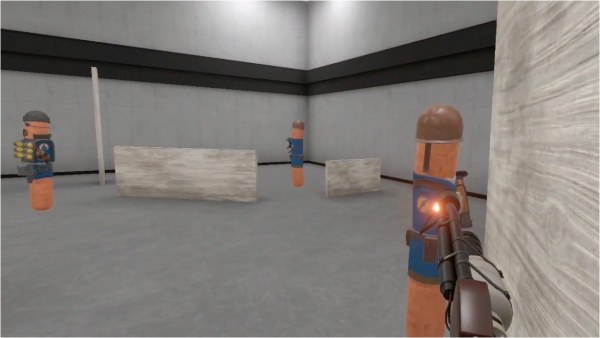
There is one important mechanic, however, that the
TF2-derived flamethrower does not share with its prior-added counterpart (but does share with its source material):
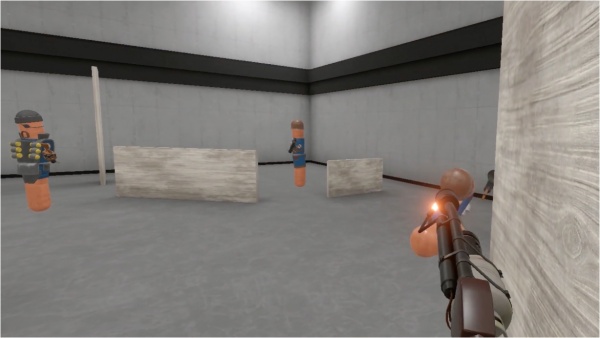
The ammo-consuming, projectile-redirecting, enemy-pushing, and eternally laughter-inducing airblast.
M1A1 "Bazooka"
Update #50 added the M1A1 Bazooka to H3's collection of explosive toys. Unfortunately, the reloading procedure is incorrectly simplified, with the rocket simply being shoved into the rear of the tube, without bothering to attach the wire to the electrical contacts at the rear of the launcher (which served to transfer electricity to, and ignite, the rocket's booster charge and motor).

M1A1 Rocket Launcher "Bazooka" - 2.36-inch rocket
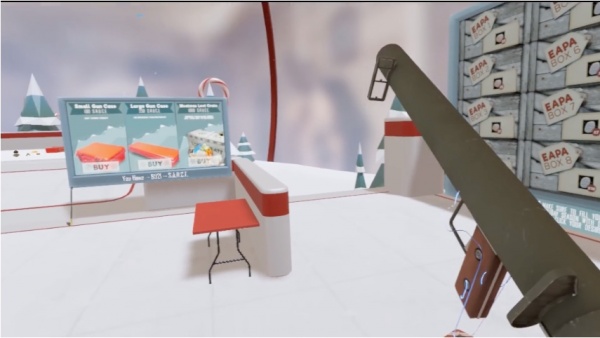
The M1A1 in first person. A rather difficult weapon to grab a good screenshot of, considering its sheer size.
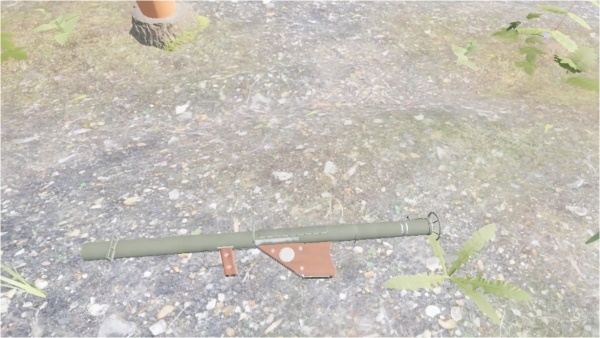
Still, with enough due diligence (read: throwing rocket launchers on the ground), its full extent becomes visible.
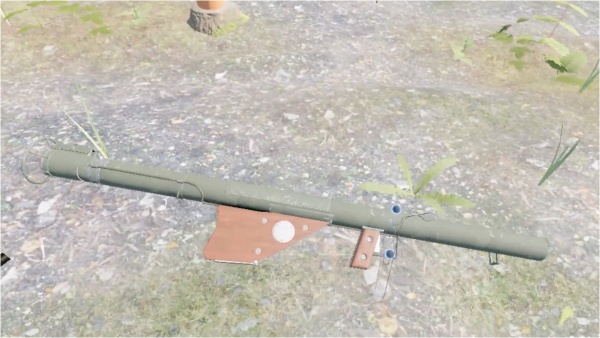
And for those who were expecting the right side to be a substantial departure from the left, well... I don't have anything to say except "sorry". And perhaps "lower your expectations." Anyway, back to business...
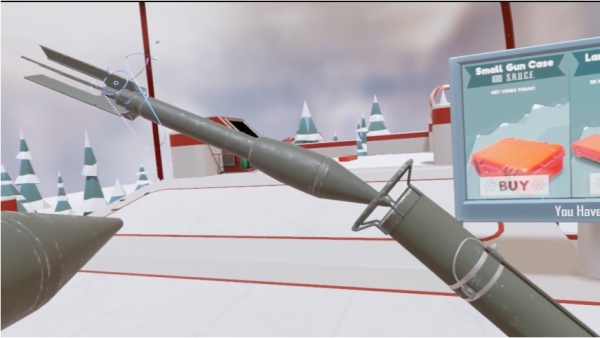
Loading a M6A1 rocket into the rear of the weapon. As mentioned, this is the only thing required for reloading, with no simulation of the attachment of the contact wire.

Aiming the M1A1. Unlike in many games, the weapon's multiple front sight posts are actually useful here, as the projectile drops over distance, and the weapon can be manipulated freely, rather than having a single fixed aim-down-sights position.
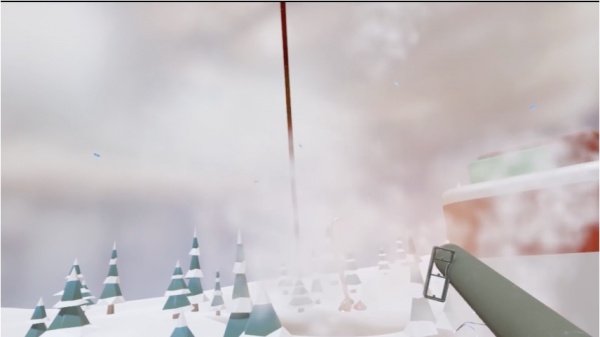
Firing the Bazooka, which produces a suitably impressive cloud of smoke.
M203
Update #107 Alpha 1 introduced the original, full-length version of the M203 Grenade launcher. Like the earlier added M203A1, this launcher can only be used on the M16A1 and M4 Carbine, and when attached to either weapon, the matching sight ladder appears on top of the weapon's fore.
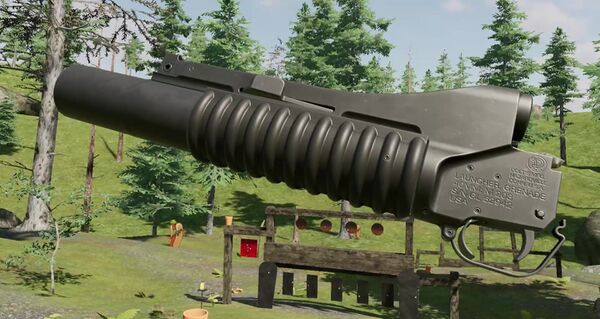
Taking a look at the new M203; the nicely-detailed markings show it to be an earlier Colt-produced example. Or, rather, a "Dolt"-produced example.
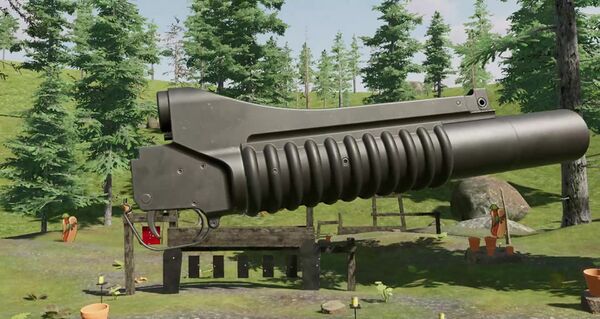
The right side, meanwhile, is conspicuously devoid of markings. It's not supposed to have any, mind; it just looks a bit odd.

Bringing the launcher up to a rifle's handguard...

...and marveling as the triangle instantly becomes a trapezoid. Not for very long, mind; we're not made of time here, so this is also the breech-opening shot.
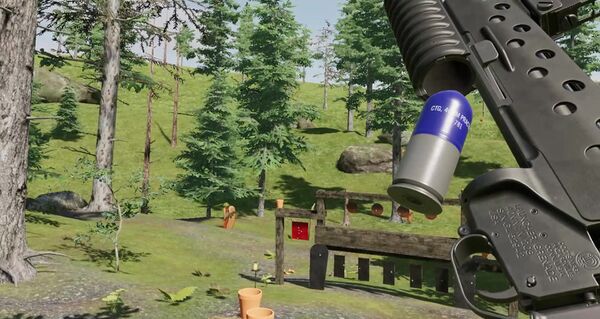
Loading in a 40x46mm round; this is an M781 practice round, with a payload of chalk powder to make it obvious where the round landed. Fitting for a launcher mounted onto a civilian semi-auto rifle.
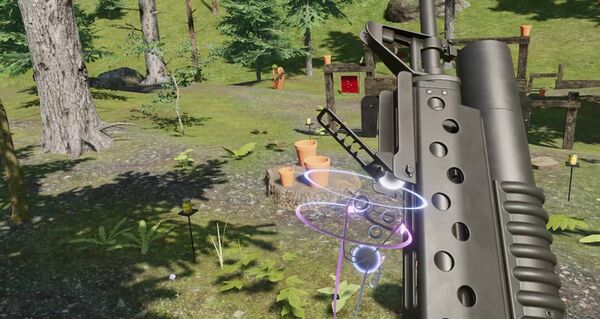
Fiddling with the rear sight; this was initially fixed in place, but was later made foldable after a patch. Helps when you're trying to aim the rifle that it's attached to.

Firing off a round. No dedicated aiming shot, but you can see how it works here anyway - just pick the right rear sight notch for your range, and aim with the parent rifle's front sight.
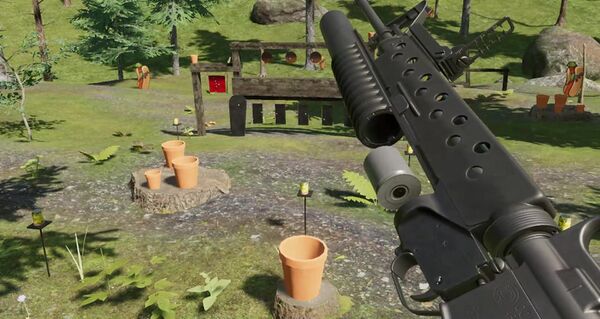
Dumping out the spent case. Better pick it up - those rounds aren't cheap. Plus, you can clean it out and use it as a shotglass.
M203A1
Update #76's second alpha build added the long-requested, just-as-long-thought-impossible feature of attachable underbarrel grenade launchers, the first example of which being one of the most well-known, the M203 - more specifically, it is the short-barreled M203A1 variant. The M203A1 was rebuilt in Update #107 Alpha 1; besides a refreshed model, the weapon now comes with its sight ladder when attached to either the M16A1 or M4 Carbine.
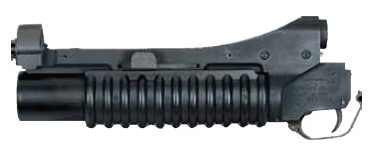
KAC-manufactured M203A1 - 40x46mm

After years of waiting, it's finally here. Rejoice, all ye faithful, rejoice.
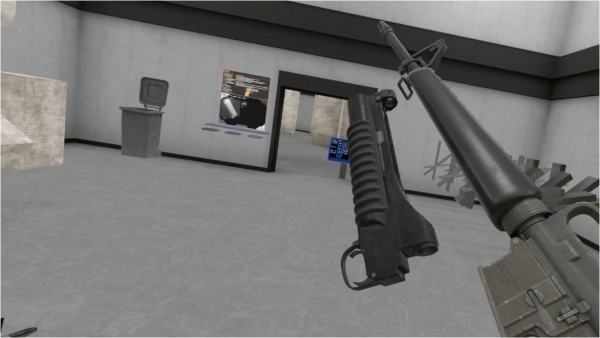
It's not often that you see an M203 in a game that isn't already mounted to something; it can be fired in this state in-game, though there is little point in doing so...
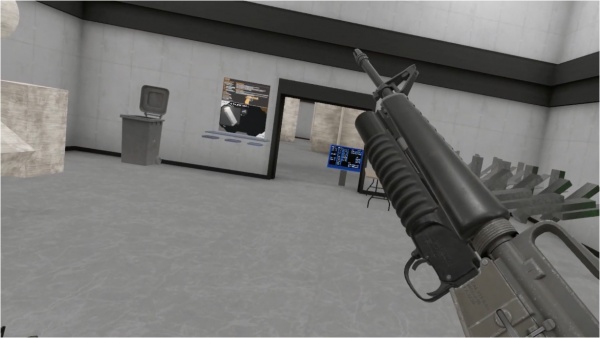
...as it can easily be attached to the appropriate weapons instead. This variant can only be mounted to the "classic" variant of the
M4A1 and, as seen here, the
M16A1.
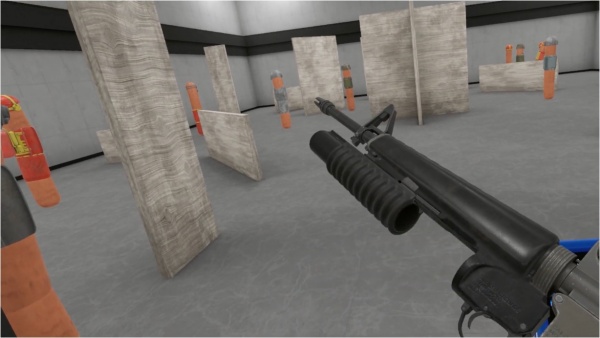
Loading the M203 is a rather straightforward affair; the only thing to worry about is the barrel, which slides back and forth.

Simply shove in a forty-mike-mike of your choosing, then close it up and get to work.
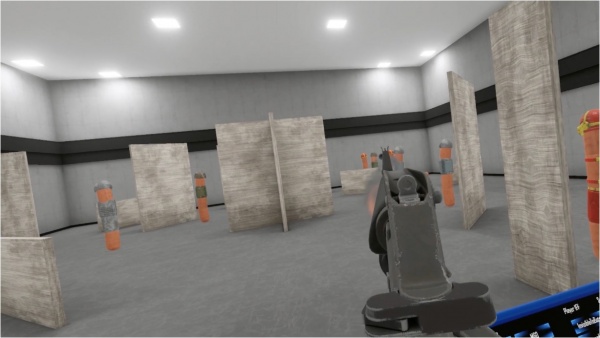
Firing a round at a group of Sosigs; the grenade can just be glimpsed to the left of the front sight.

The effects are more or less what one would expect.
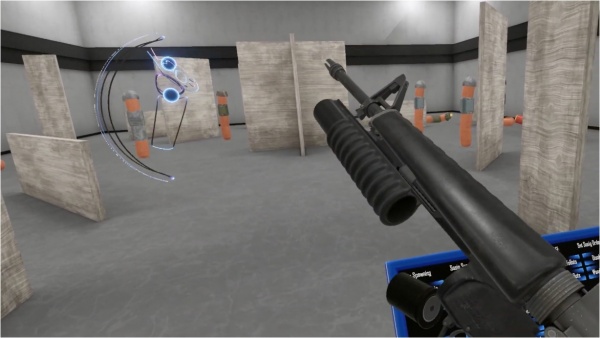
Clearing the launcher works about the same as loading it; just slide the barrel forward, and the spent casing falls right out.
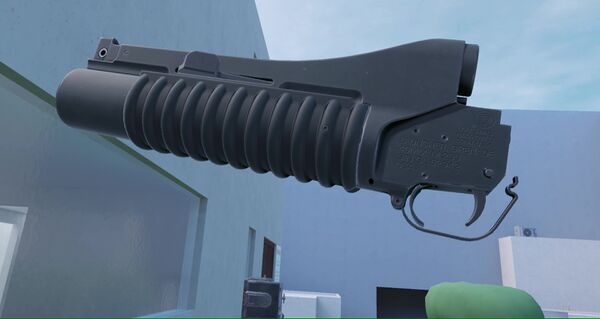
Checking out the new M203A1 just outside the Grill House's central, well, house.
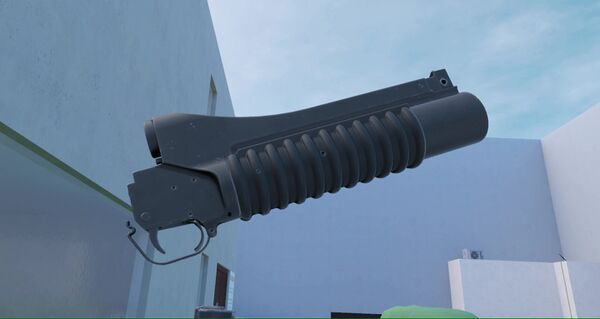
It's about the same as the M203A-nothing, but a tad shorter. Which is pretty much the whole point.
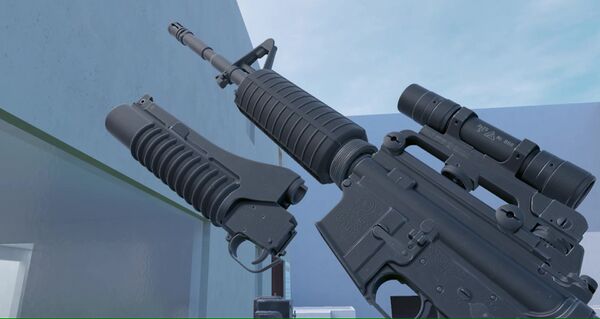
To be more precise, the shorter barrel was meant to optimize it for use on carbines, such as the M4 here.
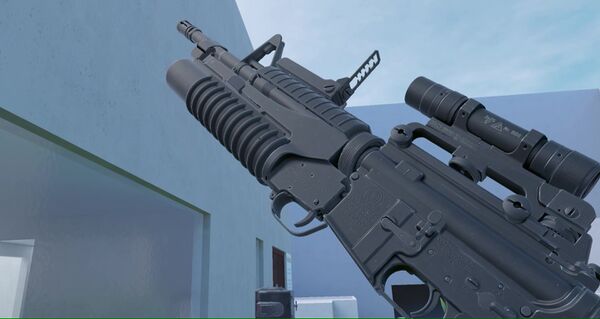
Just tack it on, and bam, the entire lower handguard vanishes. You do get a neat new leaf sight out of the deal, though.

Opening up the launcher...

...popping in an "X1776 FreedomParty" round...
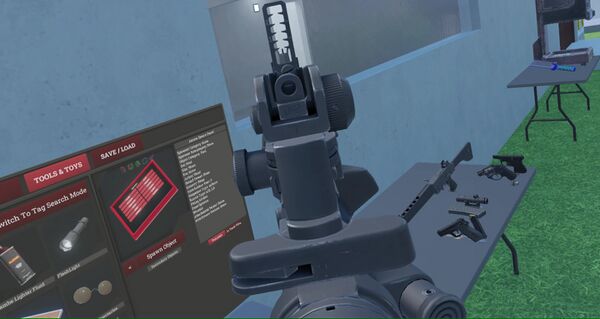
Sadly, as nice as the Colt 3-power scope looks on top of the carrying handle, it blocks basically all the leaf sight notches that correspond to a distance actually achievable on this map, nevermind inside the building itself. No old-school tactical aesthetic for you.
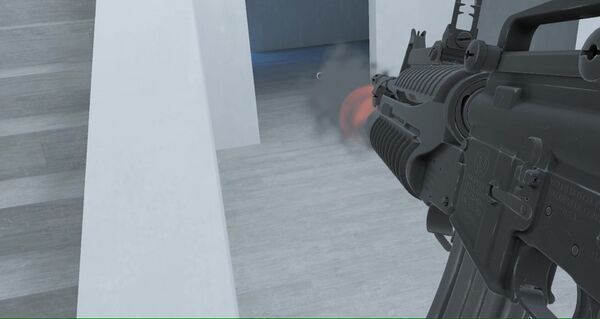
Following a breach that's better off undocumented, an opportunity to use the launcher presents itself - pre-flashing a room before entry.

In case it wasn't made clear before, the X1776 is a flashbang round (with a bit of confetti in it). The flash makes the markings of the carbine and the launcher alike stand out rather nicely.

As it turns out, there were some enemies inside that were successfully stunned. Not in that specific room mind you, just inside.
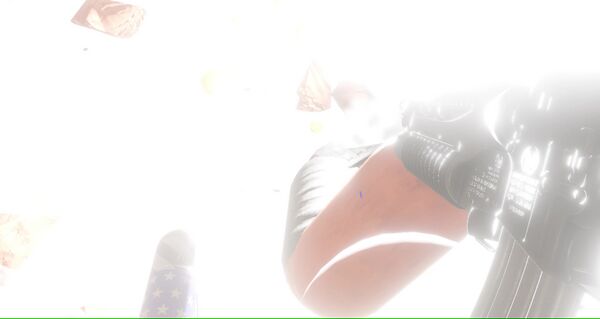
Giving the Sosig another 40, just to make sure he's properly stunned.
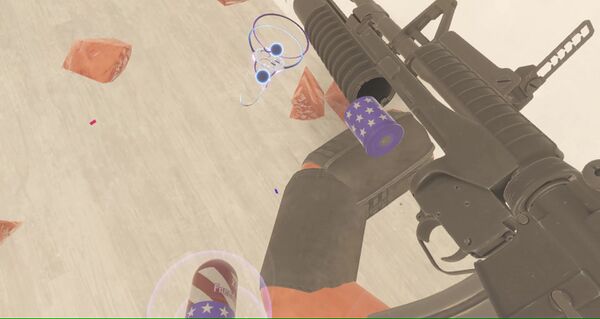
"Hey, command? Yeah, uh, these things are non-lethal, right?"
"...less-lethal? Not less-than-lethal?"
"No, nothing. Just, uhh... this guy shot himself before I could apprehend him." M224 Mortar
The M224 Mortar was added in Update #101 on Meatmas Day 2021, making it the game's first useable mortar. Rather than a static emplacement, the player has full freedom to not only place and angle the weapon, but also select between trigger-fire and drop-fire, making its depiction in H3 one of the more immersive ones.
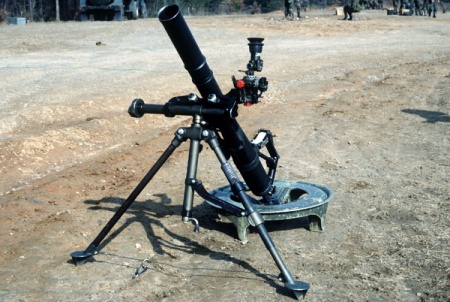
M224 Mortar with M7 Baseplate - 60mm

Casually strolling up to a deployed M224, as though the one responsible for its being there isn't the one who's doing the strolling. To be fair, who'd want to take responsibility for putting down a mortar backwards?
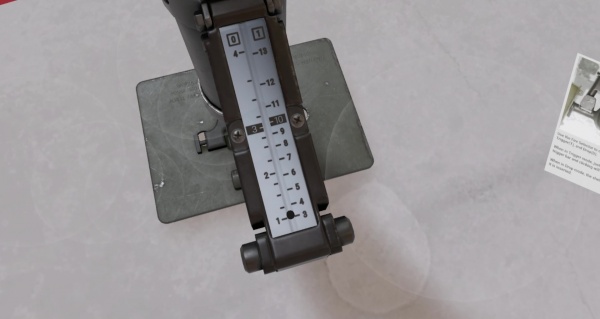
Taking a look at the now-correctly-oriented mortar's ranging slider; while it lacks the real deal's optical sight (and its forward support, possibly to simplify the model, or to free up space for the floating green adjustment arrows seen above), it still has this for more precise aiming. Use with a rangefinder is highly recommended. As a somewhat literal aside, the object off to the right is an instruction manual, which tells you right off the bat that this thing's gonna be fun.
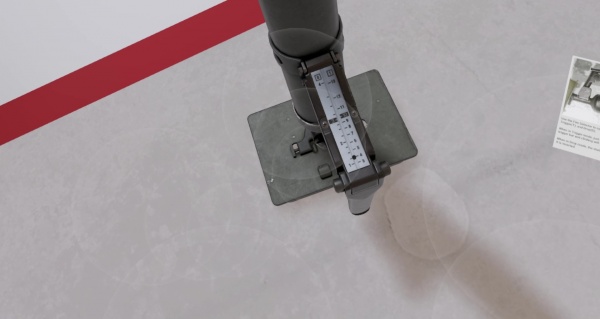
Using the aforementioned arrows to tilt the mortar causes the dot to move up and down the slider appropriately (or, more accurately, for the slider to move down and up against the dot).

Lying down to look at the M224's fire selector; the middle position is "S" (for "safe"), while the top position is "D" (for "drop", indicating that the weapon will fire automatically when loaded), and the currently-selected bottom one is "T" (for "trigger").

Dropping in a shell, comfortable in the knowledge that it won't fire the instant it hits the bottom of the tube. This is an M720A1 high-explosive round; it's one of two types available in-game, though both are M720A1 shells.
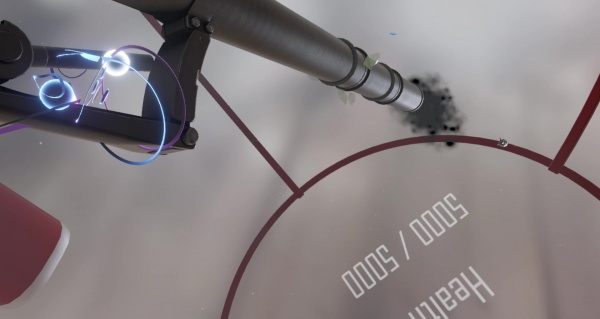
Firing the mortar with a quick pull of the large metal rod that serves as a trigger; not shown here is the spectator-camera options panel, as trying to get an angle that showed both the mortar's trigger and muzzle while accounting for the misalignment between the headset's display and what's actually shown on the monitor is no mean feat.

Even harder is getting an angle that also manages to show the inherent problems with using a mortar inside a not-quite-giant-enough snowglobe.
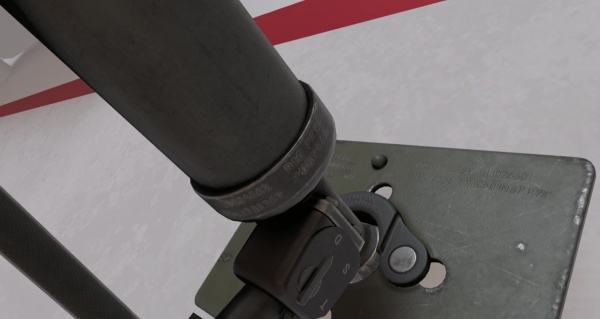
Taking a look at the baseplate's markings; unlike the reference image,
H3's M224 has the smaller square-shaped M8 baseplate, rather than the large, round M7. The bottom of the tube also has some markings, though they're a bit less descriptive; apart from what seem to be a pair of serial or index numbers, the weapon is also marked "BIG BORE" and "PURYEAR", whatever that means.
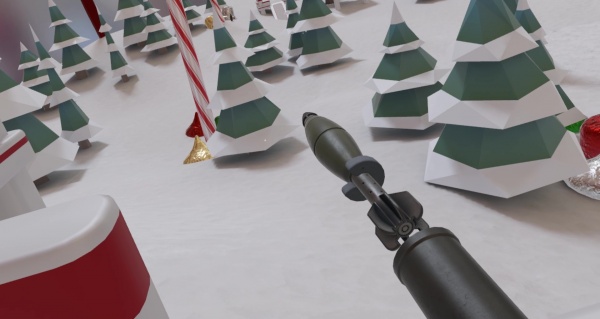
Seeing as indirect fire in a place with a ceiling isn't a great idea, why not try out an even worse one instead? The round shown here is the other type available, an M720A1 with one collar-like propellant charge added; while multiple of these can be stacked onto a round in theory, such an option would be of little value in-game, since the ranging slider only has markings for shells with 0 charges or 1. An attentive viewer may also have noticed the position of the fire selector in the previous shot, giving an idea of just how dangerous this really is.
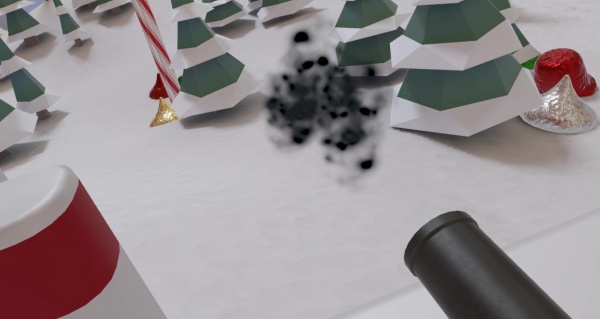
Firing off the high-speed shell; if the mere notion of firing a 60mm mortar offhand standing up wasn't enough to dissuade you from trying it...
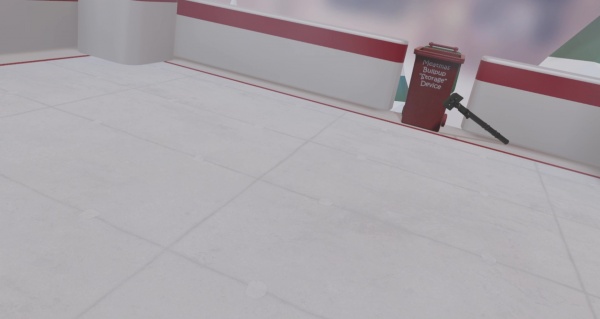
...then perhaps the recoil can.

For a far more functional dumb idea, consider the following: lacking a minimum elevation angle,
H3VR's M224 can be used in the direct-fire role.

It may sound stupid, but hey.

It's about the only real way to hit something other than the glass in here.
M72A7 LAW
The M72A7 LAW was added on Meatmas Day 2020, making it the game's second disposable rocket launcher, and the game's first unguided one.
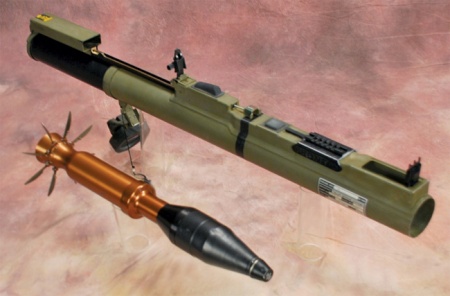
M72A7 LAW with rocket - 66mm

The M72 LAW offers an interesting alternative to the contemporary RPG-7. On the one hand, it's a disposable rocket launcher. On the other hand, you only need one inventory slot for rocket and ammo, instead of two.

The LAW provides a helpful guide printed on the side for how to use it.
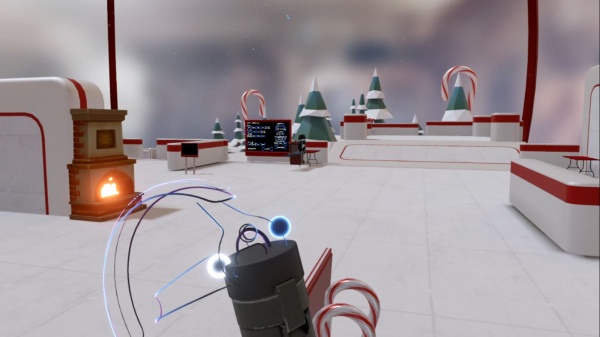
Step one- remove the cover from the end of the tube.
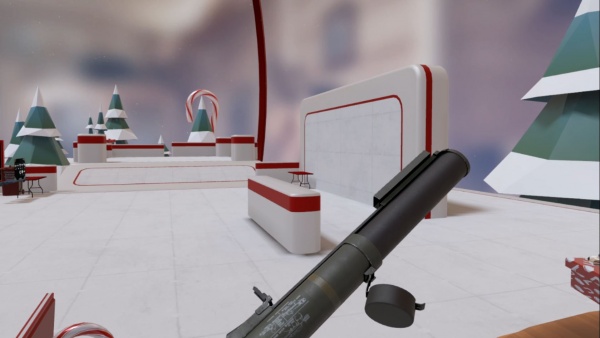
Step 2- after removing the cover, extend the rear of the tube.
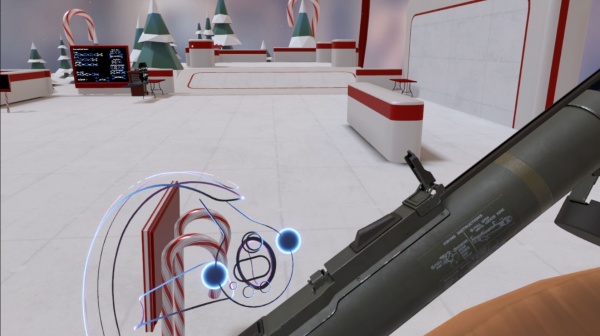
Step 3- click this switch in front of the rear sight to turn off the safety.

Safety's off, rocket's hot!
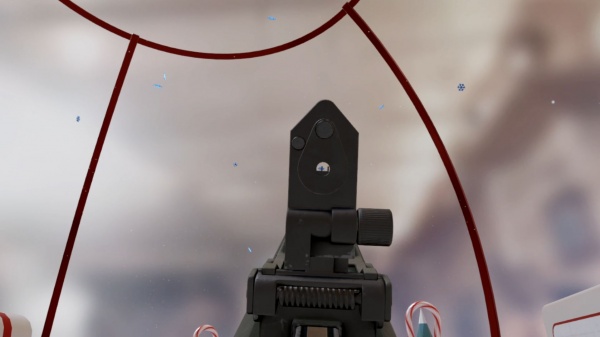
The default irons on the LAW aren't amazing, but then again, these were intended for shooting at light armor, not snowflakes in a snowglobe.
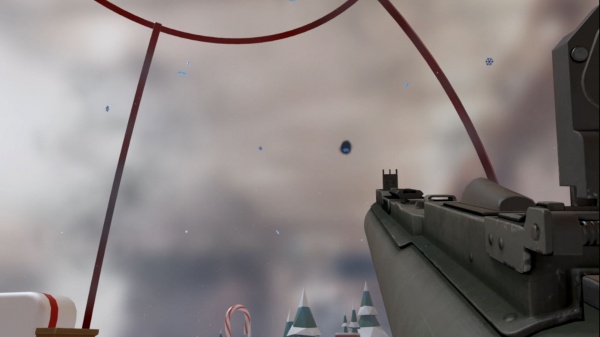
Case in point, the rocket hits just past the snowflake.

An interesting feature of the A7 variant is that it doesn't just use a better rocket motor, it also has an attachment rail for optics. On a disposable rocket launcher. And because the rear sight is in the way, you're going to need something on a riser.

Still, can't argue with results.
M79
The M79 grenade launcher was one of the first weapons added to H3, predating even the name; it, along with a few other weapons, was added to the early prototype stages of the game before it even received a proper name. In the 9th alpha of Update #52, the weapon got a new model and texture set, along with several new ammo types. These include 5 more-or-less normal rounds - an M381 high-explosive round, an M397 airburst round (which bounces off of whatever surface it hits and explodes in mid-air), an M576 buckshot round, an M781 inert practice round, and a CS gas grenade (which was added later, in the same update's 10th alpha) - and 4 more outlandish rounds (all of which have colorschemes and labels more reminiscent of novelty fireworks than of actual military ordnance). These are:
- The "X214 Steelbreaker", a high-velocity armor-piercing saboted round,
- The "X477 Cornerfrag", a low-yield fragmentation grenade that airbursts 4 meters from the launcher's muzzle, intended for blindfiring around corners in close quarters (hence the name),
- The "X666 Baphomet", essentially a 40mm version of the Dragon's Breath round,
- and the later-released "X1776 Freedom Party", a 40mm flashbang that releases red, white, and blue confetti upon detonation.

M79 grenade launcher - 40x46mm
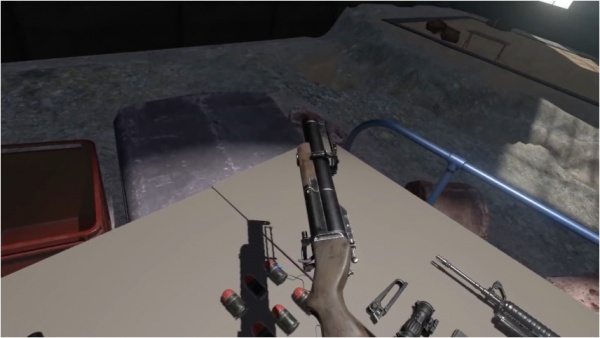
Admiring the M79 under the light of the warehouse's roof windows. Note the trigger guard; for whatever reason, this version of the launcher had a trigger guard that flopped around freely. This is probably due to this old model having an articulated winter trigger guard, to allow usage with thick gloves without adding a large winter trigger, but was apparently interpreted to flaccidly wiggle about instead of locking in place.
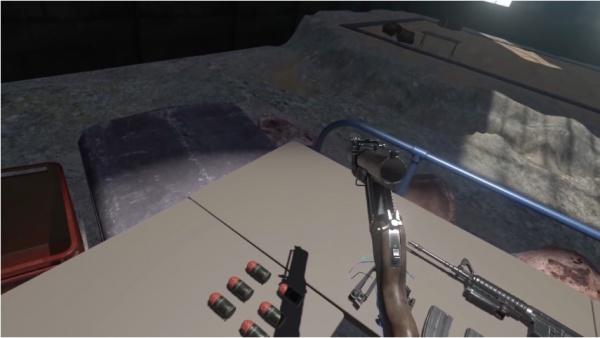
Popping open the launcher. At full size, it can be seen that the for-some-reason-red rounds on the table have holes in the end of them; this shows that they're modeled after Airsoft 40mm rounds, which use these holes to send forth a shower of plastic BBs on impact.

"I've got an idea. Instead of just
throwing grenades at them, how about we send them grenades in another manner?"
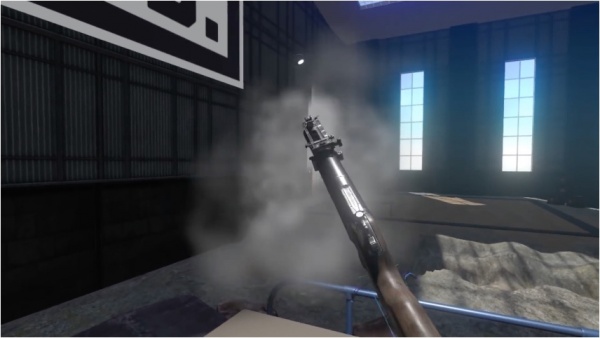
...and blasting away the nefarious
Wall-1000.
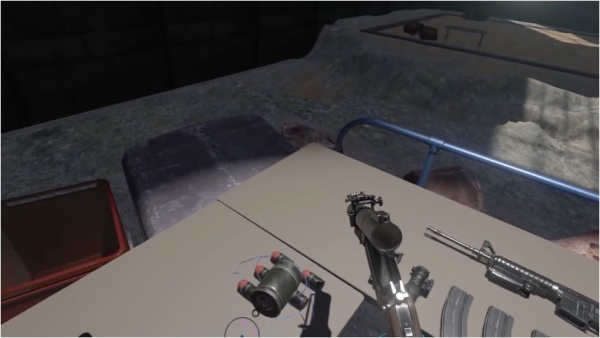
The work done, it's time to remove the spent casing, and take a much-needed vacation.
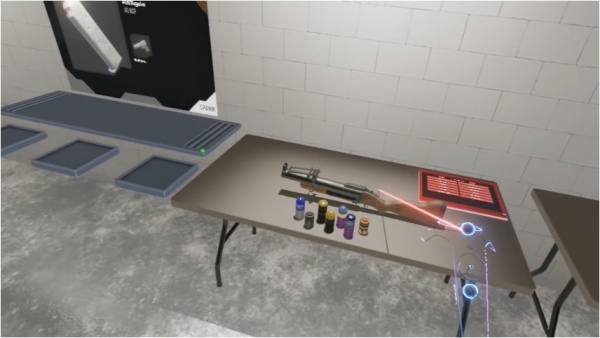
The brand-new M79, along with its new, non-airsoft ammunition. From left to right: the M781 trainer, the M576 buckshot, the M397 airburst, the M381 HE, the X214 Steelbreaker, the X477 Cornerfrag, and the X666 Baphomet.
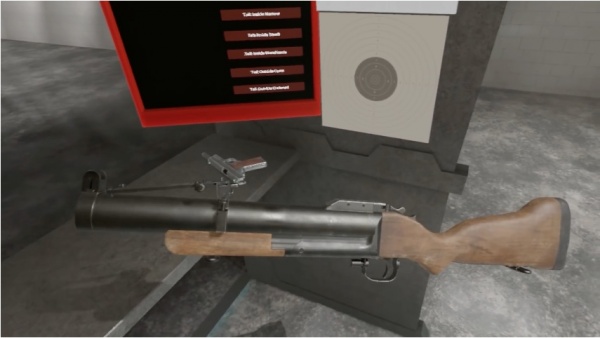
A closer look at the shiny new M79, complete with its gorgeous new properly-secured trigger guard.
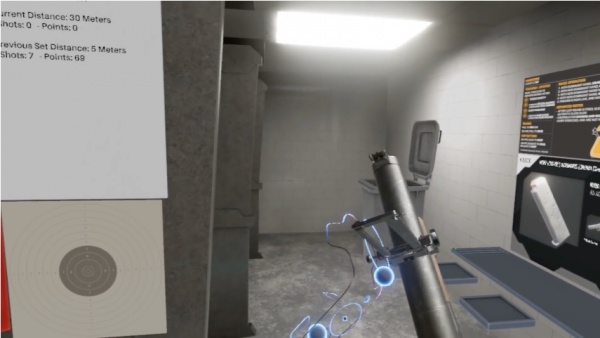
Showing off a feature of the M79 that is all but entirely unique to
H3: not only does its sight leaf fold up...
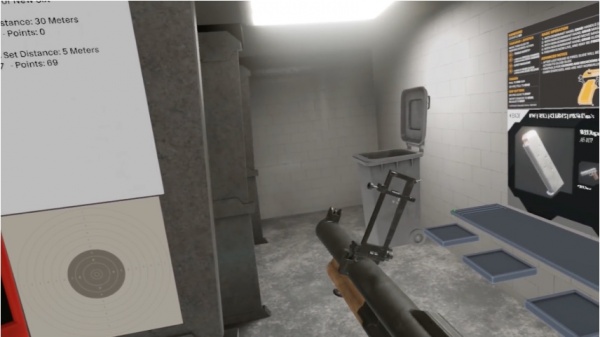
...but its rear sight notch is actually adjustable for distance. This runs contrary to the model seen in most video games, where the protagonist generally just picks a random distance and goes with it. This feature was present on the older version of
H3's M79 as well.

"Pardon me, sir, but this is an indoor range, so I would
really recommend against that."
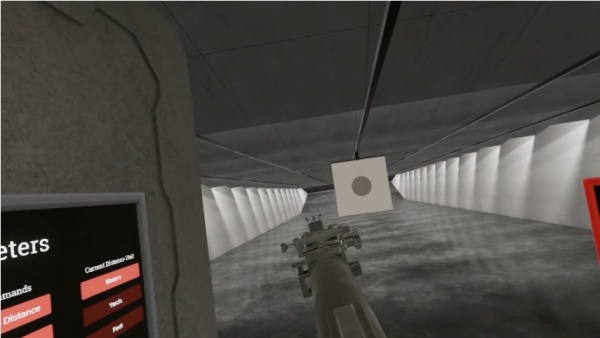
"Sir, what are you doing-"

One RSO heart attack later, a spent casing pops itself out of the M79.
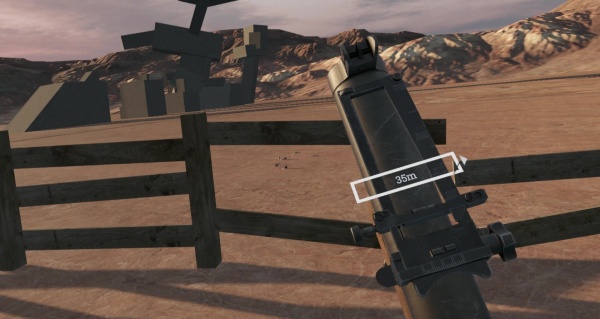
Like the
China Lake, the M79's adjustable rear sight got even more adjustable in Update #99's sixth alpha build. Folded down, it's a rather strange 35-meter zero...

...while the folded-up positions go from 100 meters to 350 in 50-meter increments, capped off with a 375-meter maximum.
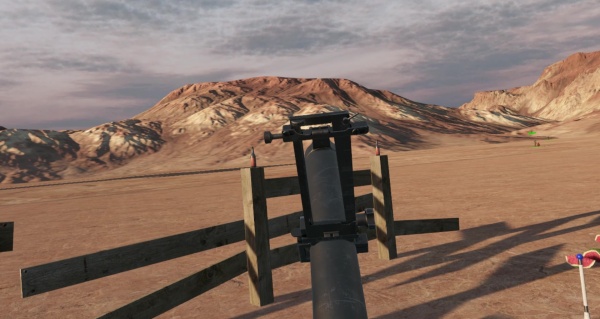
Needless to say, actually using this position requires holding the weapon at a comically absurd angle. Not quite a mortar, but close enough - at least, until the game got an actual mortar a couple months later.
Milkor MGL-140
Along with the M320, Update #52's 10th alpha brought along a Milkor MGL; specifically, an MGL-140, a later model with longer chambers to allow for the use of more varied ammunition types.

Taking a look at the MGL's left side...

...and the right. The small white markings by the front of the cylinder are numbers, ranging one through six.
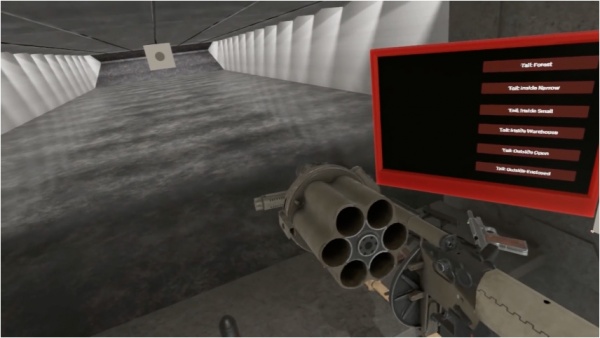
Opening up the launcher, showing six chambers' worth of potential. So, so much potential.
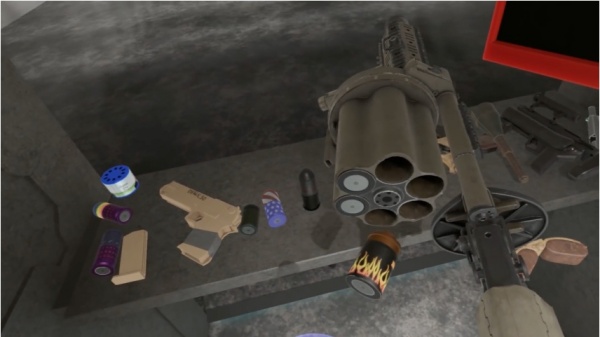
Loading up the MGL with some "X666 Baphomet" rounds. Although, given the color scheme, one wonders if perhaps a better name would've been the "X122 Flavortown".
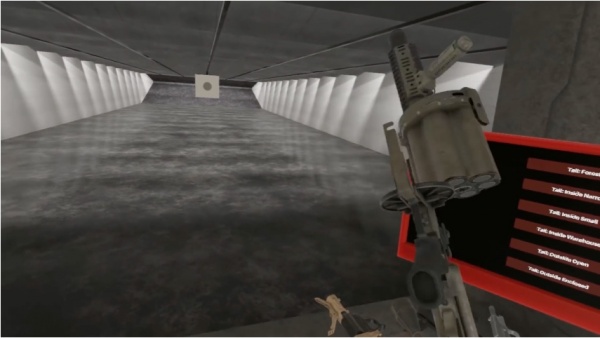
Closing the MGL with a flick of the wrist, in spite of all sound logic. This is possible because the MGL is actually built off of the same code as the game's double-action revolvers...
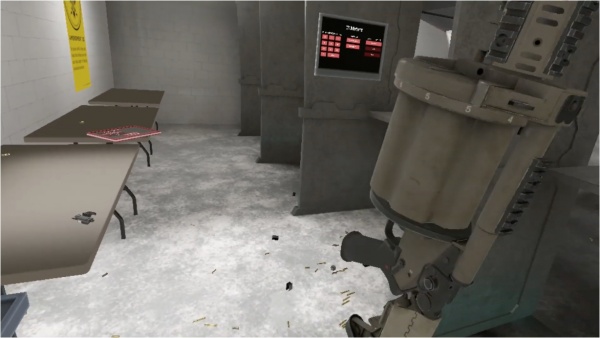
...a more curious side effect of this being the ability to spin the weapon around like some sort of
drunk, Scottish ocelot.
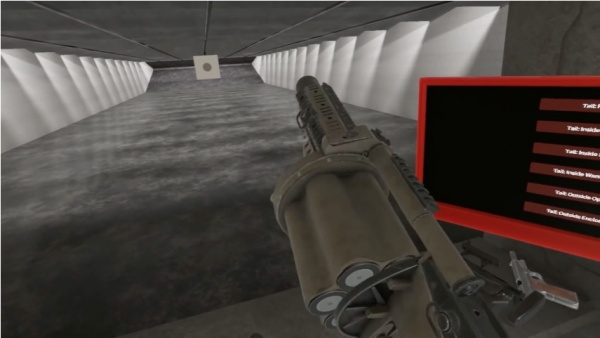
Closing the launcher again, this time with a much more advisable push.
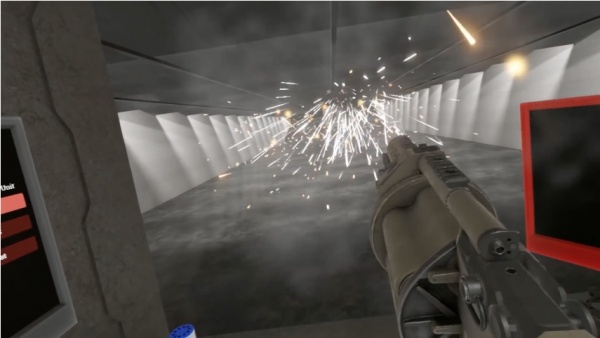
Celebrating this advancement in weapon knowledge by filling the air with burning magnesium.
Mk. 19 Grenade Launcher
The Mk 19 Grenade Launcher was added in Update #101 for Meatmas 2021; much like the Browning M2 that came before it, it is a fictional man-portable version, with "chainsaw"-style grips.
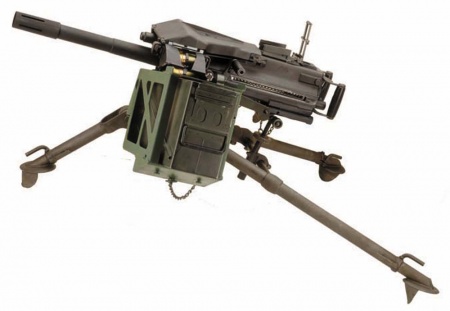
Mk. 19 Grenade Launcher - 40x53mm
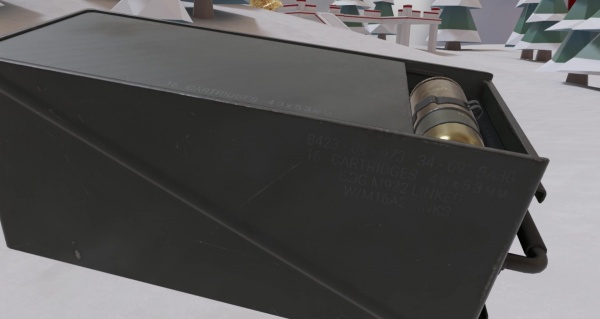
Hmm... a 16-round belt box of 40x53mm grenades? This can only mean one thing...

A surprise that doesn't surprise anyone who read the text above this!

Marvel at its expectedness! Bask in the glory of its predictability! Be amazed at how it took nearly two months to upload these screencaps for some reason!
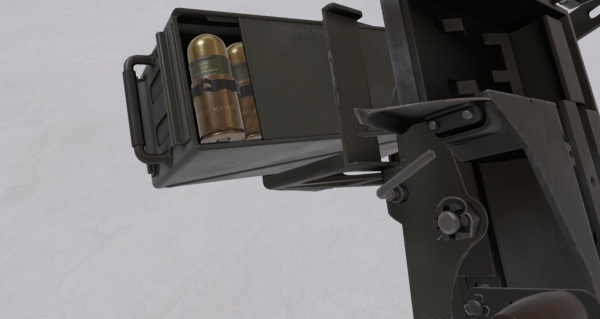
Right, with that out of the way...
Loading a belt box into the launcher's bottom-mounted bracket; while 16-rounders aren't standard for the Mk. 19, the usual 32- or 48-round boxes would require this bracket to be substantially larger, making the already-bulky weapon take up even more space - space that the gift box it comes in simply doesn't have.
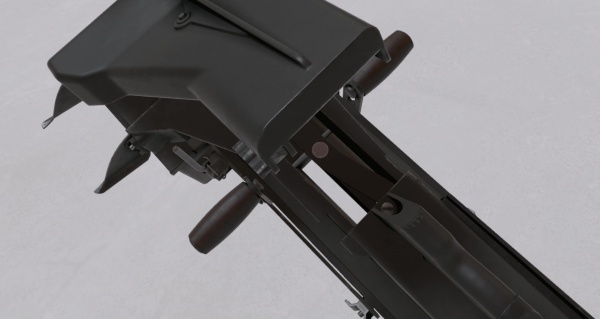
Opening up the rather large top cover.
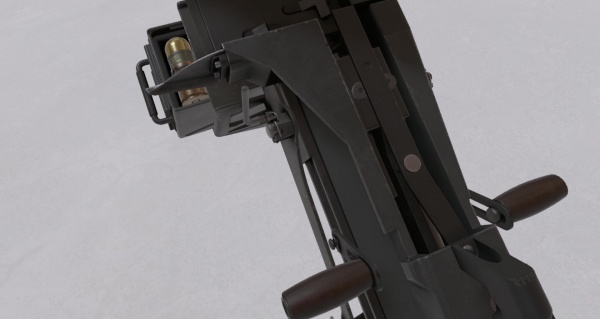
With that out of the way, the operation of locking back the bolt can be seen in greater detail. Not in any way necessary, but fun nevertheless.
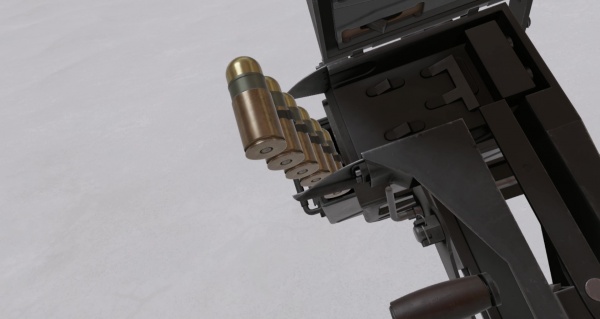
Pulling out the belt from its box...
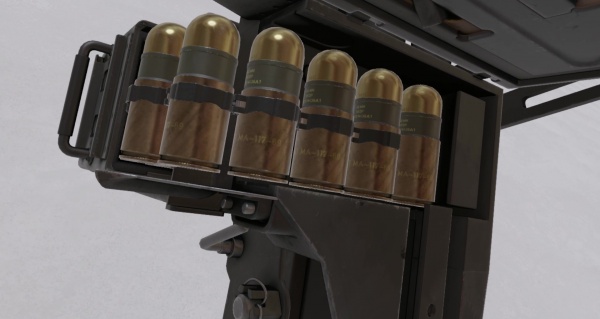
...and loading it into the feed tray, pausing momentarily to examine the rounds; aside from some manufacturing information, the markings denote them as M340A1 HEDP (High-Explosive Dual-Purpose) rounds, meant for dealing with armor and infantry alike.
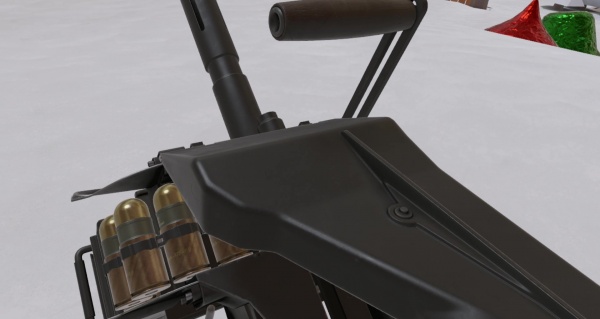
Slamming the top cover shut. Although, with a size and shape like this, calling it a "lid" might be more appropriate.

Once all that's been handled, there's only one thing left to do:
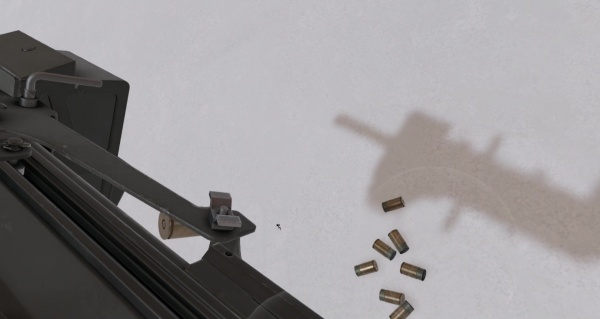
Looking away from the direction that the automatic grenade launcher is firing (a sentence that shouldn't really ever be uttered in seriousness) shows that it spits its spent cases straight out the bottom, along with some disproportionately tiny-looking belt links.
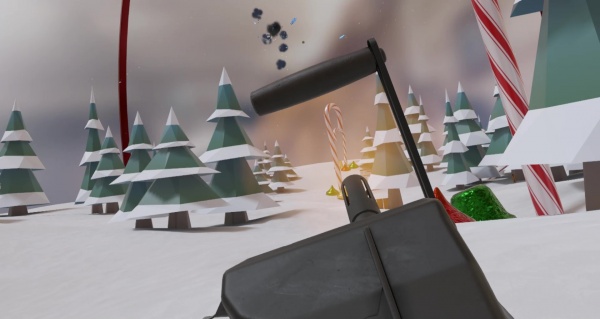
While the ammo is meant for armor and infantry, it also proves decently effective against the scene's floating crystal snowflakes once you get the hang of point-shooting it. The main draw of this being that, if you can convince yourself to forget that you're trapped in a giant glass prison, you can pretend you're firing air-bursting shells out of a WWII-era AA gun.
Orion Flare Gun
The Orion Flare Gun is available in-game, having been added in Update #15. While it is capable of firing 12 gauge shells in-game, doing so with any sort of high-pressure shell (i.e. anything other than flares, "Cannonball" rounds, and Dragon's Breath shells) will destroy the flare gun, rendering it useless. However, Update #17 added a fictional steel-framed version capable of handling high-pressure loads. Originally both versions were classified as "shotgun" in game for the sake of random weapon spawns, but this classification was later removed from the normal version due to this randomly dooming runs of game modes that started the player with a random shotgun before the player even did anything.
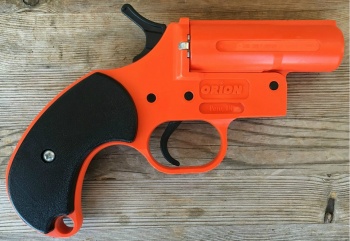
Orion Flare Gun - 12 gauge
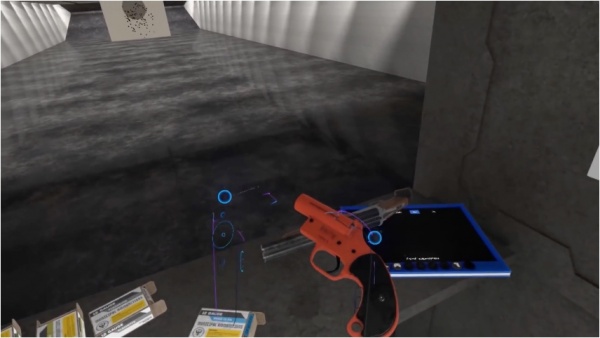
Behold, the Orion, in something not even remotely resembling its natural habitat.
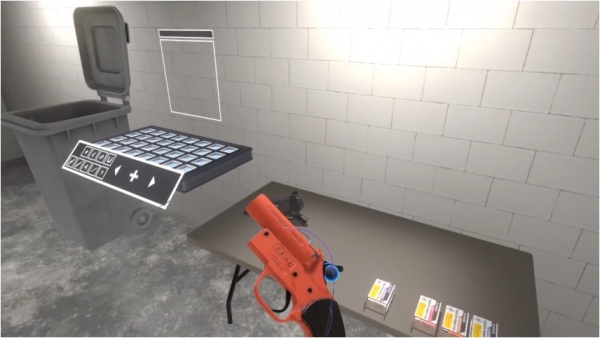
A closer view, which shows that the frame is marked "Saiph"; this is a joke, as Saiph is one of the stars that makes up the Orion constellation.
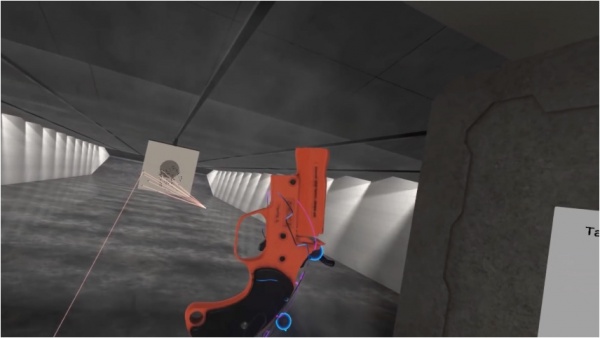
Unsurprisingly, a plastic flare gun doesn't hold up well when subjected to over 10,000 PSI (over 68,000 kPa) of internal pressure. Also note the red streaks in the air; these are bullet trails, which can be toggled on and off at will through the options panel. Unusually, the options panel in
H3 is actually a
physical object.
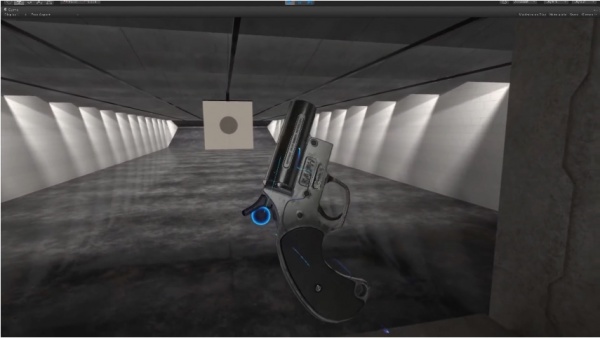
The fictitious "HP" (high-pressure) version of the Orion...
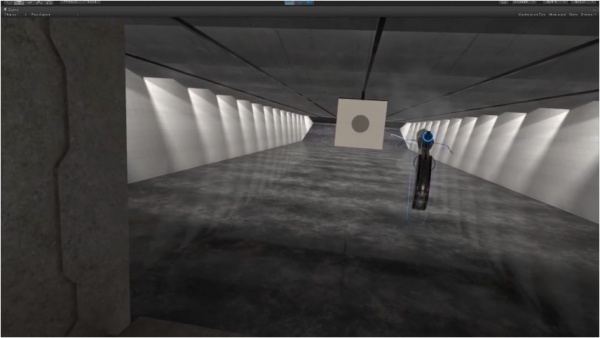
...which fares considerably better when firing high-pressure shells.
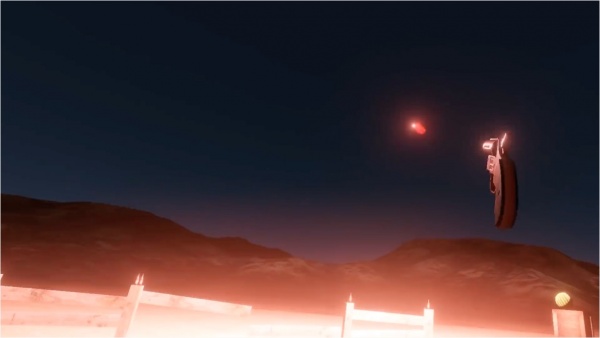
The release of Update #76 gave a rather substantial rework to several of the less-useful 12 gauge ammo types, flares among them; aside from gaining the ability to set enemies on fire (and a rather substantial improvement in terms of efficiency and performance), they gained the ability to illuminate the area around them, an ability which many gun-launched flares in video games seem to lack.
Panzerfaust 3
The Panzerfaust 3 was added in the Meatmas 2023 update.

Opening up the anteantepenultimate box, and discovering two separate objects.
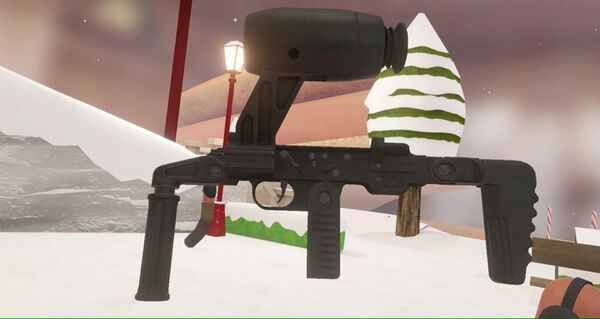
Taking a look at the Panzerfaust 3. At least, the game calls it that - doesn't seem like much to me.
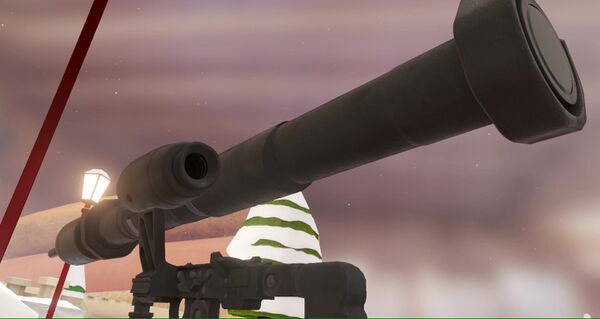
Maybe the second object in the box will help.
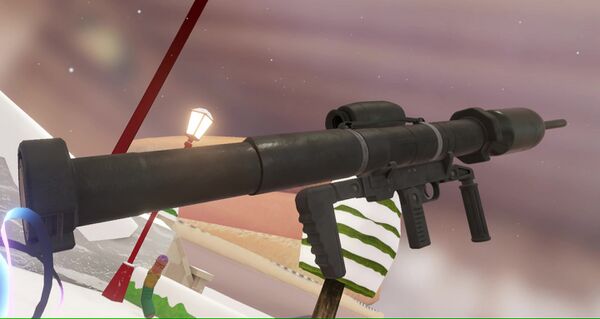
There we go, much better! (Contrary to common assumption, the Panzerfaust 3's tube is not reloadable - a "round" is the entire launch tube assembly, with the gripstock being the only reusable component; this means that it counts as the launcher in-game, forcing it to be stored in the larger shoulder slots in spite of its size when unloaded.)
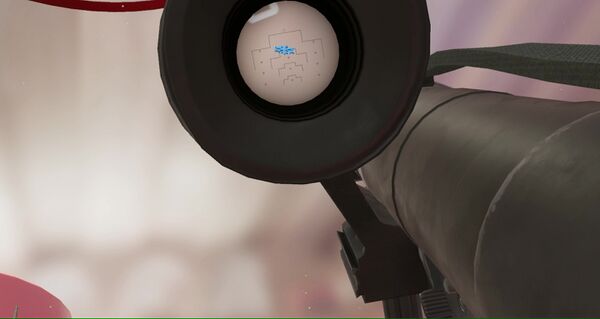
Sighting up a crystal snowflake; sadly, no information is provided regarding the meaning of all these markings...

...so you kinda just pick one and hope for the best.

As mentioned, the launch tube is non-reloadable, so once it's been used, it serves no real purpose.
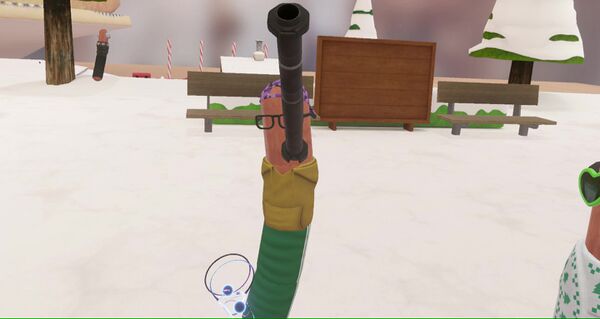
Well, apart from annoying the local populace, that is.
Potato Cannon
Added in Update #88, the Potato Cannon, while far from the most conventional weapon in the game (though there are plenty that are more unconventional), it meets the strict definition of a firearm. This weapon is based on a typical homemade cannon using PVC pipe and ignited using a barbeque lighter and some aerosolized hairspray as fuel. To make the cannon more wieldy and closer to a proper weapon, the lighter is mounted directly onto the cannon and is used as a makeshift trigger and pistol grip, rather than simply poked through a touch hole. As real life examples of homemade cannons are potentially dangerous, the developers repeatedly state not to attempt to do some of the things that are possible with the in-game Potato Cannon; this includes using the spraycan that comes with the cannon as a flamethrower device.
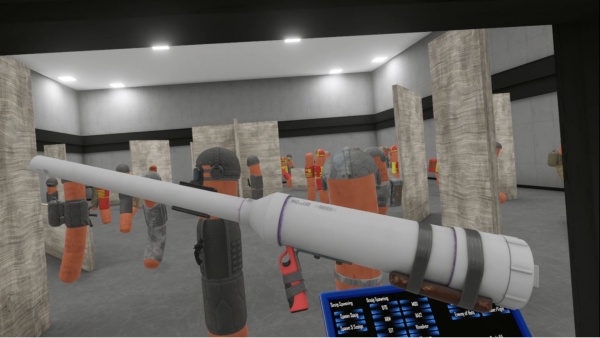
The infamous Spud Gun, in all its backyard hooligan glory. Made of PVC pipe, a barbecue lighter jammed into the middle, and a few tactical rails glued on - we'll get to those later.
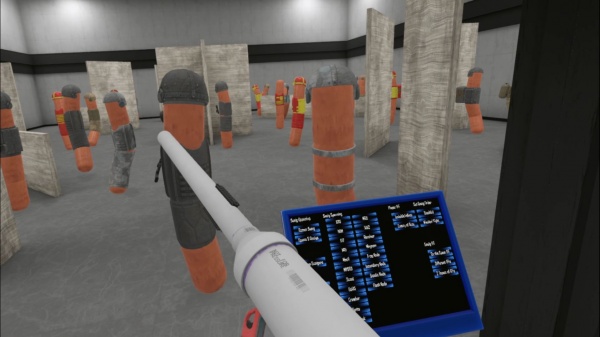
A closeup of the text on the piping; it reads "NOT FOR PRESSURE." Humor aside, PVC is typically not meant for high-pressure applications; potato cannons can get away with this by virtue of having a relatively low pressure from the hairspray fuel compared to industrial applications, though explosive failures are not unheard of.
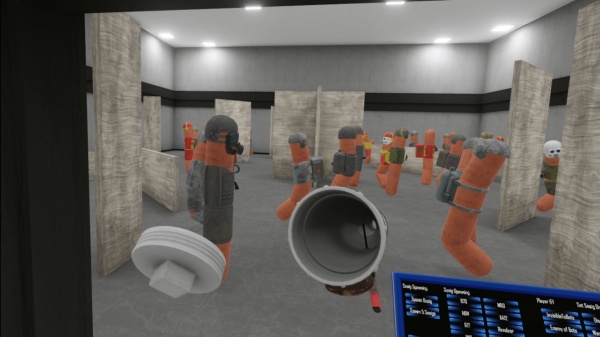
The end cap is removable for fueling; looking inside, one can see the tip of the lighter poking out.

Pulling the trigger on the weapon causes sparks to appear in the combustion chamber.
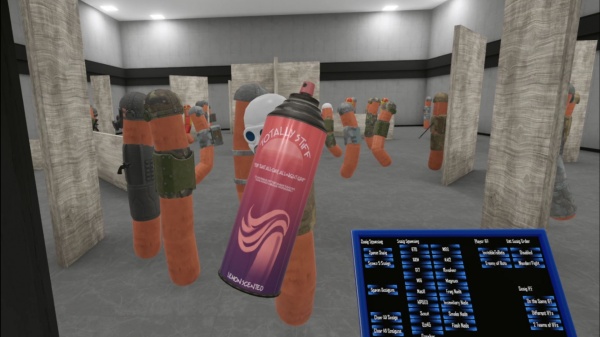
The cannon comes with its own hairspray can, where apparently sosigs with hair do exist in the world of H3VR. This brand of "TOTALLY STIFF" hairspray has a warning that reads: "IF HAIR REMAINS STIFF FOR LONGER THAN 24 HRS PLEASE CONSULT A MEDICAL PROFESSIONAL".

Fueling the potato cannon; the amount of spray used does affect the power of the cannon, though there seems to be an upper limit as the cannon does not explosively fail if a ton of spray is used.
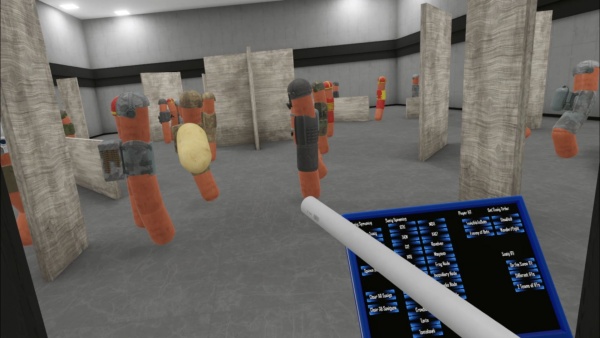
Loading a 50mm Potato into the muzzle.
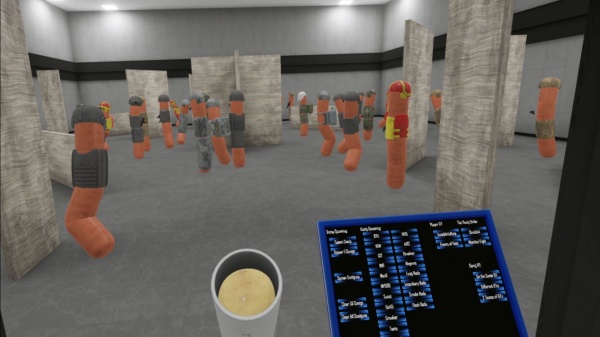
The potato just barely pokes into the barrel; normally, one would jam the potato down near the combustion chamber for best results, but the cannon doesn't come with a ramrod, and but all that's really needed is an airtight plug.
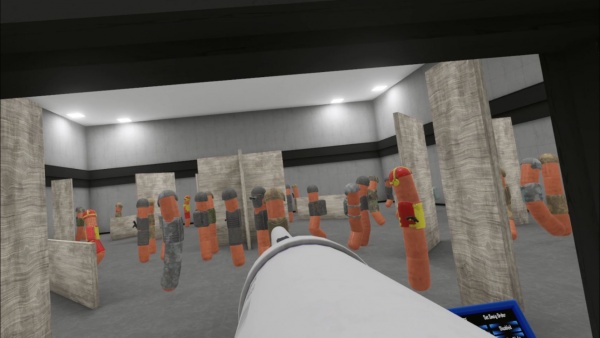
Taking aim with the potato cannon; a sosig is about to experience a potato mashing.
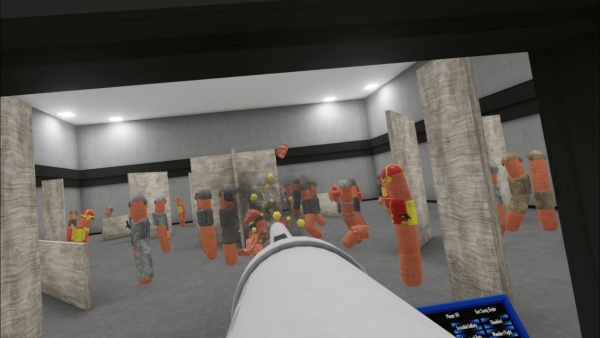
At full power, a potato can have lethal results, as sosigs explode in a shower of mustard.
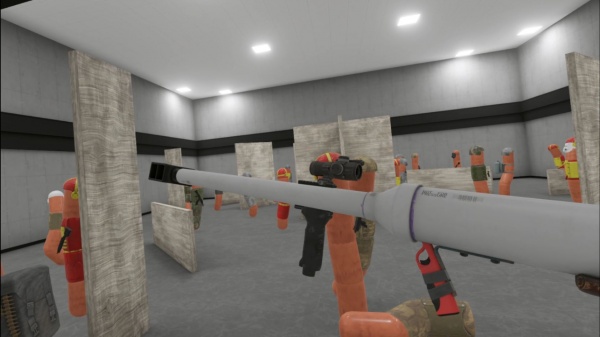
With the aforementioned rails, any standard attachment can be used with the potato cannon; even muzzle devices are useable, though they must be removed prior to loading.
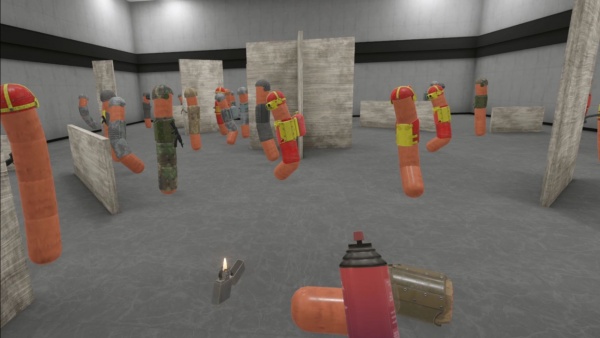
And on today's episode of "Do NOT try this at home"...

The spraycan can be used as an improvised flamethrower when held near an open flame.

And on next week's episode of "No seriously DO NOT TRY THIS AT HOME"...
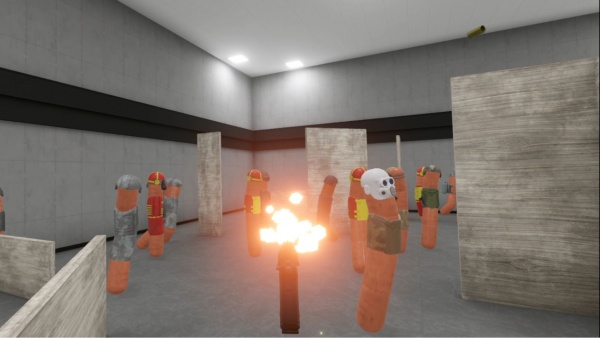
In a pinch, the spray can can also be used as a firebomb when shot at.
QLB-06
The QLB-06 was added on Day 24 of the Meatmas 2022 Advent Calendar event, with the distinction of being the game's first grenade launcher fed by detachable magazines.
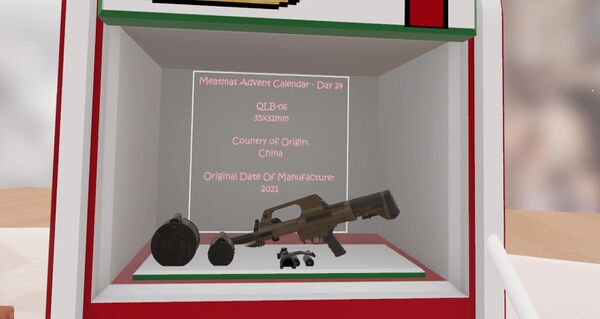
And on the penultimate day, Santon delivers a drum-fed grenade launcher. The drums aren't actually flat on the bottom (as convenient as that would be for resting them upright); the white part of the box's floor just doesn't line up with its hitbox.
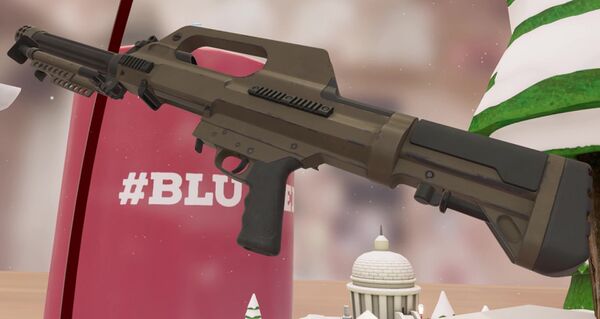
Examining the QLB. It may not be quite as impressive as
its predecessor, but it's definitely more conventional-looking.
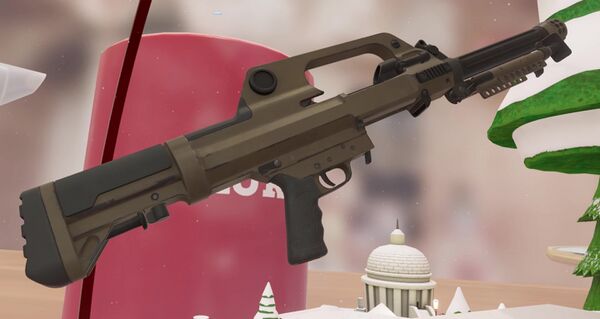
And certainly a whole lot more portable.

Disengaging the safety; as a consequence of its re-work into a more man-portable form, the QLB-06 ditched the QLZ-87's full-auto functionality. A shame, to be sure, but the consequences of bad spray control with a 35mm grenade launcher aren't really something you can overlook.
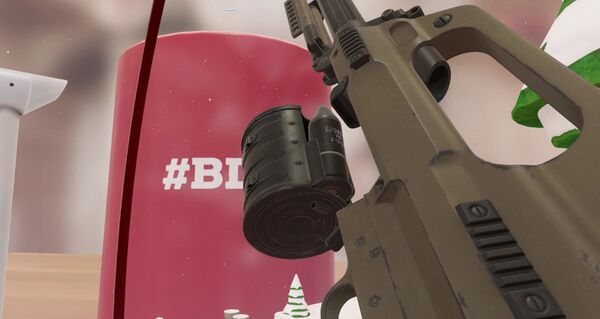
Loading in a 6-round drum...
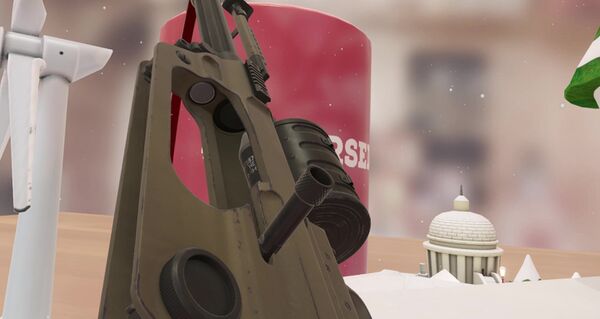
...and racking the rather large folding charging handle to chamber a DFS87 HE round. The markings on this round imply that it's for export, if only because they use letters that most people outside its country of origin can actually read.
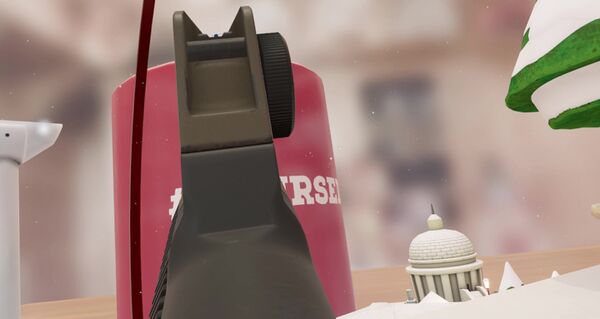
Aiming the QLB; rather than an adjustable leaf sight as one might expect, the QLB's only irons are a simple pistol-style notch-and-post setup.
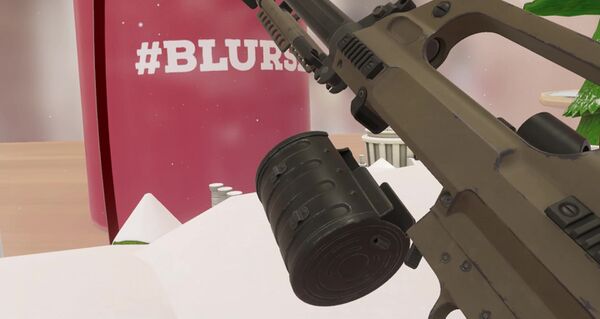
And it definitely does. This is absolutely the first and only time that an empty drum was removed. It totally didn't take, like, 20 rounds to hit that snowflake.
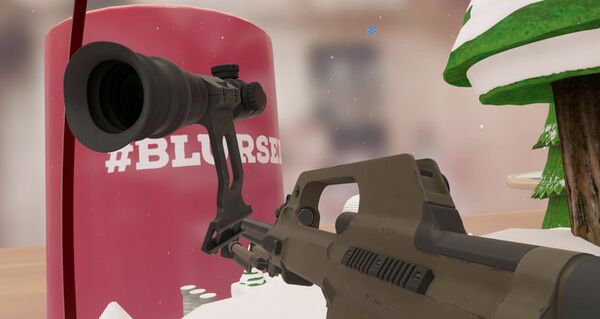
Should you need an actually-sensible means of aiming a grenade launcher, the included scope would be a good bet. It'll mount to any standard Picatinny rail, but the QLB's the only gun that comes with one at the right angle to make it not look stupid.
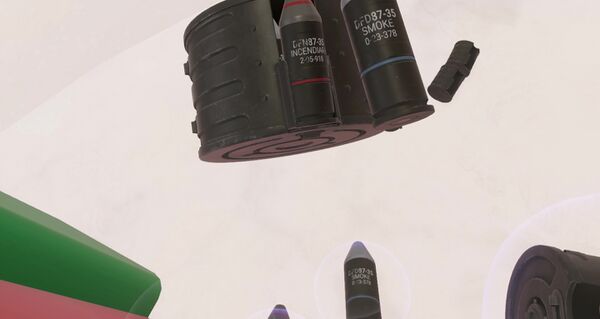
Loading up a 15-round drum with some more specialized ammo - DFD87 smoke grenades, and DFN87 incendiaries. On the topic of ammo, this is also why the QLB was the only Meatmas gift in 2023 that needed its own independent main-branch update - without that, the newly-added ammo wouldn't've been spawnlockable, and the amount of fun that could be had with it per load of the scene would be correspondingly rather low.
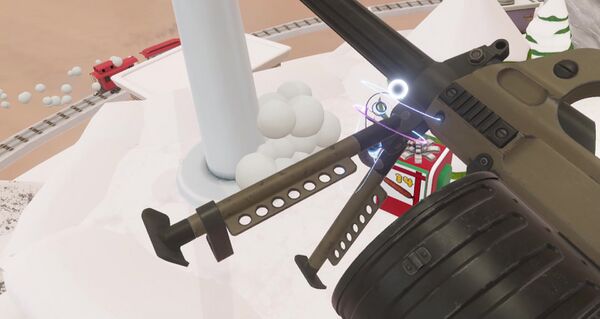
And, for a final bit of preparatory work, the bipod can be unfolded, for that little extra bit of stability we all need in our lives and grenade launchers.
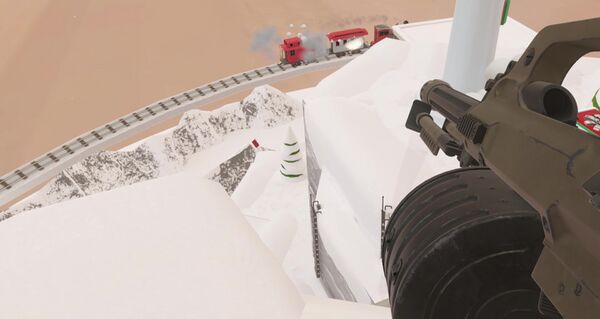
And timelines, apparently, given how this shot of the two specialty rounds' effects seems to have come from a couple seconds before the last one. Sadly, neither of the bipod's legs extend into the fourth dimension, so it offers no real benefit in terms of temporal stabilization.
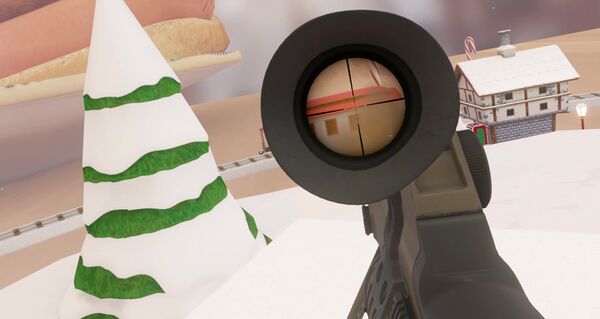
Drawing a bead on the still-unbothered train, and giving a good view of the scope's reticle in the process.

Sadly, no combination of smoke, HE, and incendiary shells, precise aim, and temporal instability can stop the mighty Choo-Choo Train. All one can do is surrender, and hope to be spared.
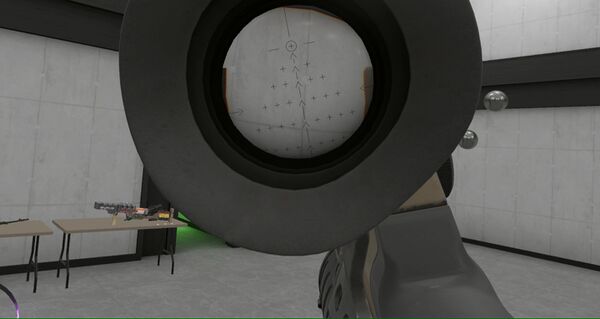
Update #113's third experimental build rebuilt several of the scopes that the previous builds hadn't yet gotten, the QLB-06's among them; along with the new behavior and adjustment options, this particular optic got a new reticle. Since specific info on Chinese optics is nearly impossible to find, this reticle is openly declared to be a work of fiction based on similar GL scopes.
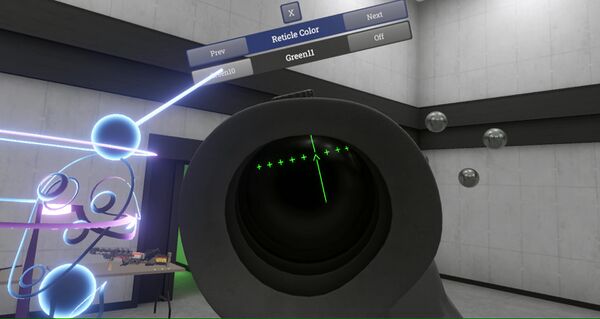
Oh, and you can light it up in green, with 11 brightness settings to boot. This also shows an aspect of the new scope behavior - this shot was taken well outside the scope's permissible eyebox, so only the reticle is visible.
"Remote Missile Launcher"
In keeping with the Metal Gear Solid theme of Update #99, the "Remote Missile Launcher" is loosely based on that game's "Nikita" guided missile system. It is a slow-moving, user-guided missile that is controlled by a joystick attached to the launcher itself.
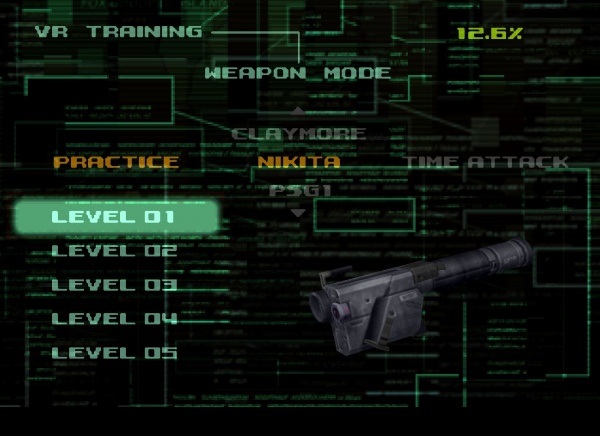
The Nikita, as seen in
Metal Gear Solid's VR Missions Menu, for comparison.
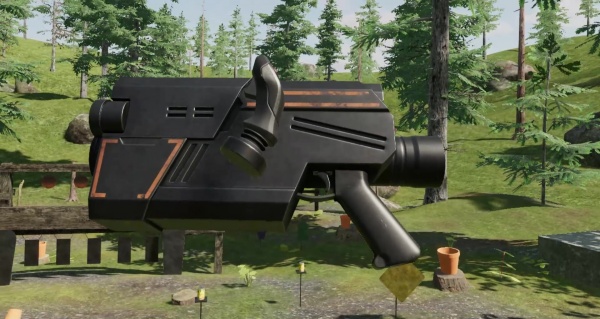
Taking a nice, peaceful range day with the Remote Missile Launcher.
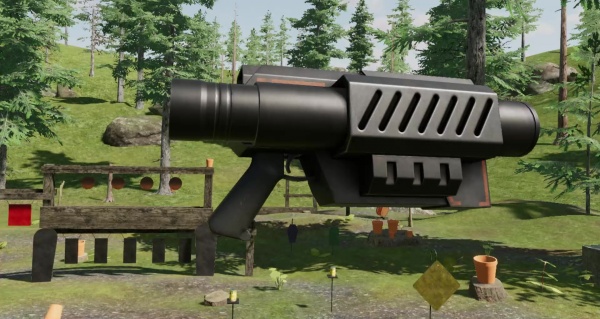
After all, nothing says "casual plinking" like a high-tech guided - eh? It doesn't look like the reference image?
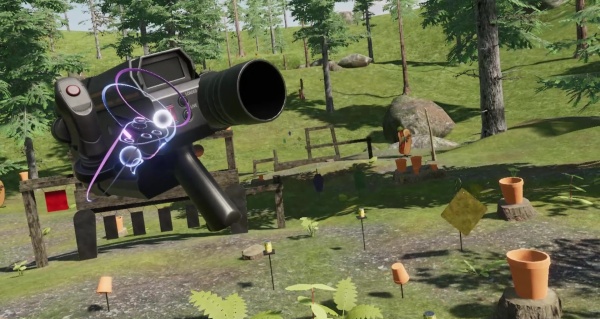
Hang on a sec, lemme get the instruction manual... okay, it says to flip the switch on the control panel, and...
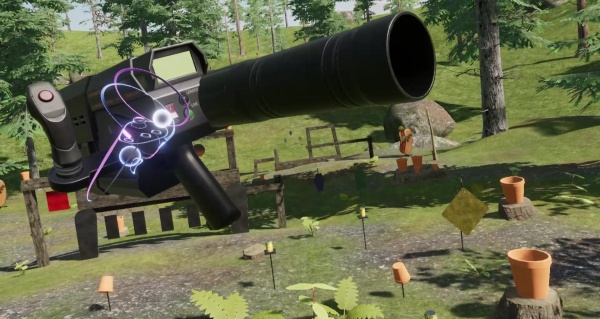
...oh. Yeah, that's better.
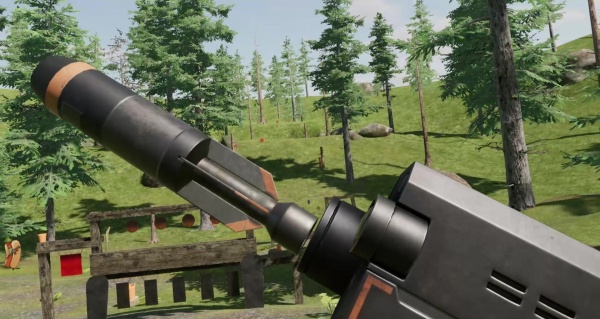
Loading in one of the Remote Missile Launcher's remote missiles. These are rather large (roughly 100mm), as one would expect from a guided missile; they are, however, a bit unusually short for such a device, presumably so they still fit in the launcher when it's collapsed.
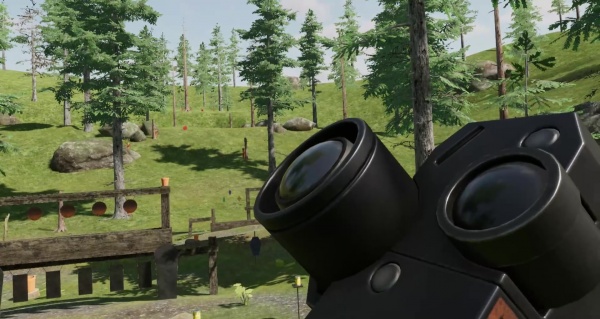
Once loaded, they sit more or less flush with the end of the launcher; only the camera remains visible.
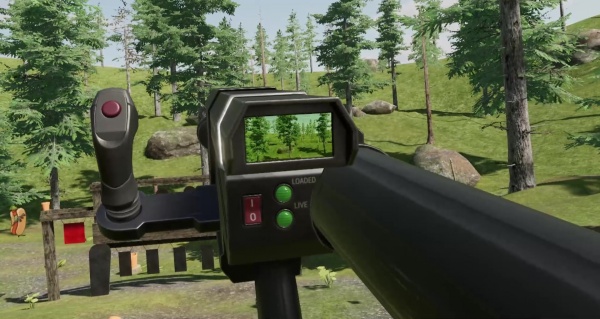
Speaking of the camera, here's the other end. While subtler than the other components, this also extends when the launcher is active (presumably to protect it from damage). As for the lack of a reticle, that'll make sense in a second.

Firing the launcher creates a suitably impressive cloud of smoke; the camera is unaffected by this, however...

...since, as mentioned, the camera is actually in the nose of the missile. As seen here, this allows for direct control of the missile via the joystick on the left (with the Big Red Button allowing for temporary speed boosts); silly as it may seem, some real guided missile launchers (like earlier versions of the
AT-3 Sagger, and the notoriously dismal
Shorts Blowpipe) do in fact use joysticks for control. This setup would realistically classify it as a TV-guided missile (TVGM for short), a rather uncommon system for a man-portable launcher (though one shared by its inspiration); older guided launchers generally used a simpler form of MCLOS (manual command line of sight) guidance with a flare or similar visual aid allowing the user to track the missile as it flew, while more modern SACLOS systems' missiles know where they aren't and can guide themselves wherever the user indicates. Also like the original Nikita, the missiles that the RML fires are
incredibly slow (to make guiding them easier, and to aid in its use as a rather unorthodox reconnaissance tool), to the point that they straddle the line between actual missiles and rocket-propelled drones. Of course, as this image shows, even a relatively slow missile can still be tricky to guide without enough practice.
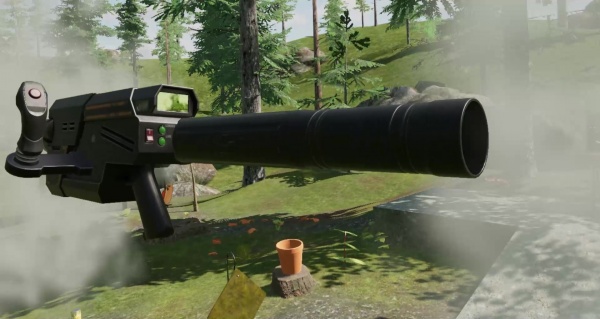
Firing another missile, while rather irresponsibly looking in a completely different direction; this shows off the launcher's rather tame backblast (which has no effect on gameplay), and how the "LOADED" indicator light turns off slightly after the launcher is actually fired. And also its full length, since I forgot to show that earlier. Whoops.
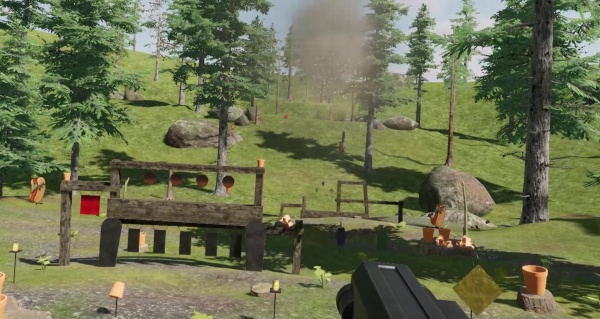
Of note is that each Remote Missile Launcher can only track one missile at a time; to keep this from becoming an issue if multiple were fired in succession, pulling the trigger with a missile in flight detonates it mid-air. This also has other uses; unlike the Nikita on which it was based, the RML's warheads pack quite a punch, making them a potent option for clearing out distant groups of enemies behind cover (assuming they don't shoot it down first - enemies will target flying missiles, making them a rather useful distraction tool.
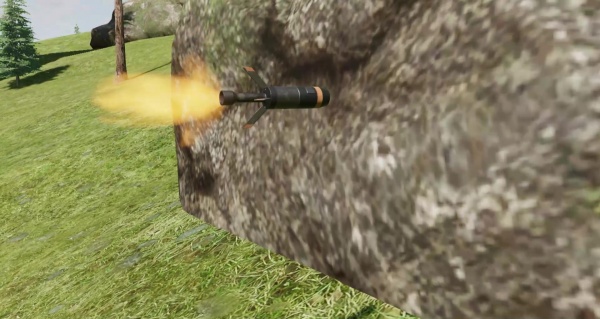
A missile in flight (mere moments from this not being the case), showing off the deployed stabilization fins. This shot was achieved by firing the launcher, dropping it, and running ahead to the missile's intended destination; the missiles are
that slow.
RG-6
The RG-6 grenade launcher was added on day 21 of the Meatmas 2020 Advent Calendar event .
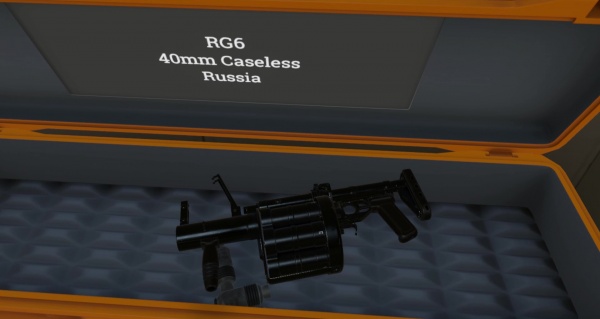
The RG-6 in its gift box, along with 3 HE grenades; since these are placed in a way that they don't really fit, things tend to fly around once the box is opened.
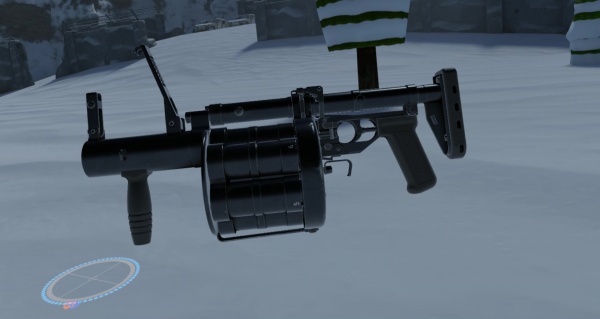
Taking the launcher outside the bunker, for a better look at -
'
"Huh, was that always there? I could've sworn that outpost used to be smaller..."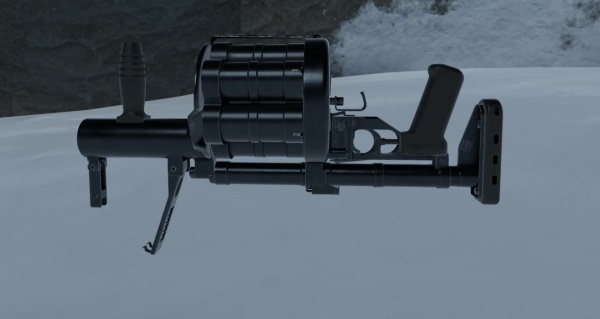
"Hang on, lemme turn around and make sure I'm not just at the wrong... bunker..." 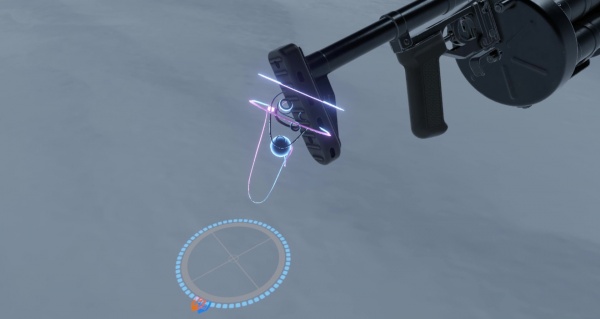
"Alright, nevermind, let's just focus on the gun. Here's the stock, which you can retract or extend, and - what's that thing on my wrist?" 
"Okay, not sure what's going on right now, but I should probably just crack this thing... no, wait that's how it's supposed to work."
"...right?" 
Loading in some grenades; the chambers are rifled, because the "barrel" isn't. Which is totally normal for this thing. Definitely. Just working how it's supposed to, like everything else here. Yep, everything's fine...
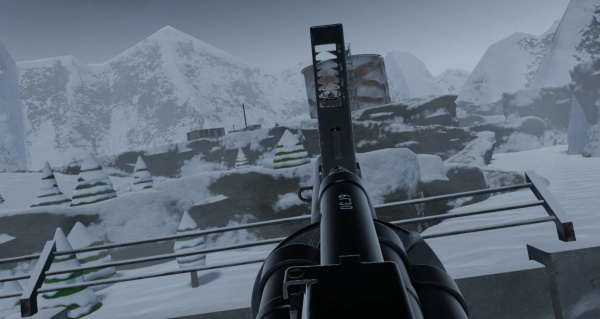
Aiming at the distant tube-structure-thing, and noting the
complete lack of drones where are they they're supposed to be here WHERE ARE THE DRONES markings on the rear sight; they're marked every 100 meters, with a notch every 50 - here, the 150-meter notch is being used. The marking on the top of the launcher reads "6G30", the weapon's GRAU index designation.
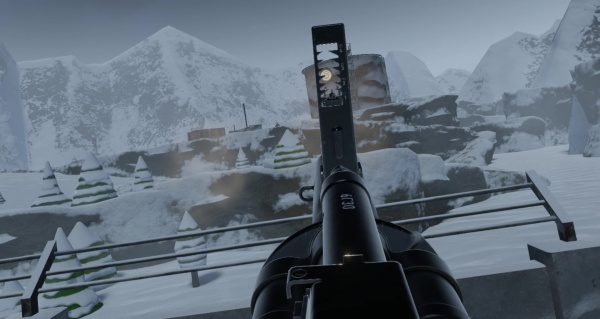
Firing a grenade off at the structure - even if there's no obvious target, firing random grenades can sometimes be helpful to cluster together, and possibly destroy, the sound-sensitive Static
they're gone they're gone they're gone they're gone they're gone they're-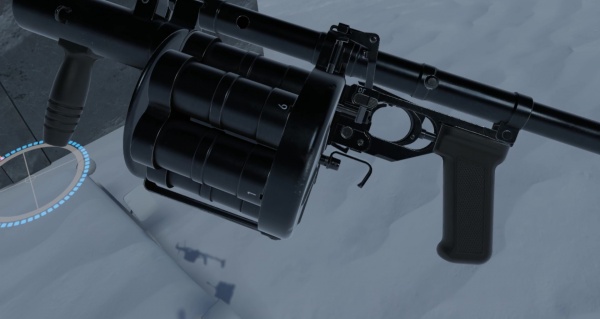
Looking away from the distant scenery, and towards the launcher itself; note the impressively complex modeling of the lockwork, with several distinct components that all move as the trigger is pulled.

Realizing that blindly firing off into the <empty> distance is probably not a very good idea, and opening up the launcher to unload it; all 6 of those grenades were definitely all there before, as none were ever fired out of it.
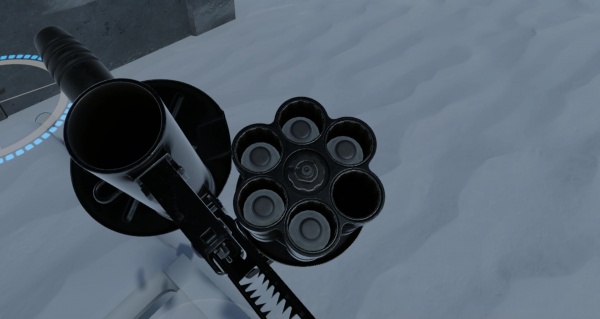
Reaching for a grenade, and looking at the launcher, wondering why you only loaded 5 grenades, it was always like this
no it wasn't the grenade is gone DON'T LISTEN TO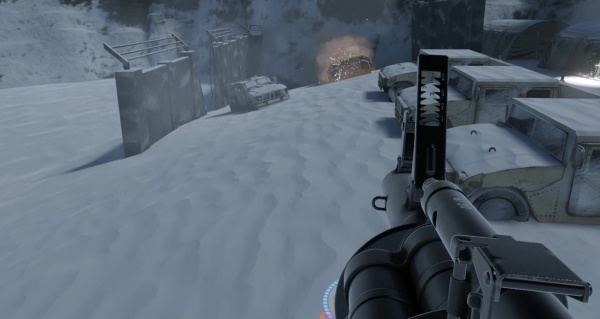
"Who is it, huh? WHO'S DOING THIS? IS IT YOU, BRADLEY? NOT ANYMORE! TAKE THIS, AND THIS, AND-" RGM-40 Kastet
Alongside the standard GP-25, Update #76's third alpha build added its standalone counterpart, the RGM-40 Kastet.
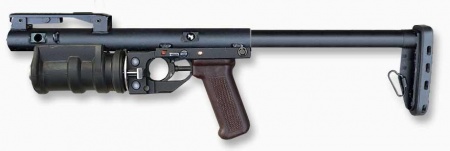
RGM-40 Kastet - 40mm VOG caseless
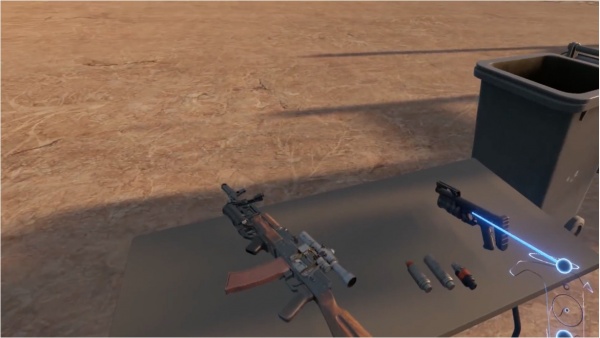
A Kastet lying on a table. Not to be confused with a Bastet; if you find the latter lying on a table, then your day is about to become either really good or really,
really bad.
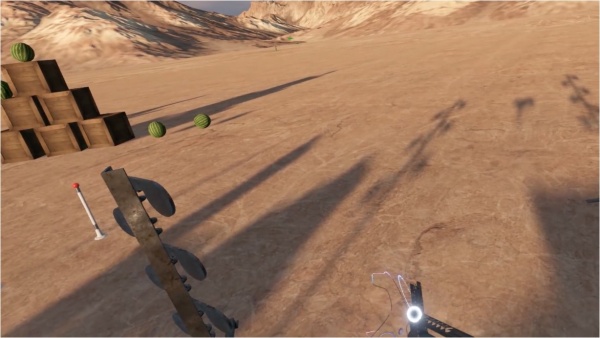
Preparing the Kastet for
ritual sacrifice practical use requires first that the sights be unfolded.
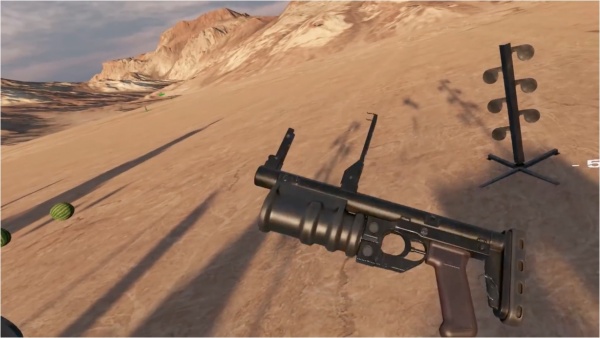
"Then... hang on, what comes next again? Lemme just check the script..." 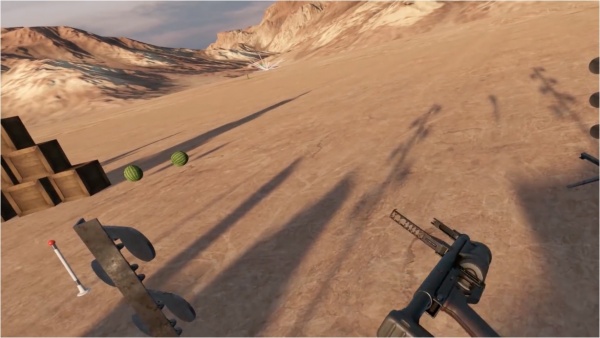
"Oh, right, that!" Then, the stock must be extended.
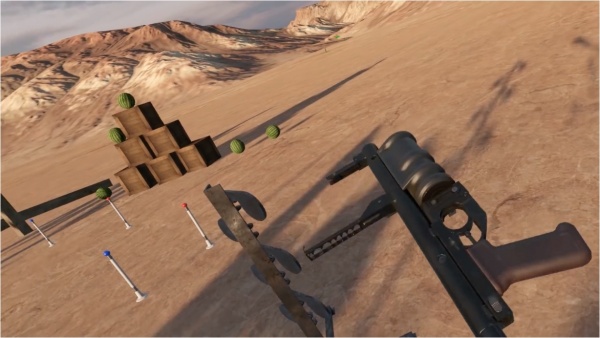
Once all that's been settled, it's time to wage war and be fertile. Preferably in that order.
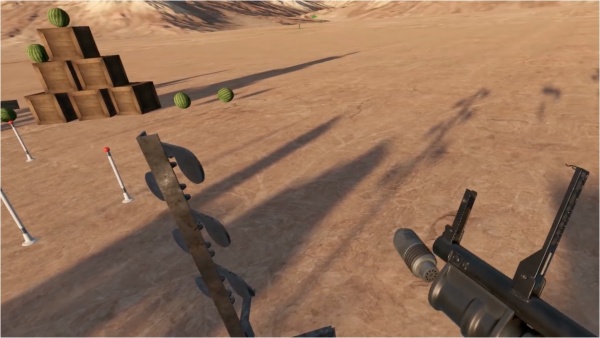
And both after remembering to load the thing.
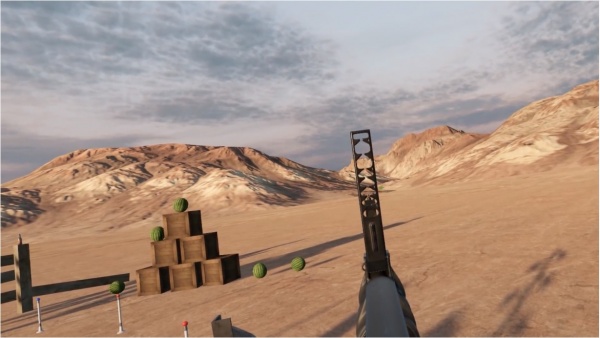
Aiming the RGM-40; each of the leaf sight's notches is approximately 50 meters, though they tend to be a bit short of the mark.
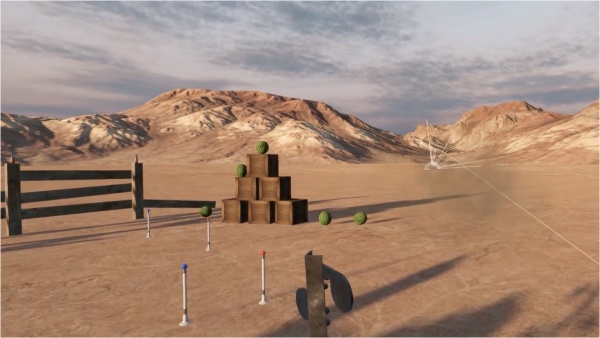
...and watching the VOG-25 HE round hit its mark.
RM Equipment M203PI
Along with the standard M203A1, Update #76's 2nd alpha build added an RM Equipment M203PI, the main distinction between the two being their compatibility; while the M203A1 can only be mounted to the M16A1 and the M4 Carbine, the M203PI can be attached to any standard Picatinny rail. The Pic rail mounted version also lacks any sight ladders for accurate long-range shooting; this is because the sight ladders on the other M203s are made specifically for AR platforms with both the launcher and sight ladder in a fixed positions.

RM Equipment M203PI - 40x46mm
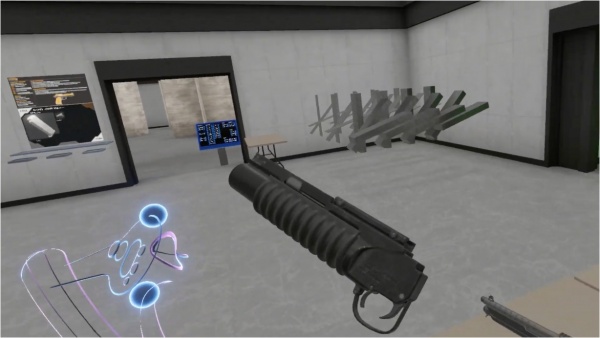
An unmounted M203PI. It's more or less the same as the normal variant, the only real difference being the mounting hardware.
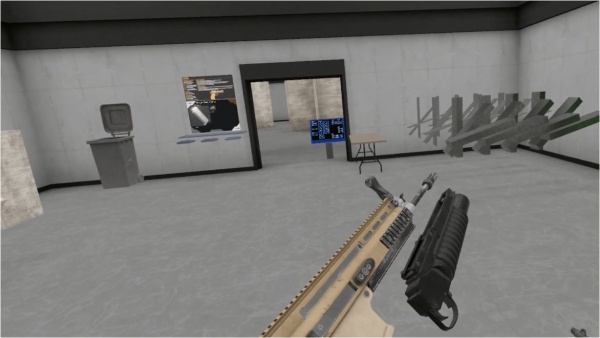
Which is, to be fair, a rather substantial difference.
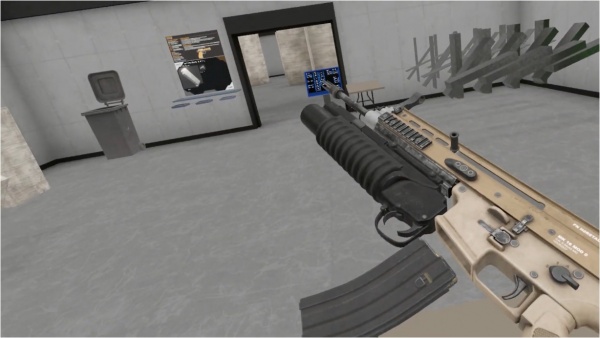
Sure, it can be used to create relatively sensible combinations like this 203/
FN SCAR-L pairing here, but it can also create far more outlandish things, like handguns with launchers on their underbarrel rails, or quad-railed rifles with an M203PI on every side of the handguard.

Loading in an M576 40mm buckshot shell...

...which, as one would expect, is quite effective at reducing enemies to a rather unsightly mess.

Dumping out the spent casing, and getting back to business.
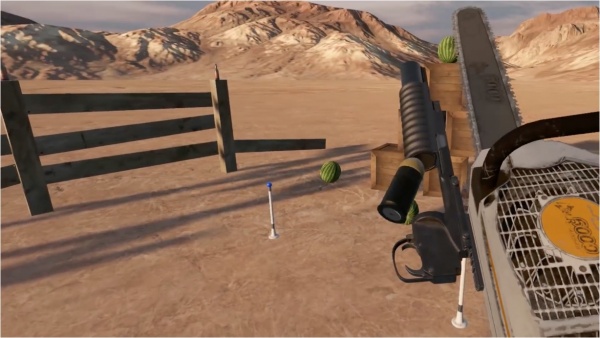
"Business", in this case, meaning "sticking another M203PI onto the bottom of a chainsaw".

Or "creating redundant, absurd monstrosities."
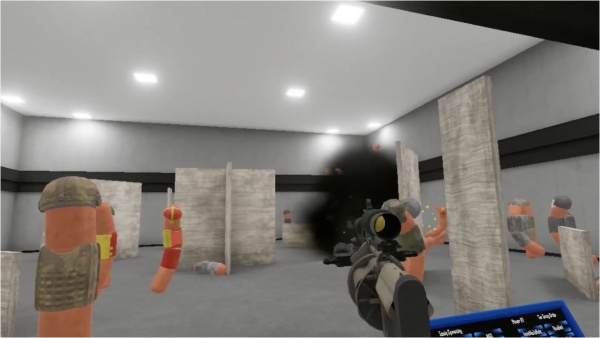
Firing all of the weapon's available grenades into a crowd of helpless Sosigs.
RPG-7
The 2016 Meatmas Update added 3 gifts on its 25th and final day, one of these being the game's first rocket launcher, the RPG-7. The sixth alpha of Update #100 replaced the RPG's model, with improvements such as working sights and a functional sight rail.
The "Meat Fortress" crossover update added the Soldier's "Rocket Launcher" from Team Fortress 2, a fictional repeating design based on a (heavily stylized) RPG-7 with its grips reversed. Initially, its ammo (the so-called "RPGMF Rocket") only had one type (a standard HE round), but Update #91 (the 2020 4th of July update) gave it several more.
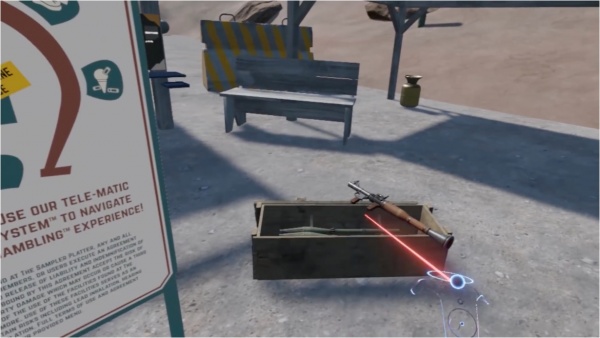
An RPG-7 and a crate full of rockets, found at the Sampler Platter's Dessert Table. It's a hard thing to find, too - you have to show up early, or else it'll all be taken by the 12:30 lunch rush.

"Yes, I
get that it's not loaded, but that doesn't mean that this isn't the single stupidest thing you have ever done."

Taking a closer look at the RPG-7, with it (thankfully) pointed in a far, far safer direction.

Loading in a PG-7V rocket.
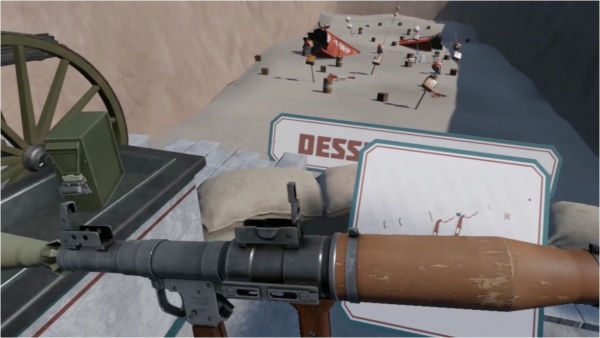
Following this is a step that a great many games tend to forget: cocking the hammer. The RPG-7 uses a revolver-style spur hammer (albeit one that strikes directly upwards) to set off its rockets; since the trigger mechanism is single-action-only, the hammer must be cocked before every shot.

"Aiming" the RPG. Well, at least there was an attempt.
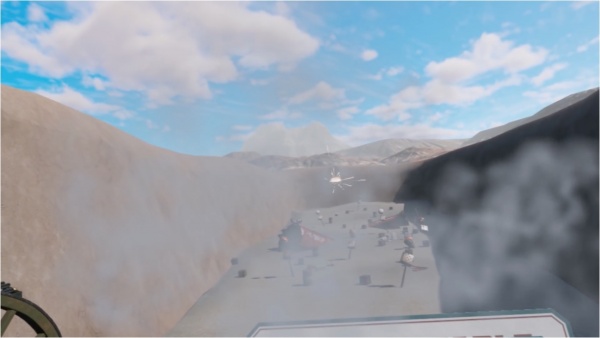
...and watching the rocket hit its mark. While it can't be shown here (for obvious reasons), one thing to note is the inclusion of a sound delay system for distant explosions - even at the back of this relatively small range, there is still a noticeable delay between seeing the round go off and hearing it, meant to simulate the difference between the speeds of light and sound. This feature, along with a great many others (including the Sampler Platter itself), was introduced in Update #52.
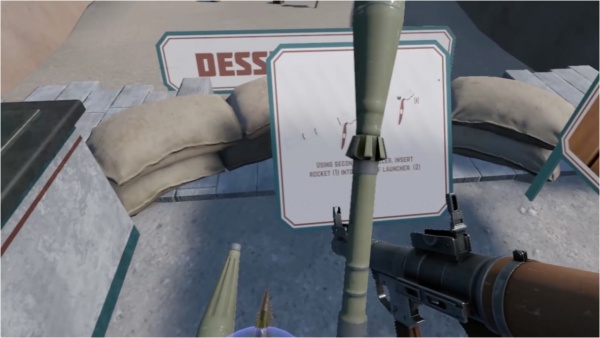
Amusingly, due to the way that
H3 defines loading (i.e. if a round intersects a certain trigger area, it is automatically loaded), simply slamming a rocket into the side of the RPG-7's main tube...

...produces a loaded rocket launcher, presumably either meaning that the rockets are capable of teleportation, or that osmosis can be performed with far larger particles than scientists previously thought. IMFDB does not encourage the practice of slamming live rockets into things; doing so outside of a video game is highly unlikely to end well.
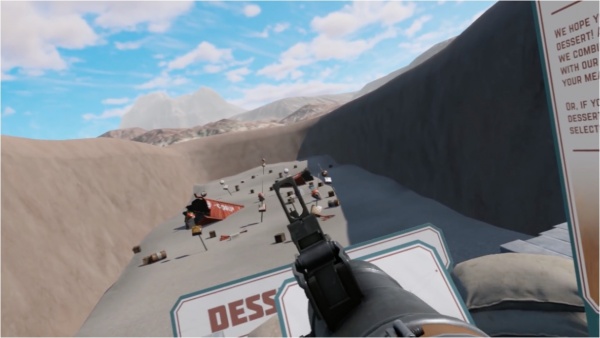
"Aiming" once again, this time at the cluster of shipping crates and explosive barrels that makes up the bulk of the Dessert Table's target content.
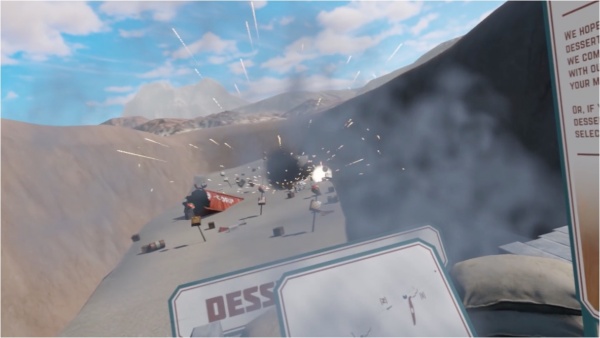
This has predictable results.
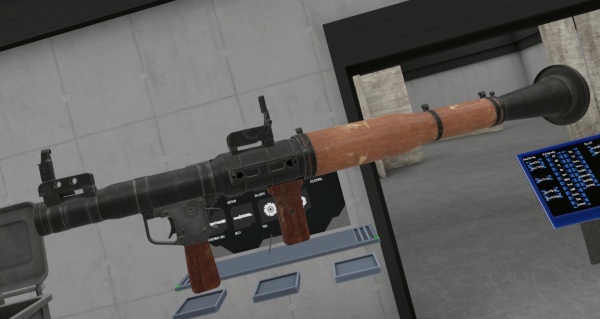
Looking over the new RPG-7.

In a substantially less sensible place to actually use it, one might add.
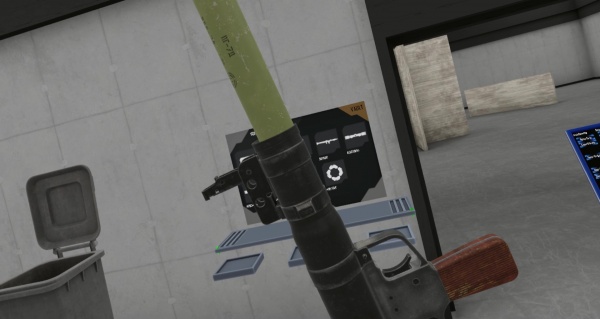
But hey, it's not like we've ever let something like common sense stop us, right?
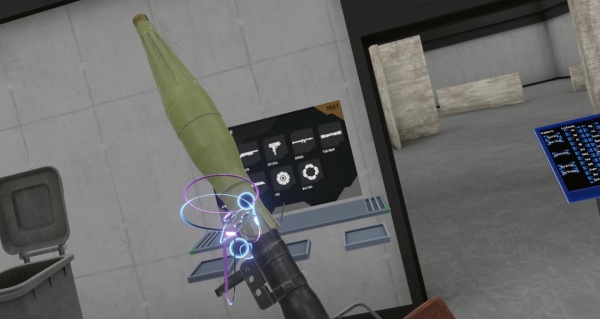
Yes, "us". You're a part of this now, whether you like it or not.

Cocking the RPG's hammer; the markings on the grip assembly state what it is ("PПГ-7", or "RPG-7"), followed by a serial number ("ИTБ-137"), and a production date ("1975г.").
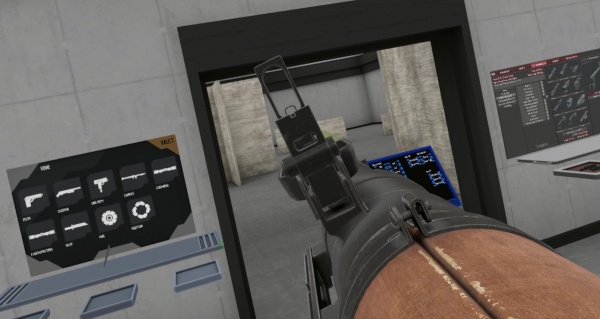
Aiming the RPG at a hopefully-far-enough-away wall; as mentioned, one of the main improvements of the new model over the old one is a functional rear sight, making it something more than just a window to look through at the front one.
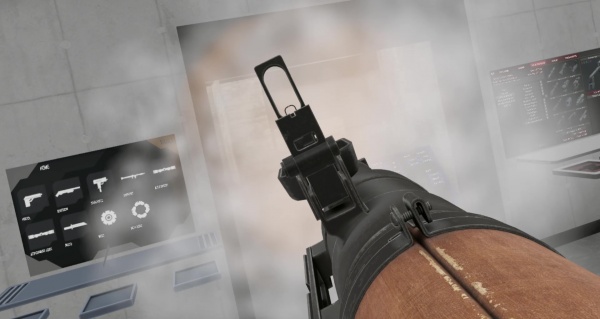
Firing the launcher, as ever, produces a brief-yet-blinding flash of light and a substantially-longer-yet-just-as-blinding cloud of smoke. It probably wouldn't obscure effect-on-target as much if the target was a more reasonable distance away.
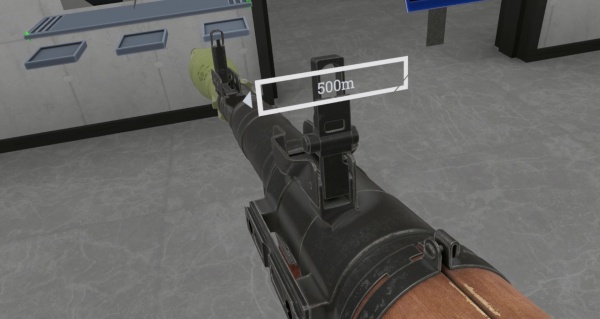
Not only is the new model's rear sight notch functional, the rest of it is too; the slider can be adjusted from 100 to 500 meters in 100-meter increments.

It also features a sixth position, which is self-explanatory in about the most literal way possible.
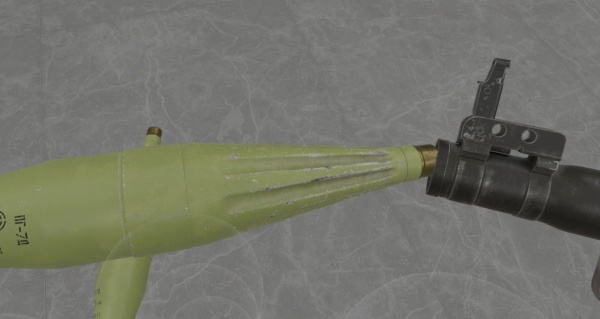
Just like the original RPG, various loading shenanigans are possible; here, the rocket (labeled as a "PG-7D", a seemingly-fictional version of the PG-7) goes in backwards...
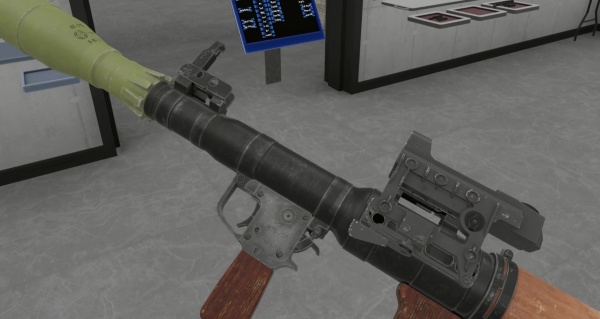
The primary utility of the flipped-down setting is to keep the rear sight out of the way when mounting optics; the rail will take any Warsaw Pact-type dovetail-mounted optic, like this somewhat unsuited-for-task Kobra RDS.
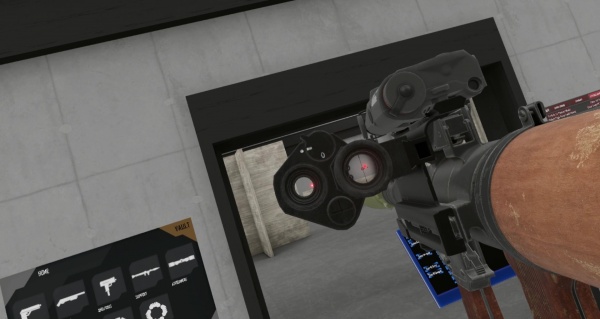
It can also take AK rail adaptors, allowing for some things well and truly past the point of forgiveness.
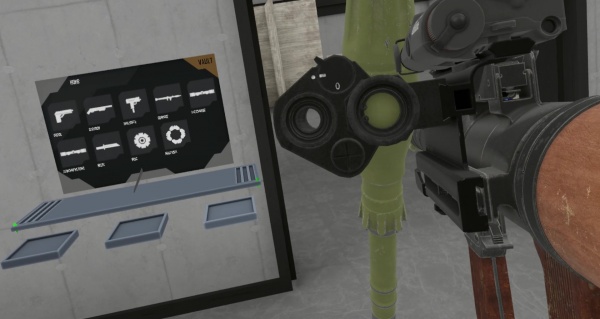
The carrying handle can also be used to carry extra rockets, though this does block the magnified portion of the optic. And forces you to put a live rocket directly in the path of the previous one's exhaust, and right next to its launch tube. Which, if it's any consolation, should at least help deal with the continued existence of this device's creator.
"Rocket Launcher"

And when we said "heavily stylized", we meant
heavily stylized.
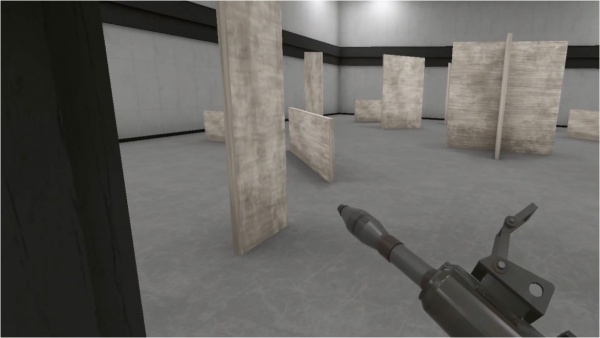
The "Rocket Launcher"'s rockets, as in
TF2, are these little gray objects that go into the muzzle...
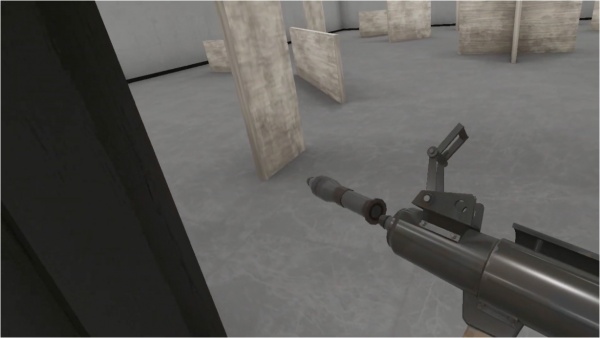
...and not necessarily one at a time. As in the source material, this launcher manages to fit 4 rockets in the tube (though, unlike the original game, loaded rockets will protrude slightly from the muzzle, as seen here); while such a thing isn't strictly
impossible, it would be a far cry from anything that could reasonably be described as "safe", and would seriously inhibit the ability of the launcher to vent propellant gases out of the exhaust port (which serves to prevent the launcher from flying backwards with each shot).
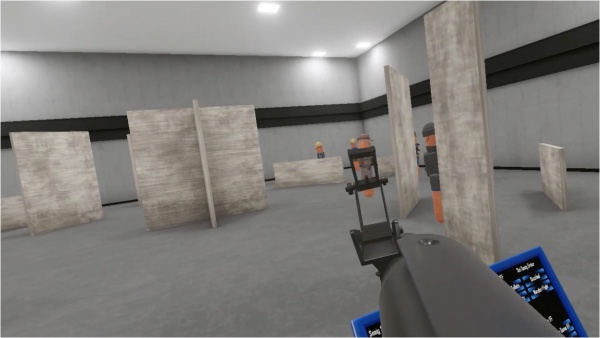
Aiming the launcher; between the wobbliness of the front sight and the lack of a rear sight to line it up with, this isn't particularly helpful at any substantive range. The former aspect is noteworthy; wobbly objects hadn't been feasible in
H3's physics engine prior, but an outside contributor going by the name "Cynicat" managed to get it working.
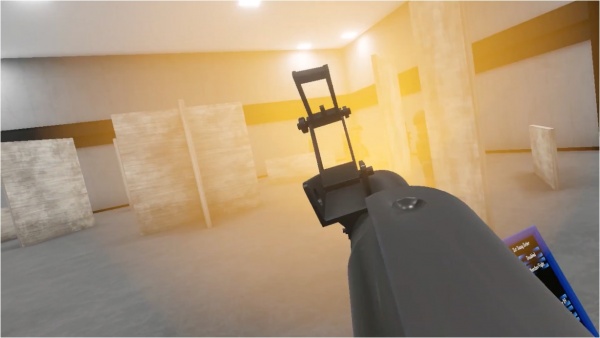
Firing a shot; the largely-obstructed tube could at least explain the weapon's rather severe vertical recoil.
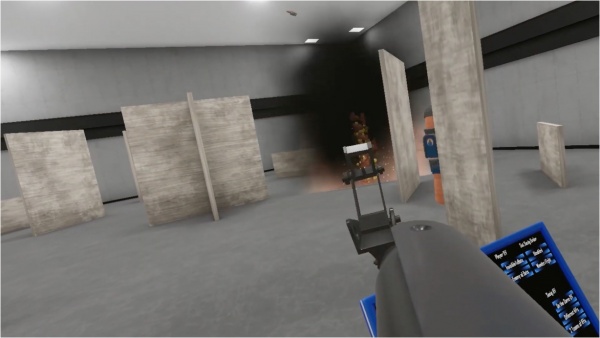
Watching the rocket hit its mark. The rockets fired by
H3's version of the launcher are noticeably more powerful than those in
TF2, frequently insta-gibbing enemies (such as this unfortunate Sniper Sosig) with a single well-placed shot.
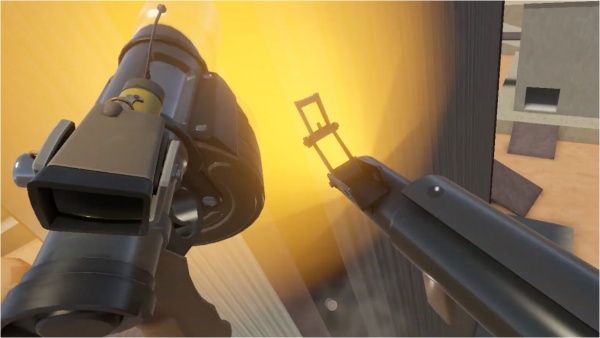
The other "proper" use of the Rocket Launcher is another mechanic inherited from its source (pun intended), the so-called "rocket jump", wherein a rocket is fired at the ground beneath/a wall next to the wielder, propelling them through the air in a spectacular, cartoonish fashion;
H3VR may very well be the first VR game in which such a thing is possible. Not recommended for those who suffer from motion sickness.
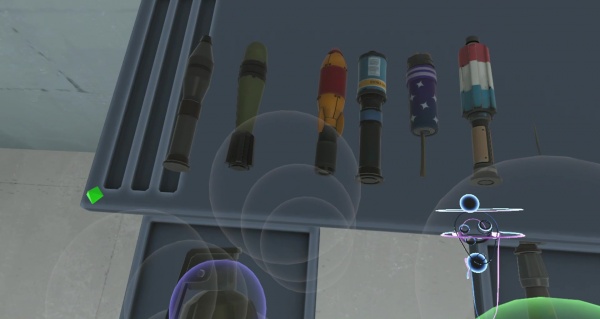
The Rocket Launcher's various ammo types laid out on a table; from left to right, there's the standard round, the "WRONG AMMO", the "To The Moon", the "Frag Explosive" (yes, that is a can of meat as a warhead), the "Rock-It", and the "Rocket Pop".
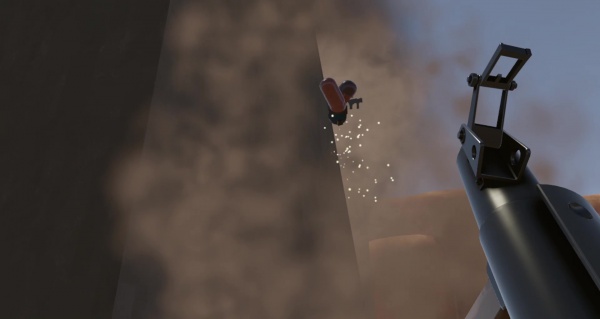
The "To The Moon" round, in keeping with its name, colorscheme, and being based on 1950s sci-fi rockets, is a high-velocity less-lethal round meant exclusively for rocket jumping (similar in function to
TF2's "Rocket Jumper", but as a round instead of a separate weapon); since there's no real way to show it in its intended role without being redundant, here's a shot of it completely failing to damage a Sosig instead. A Sosig who is, for whatever reason, stuck to a wall.

The "Rocket Pop" round, aside from bringing back memories of chasing the ice cream truck down the street (how simple things used to be), also temporarily freezes enemies within a given radius; this makes them less vulnerable to piercing-type attacks (but more vulnerable to blunt ones), and slows down all of their functions - movement, turning, weapon-handling, and even their
AI.
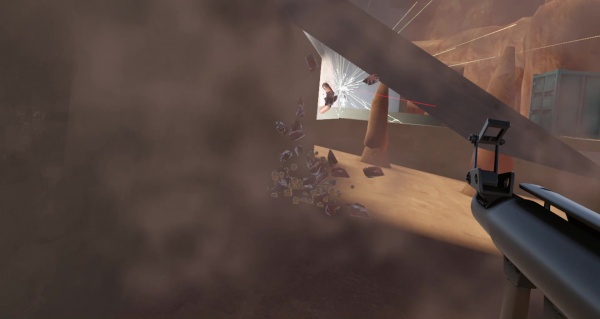
The frag rocket, as the now-enabled bullet trails show, does pretty much exactly what it says on the can - well, not exactly what it says on the actual can, since that would imply it contains Penn's Prime Meats and Cuts, but you get the idea.

The "Rock-It", meanwhile, is a little less obvious; it serves as a directional anti-personnel round, traveling a set distance (roughly 8 meters) before exploding, sending out a burst of shrapnel in a forward-facing cone (again, the bullet trails help make this clearer), or simply exploding on contact and sending all this shrapnel into the target if its hits something beforehand. This serves to minimize collateral/self-damage in close quarters at the cost of having to be more precise with your shots and severely limiting your effective range. Still, it works better than you'd expect for what is quite literally a firework with a bunch of rocks taped to it.

And finally, there's the "WRONG AMMO", which is as hard to show off as it is to use in its intended role; being mortar shells, these fly in a ballistic arc rather than a straight line, allowing the weapon to be used for indirect fire. While the white streak that follows them is somewhat helpful, the weapon they're fired out of still has no real way of aiming like this, so actually hitting anything other than the ground is mostly down to luck.
RPzB 43/54 "Panzerschreck"
Rounding out Update #50's collection of largely-WWII-centric weaponry is the Panzerschreck. Much like the M1A1 Bazooka, reloading the weapon is a simpler process in-game than it is in reality; whereas in-game the rocket is simply stuffed into the tube and fired, in reality the rocket had to be properly lined up in the tube, and the user had to press down the pin on top of the contact box to allow electricity to be transferred to the rocket, thus allowing its ignition.
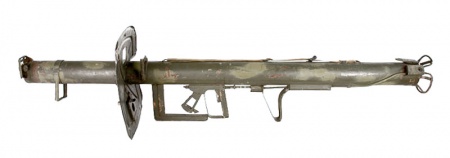
RPzB 43/54 "Panzerschreck" - 88mm rocket
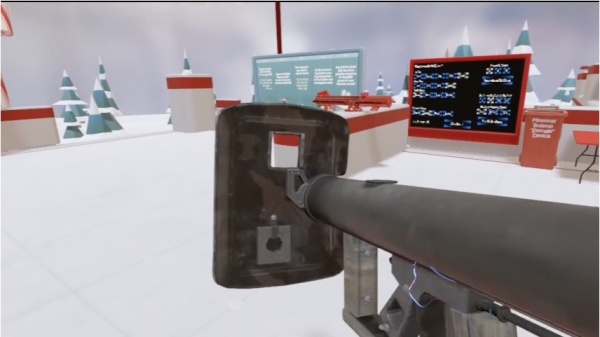
The perfect gift for that special someone in your life. Assuming that that "special someone" is trying to stop the invasion of Berlin.
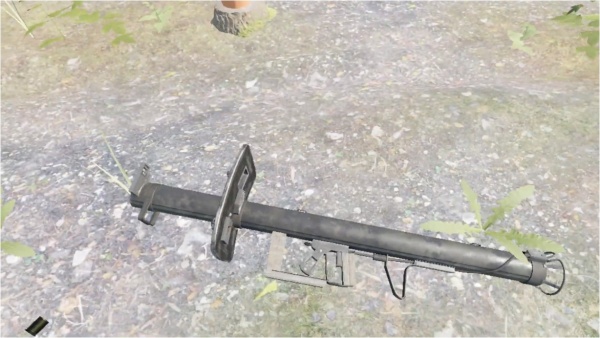
WE INTERRUPT THIS BROADCAST TO INSERT A GOVERNMENT-MANDATED SET OF SHOEHORNED-IN PROFILE SHOTS. 
DO NOT PANIC, CITIZENS; WE WILL RETURN YOU TO YOUR REGULARLY-SCHEDULED PROGRAMMING SHORTLY. 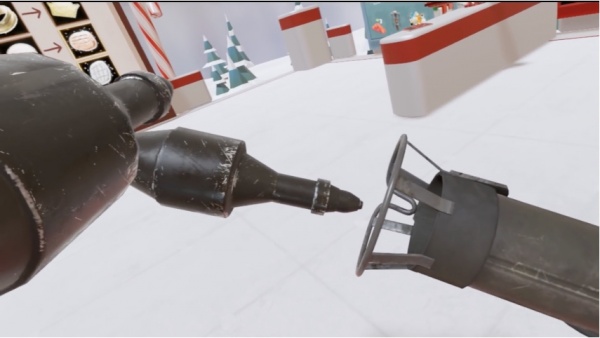
Loading in an 88mm rocket. The object to the top-left of the screen is another rocket, sitting in a quickbelt slot on the player's shoulder.
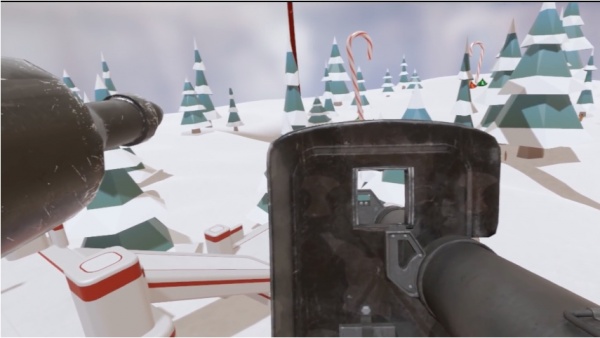
Aiming the Panzerschreck; once again, the issues with having software only capture one eye's view come to light.

Firing the Panzerschreck at a distant foe, creating a large plume of smoke in the process.
"Signaler"
Added in Update #102's first (formal) alpha, the "Signaler" is a fictional flare gun largely based on the M8 Flare Pistol, intended as an alternate weapon for the Pyro in the "Meat Fortress" gamemode. It is primarily based on one of the alternate concepts for the "Flare Gun" in TF2, itself more or less a stocked AN/M8; the in-game weapon fires 50mm flare shells, available in multiple varieties.
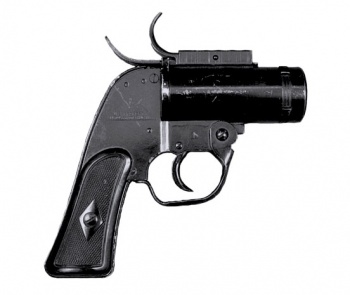
M8 Flare Pistol - 37mm flare

Examining the fancy new flare launcher.
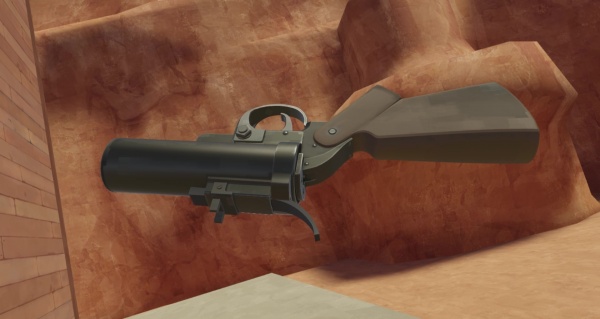
Although, at some point in the process of giving it a stock, a longer barrel, and several types of offensive ammunition, it may have crossed the line into "grenade launcher" territory.
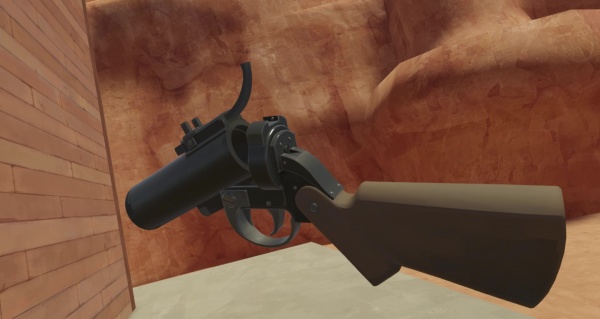
Cracking open the flarenade launcher.

Loading in a 50mm flare, of the "Classic" (i.e. "flare") variety; if this looks like a squash-and-stretched shotgun shell, that's because it more or less is.
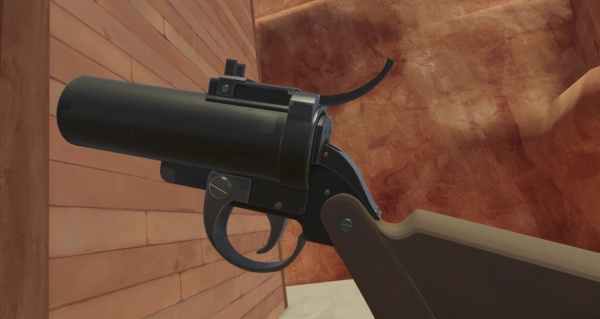
Cocking the weapon; the lever pulled back here is a breech latch on the M8, though precisely how it works on this thing isn't clear - given the linear movement, it's probably a cocking lever for an internal striker, though it being mounted on the barrel does complicate matters a bit.
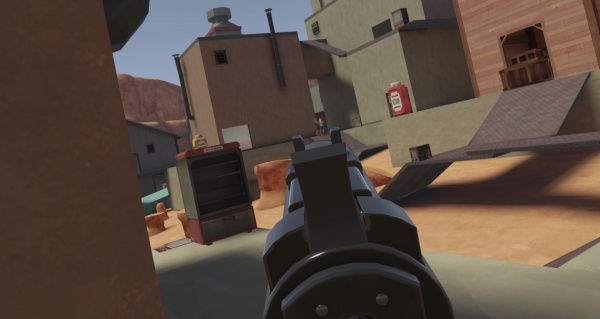
One thing's for sure, though - it's not an iron sight.
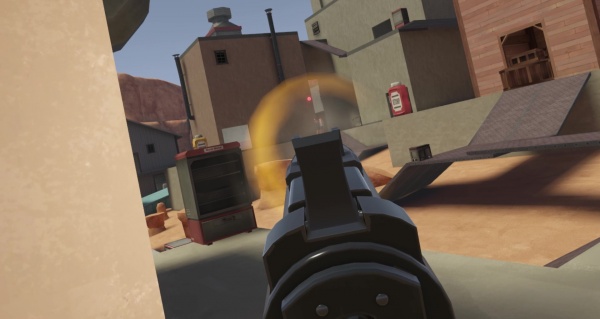
Should you attempt to use it as such, well...

...good luck. The standard flares have a bit of a blast radius, but not enough to compensate for
that.

Firing another round, this one the "Conflagration" type; the burst of tracers give off the impression that this is some sort of buckshot round at first.
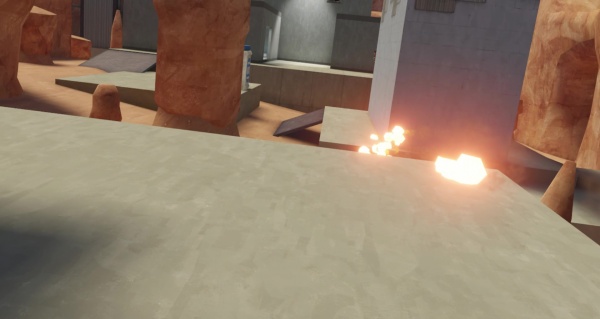
Said impression is shattered a couple frames later, however, as each tracer erupts into its own little ball of flames - it's essentially a souped-up Dragon's Breath round, minus some of the range and muzzle velocity. Useful for spy-checking, as shown here.
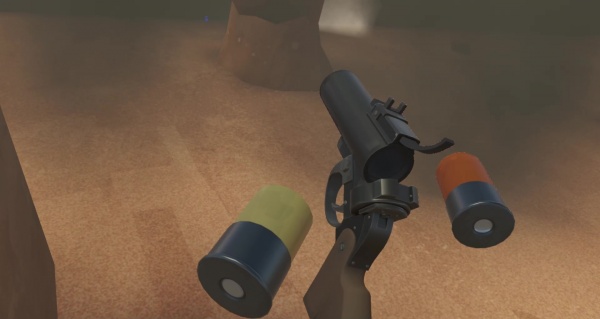
Popping open the launcher for a quick reload; note that the ejected round (like the rest of the Meat Fortress cartridges) has a struck primer. The new, yellow-hulled round is a "Sunburn" shell...
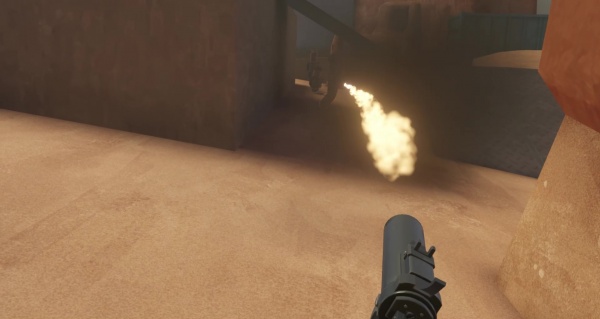
...which takes its sweet time getting to the point. Despite this, it doesn't simply arc like a rainbow and drop to the ground; it appears to be a "parachute"-type flare, meant to hang in the air as long as possible.
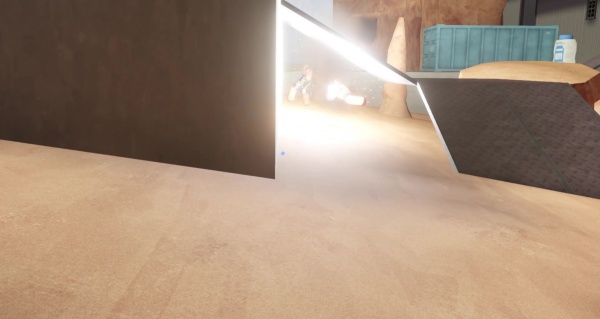
Once it finally stops doing so, the round detonates; it functions as a flashbang.

The last of the Signaler's rounds is the only one that lets the weapon live up to its name: the bright-green "Danger Close" round.
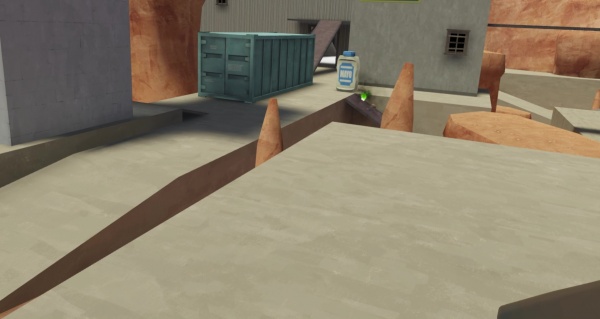
Firing one off at an unsuspecting enemy sentry gun; upon reaching its destination, the flare acts like one would logically expect a flare to act, right down to its tendency to bounce off of things and roll around. Not exactly the most helpful thing, considering what happens next.
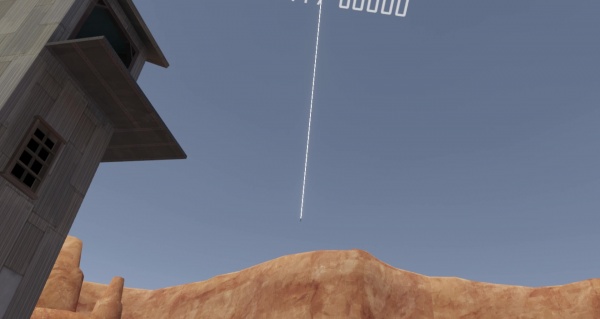
"Next" being "a couple seconds later", that is - a mortar shell descends from the heavens, right on the flare's location (at the time of launch, of course). As a note of trivia, this mortar round is technically a rocket - it uses the same projectile type as the Rocket Launcher's "WRONG AMMO" round.
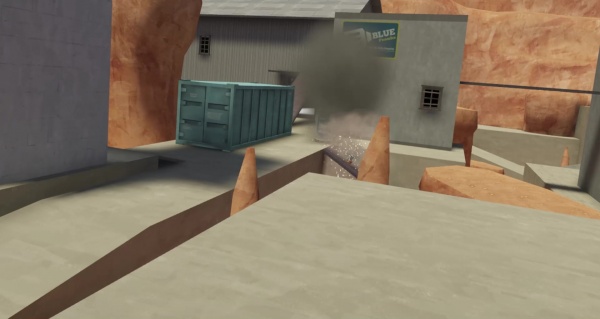
Good effect on target. Which is not something to take for granted - the omniscient mortar crew may be fast, but they aren't perfectly accurate, so some near-misses can occur.
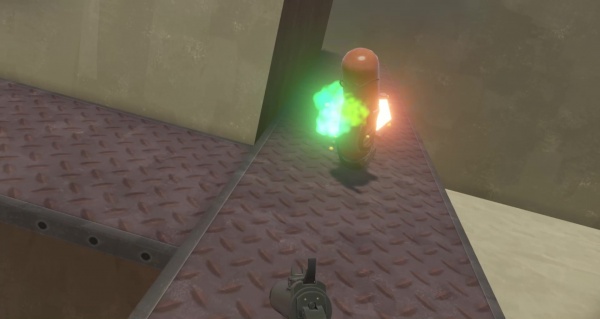
A fact which only adds to the reasons why
this is a sight to run away from very, very fast. Another reason being that the flare itself isn't particularly effective against enemies - meaning that, between the incoming mortar shell and the now-merely-angrier enemy, there are two distinct forms of "danger close" at play.
"Stickybomb Launcher"
Another weapon added with the "Meat Fortress" update was the TF2 Demoman's "Stickbomb Launcher", a fictional 8-shot semi-automatic weapon that fires remotely-detonated bombs (which, as the name implies, can stick to surfaces). Visually, it seems to be loosely based on the Sten Mk V, albeit stockless, left-hand-charging, fed by a fixed drum magazine (reminiscent of an RPK's 75-round drum), and massively oversized.

Sten Mk. V - 9x19mm Parabellum
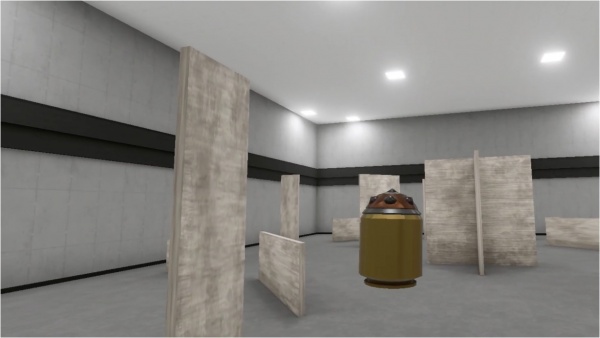
The "Stickybomb Launcher"'s ammunition (which isn't seen in
TF2, since the original version was somehow reloaded by racking the charging handle repeatedly)...

...and the launcher itself. Note the electronic device on top; this is another addition made for
H3, and was created by a community member named PieSavvy.
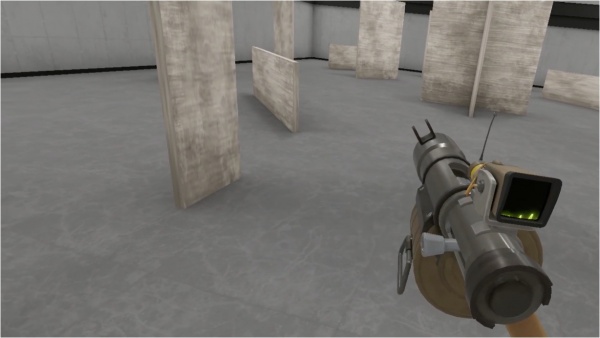
Locking open the weapon's bolt.
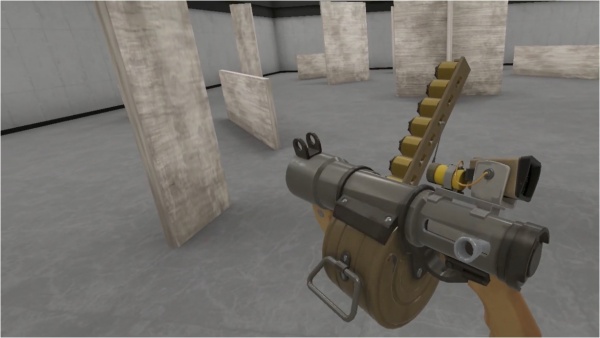
A necessary process to show off one more aspect of the launcher created for this version: its loading procedure.
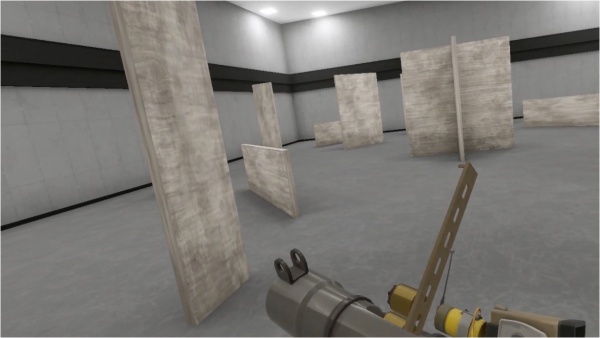
In a manner somewhat inspired by the
M1941 Johnson rifle, this variant of the Stickybomb Launcher is loaded with an 8-round stripper clip inserted through the ejection port.
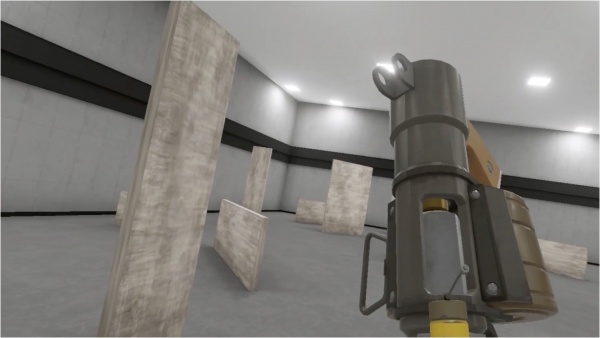
Letting the bolt drop, pushing a round out of the magazine and into the chamber.
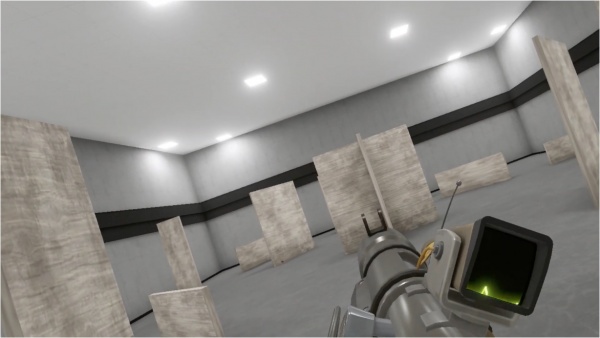
"Aiming" the launcher; since the only thing provided for this is the Mk. V Sten's empty front sight protector, it'd be more accurately described as "point-shooting".

Firing off a shot; the action closes quite quickly for its size. Also note that the projectile is bigger than the launcher's actual bore; the explanation given being that the bombs inflate upon leaving the muzzle.

An assortment of stickies laid out around the room, which help reveal the purpose of the aforementioned device: since
H3VR has no HUD to show the player how many stickybombs they've placed, the device fills that role instead, with the line rising higher on the screen for each sticky placed. With all 8 set out, there's only one thing left to do...
"The Long Shot"
Alpha 2 of Update #96 added a modified variant of the Stickybomb Launcher known as "The Long Shot", along with several new ammo types for both it and the original variant. Compared to the Stickybomb Launcher, the Long Shot is a longer weapon overall (featuring a longer barrel and a full stock), and sacrifices semi-auto functionality for increased muzzle velocity, to the point that it serves as a serviceable direct-fire weapon out to surprising ranges.
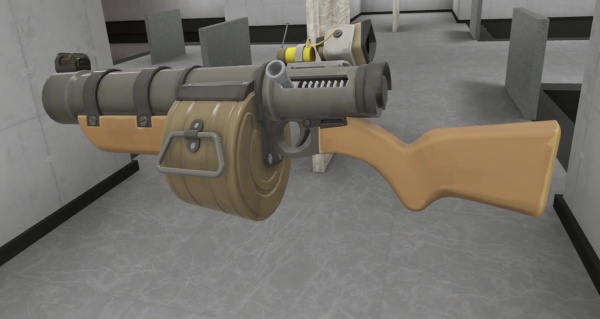
Admiring the Long Shot in the Proving Grounds' dedicated battle arena.
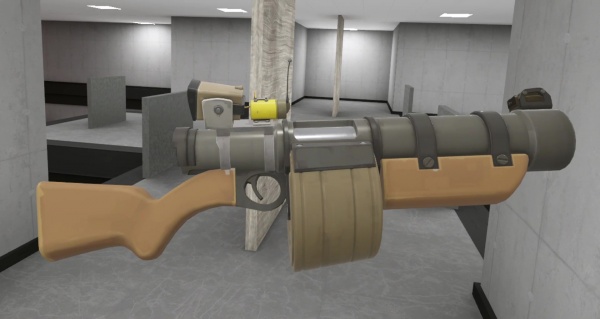
The forend and stock are similar to that of the Demo's Grenade Launcher; the device in place of the original Stickybomb Launcher's more-or-less-functionless front sight protector is a laser sight that, like some of the other Meat Fortress weapons', is always on.
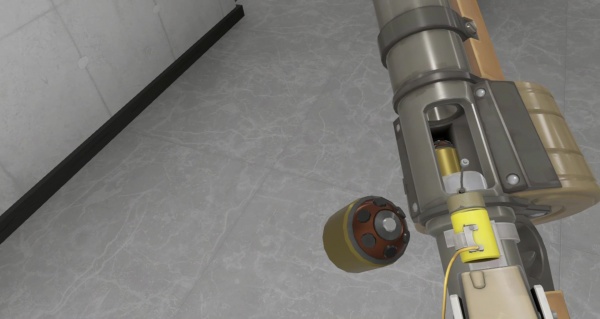
Loading in some shells; this is a "Rusty Nail" round, one of the three alternate ammo types added in the same update.
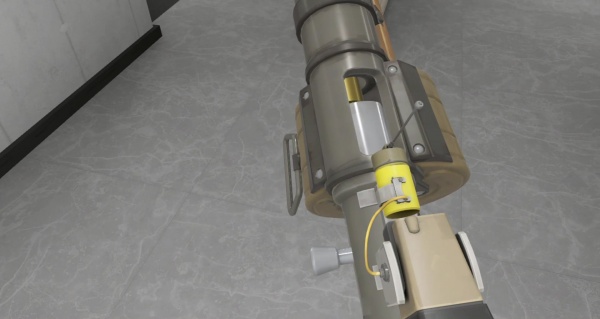
Releasing the locked-back bolt, and chambering a round. Props to whoever designed the feed ramp in this thing - getting it to feed rounds like
that reliably must've been a bona fide nightmare.
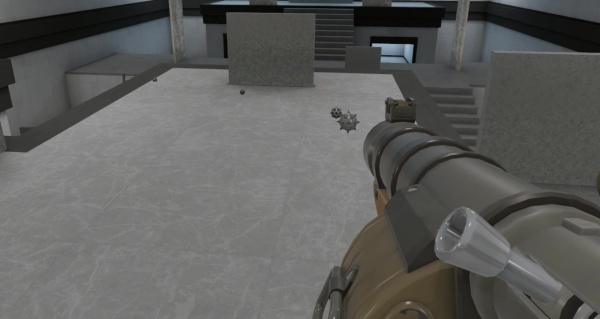
Setting down a few Rusty Nails before starting an AI battle, and showing off what appears to be an artifact of how the weapon is coded - for just the briefest of moments, two noticeably different stickybombs appear in front of the muzzle. Say, setting up stickies before the two teams even begin existing isn't cheating right?

Manually racking the charging handle; as mentioned, the Long Shot lacks semi-auto functionality, effectively tutoring it into a spring-assisted straight-pull bolt-action.
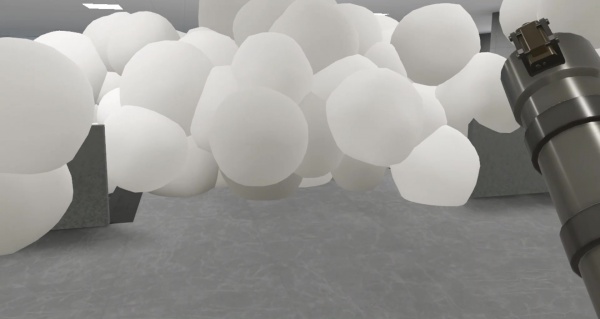
Detonating the Rusty Nail rounds all at once reveals their function: smoking like a 1950s commercial airliner cabin.
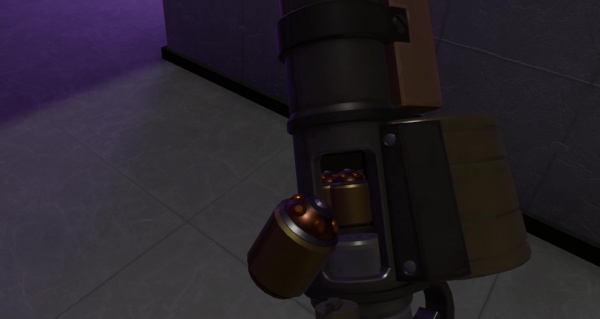
Loading up another type; in keeping with the general theme of scotch-based cocktail names, this one's called the "Robbie Burns".

Taking a less-than-quick potshot at an enemy Sosig's head...

...with predictable consequences. While decent at knocking enemies down when uncharged, the Long Shot can often kill enemies with a single fully-charged shot, a shot which has almost no drop over reasonable distances to boot.
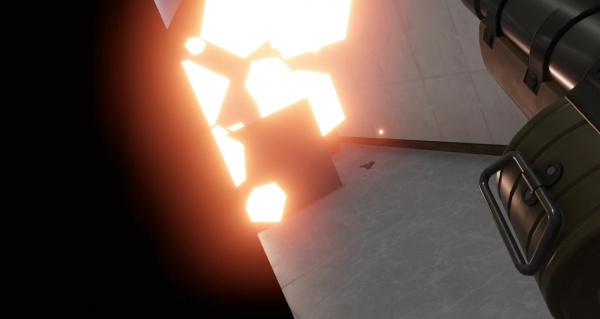
Actually detonating a few of these rounds reveals their intended function: fittingly, the Robbie Burns round is incendiary.
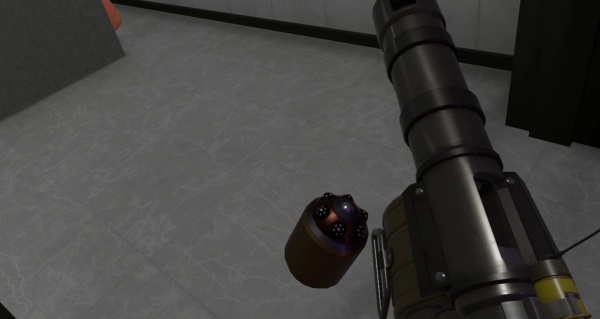
Lastly, there's the "Highland Fling".
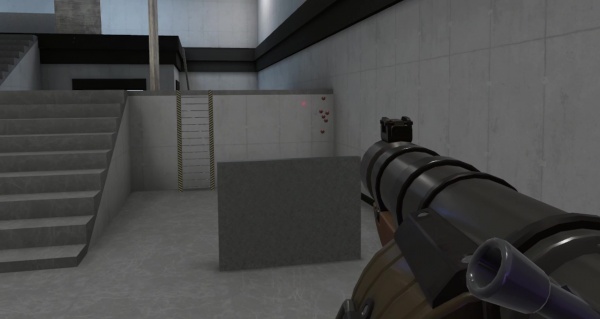
This is an explosive scatter-shot round, firing six mini-stickies per shot; this, in combination with the aforementioned high impact damage allows the Long Shot to be used as an ersatz shotgun in close quarters.
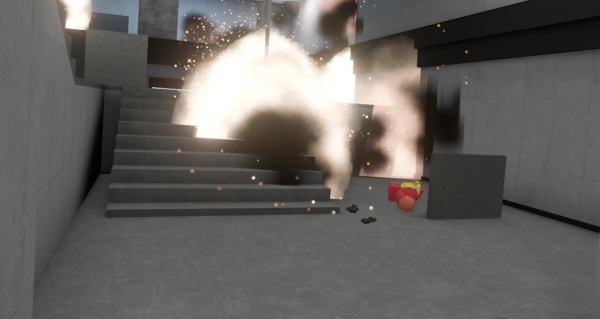
Detonating the Highland Fling rounds shows off one of their interesting properties: they aren't all fuzed quite the same, with the six submunitions exploding jut slightly out of sync with each other. Aside from looking cooler, this does provide some advantages: in particular, with mini-stickies scattered on the ground, the first blast will often knock enemies down, putting their much more vital, squishy bits right next to all of the subsequent explosions.
Sturmpistole
The final grenade launcher added in the 10th alpha of Update #52 is the Sturmpistole, a WW2-era German experiment in converting the Leuchtpistole flare gun into a grenade launcher.
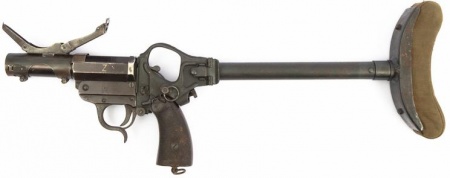
Sturmpistole - 26.65mm / 23mm
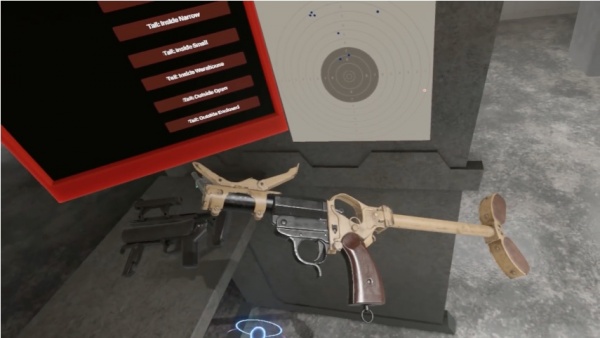
The Sturmpistole in all of its confounding glory.
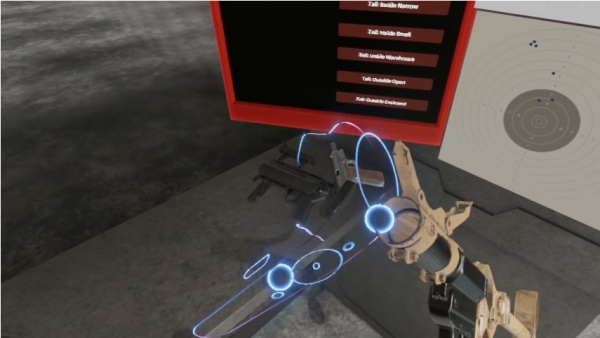
A closeup of the muzzle, which shows off the rifled bore insert.
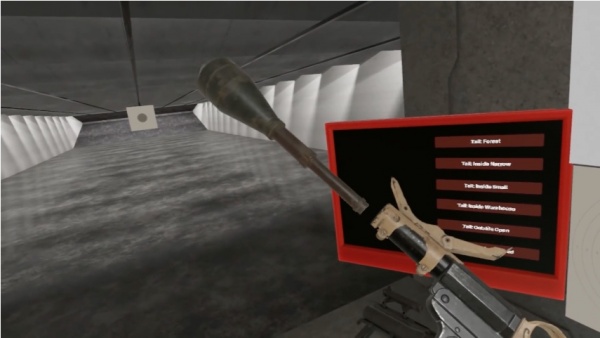
Loading a Panzerwurfkörper 42 LP grenade round into the aforementioned muzzle.

Cocking back the hammer, while trying as hard as possible to ignore how utterly ridiculous this device looks.
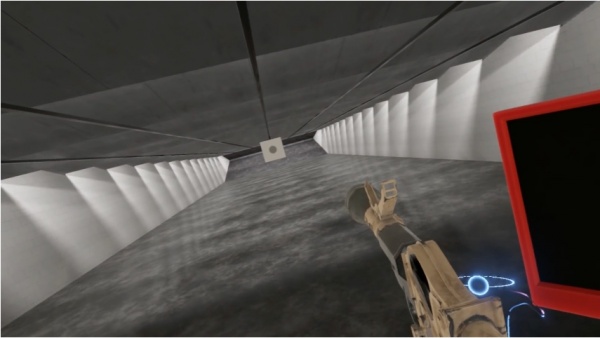
Leveling the Sturmpistole at the indoor range's back wall...

...and sending the grenade on its (rather leisurely) way.
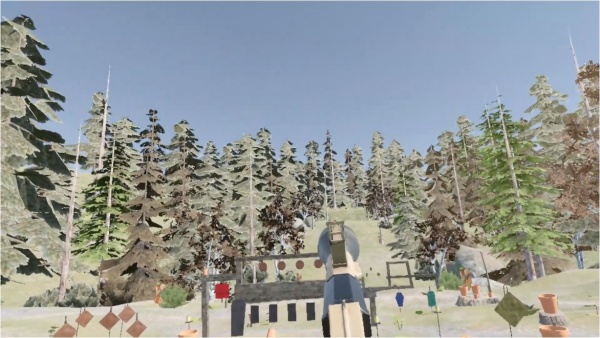
Between the grenades' low velocity and the rather small, short-radiused sights, long-range hits on point targets are quite the achievement indeed. But hey, that just makes them all the more satisfying.
















































































